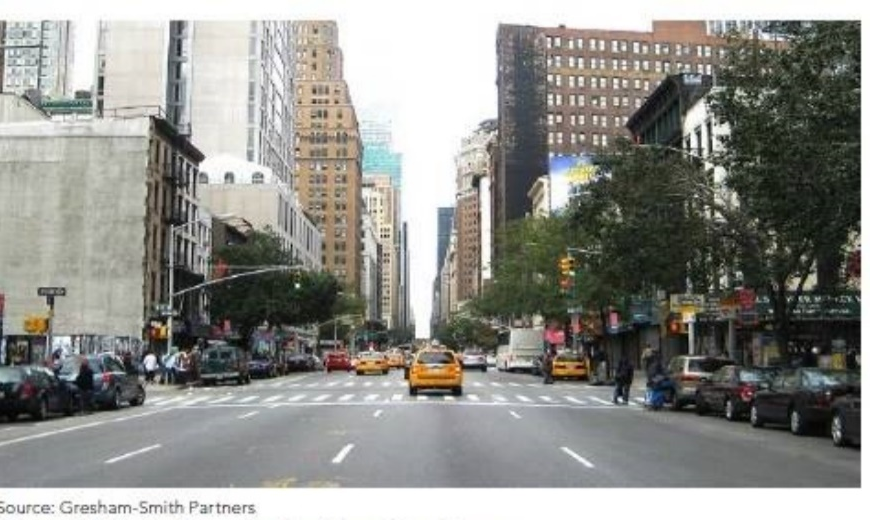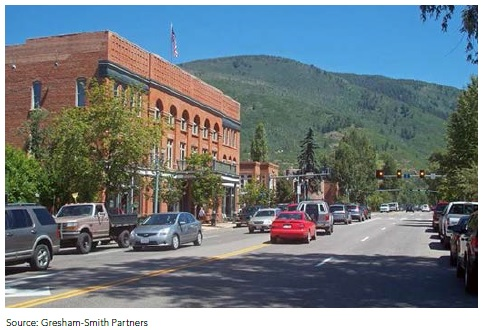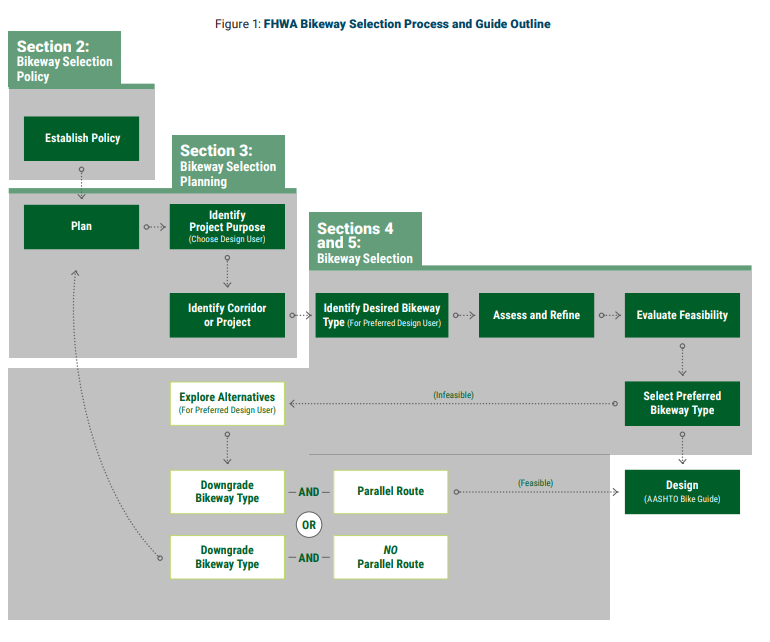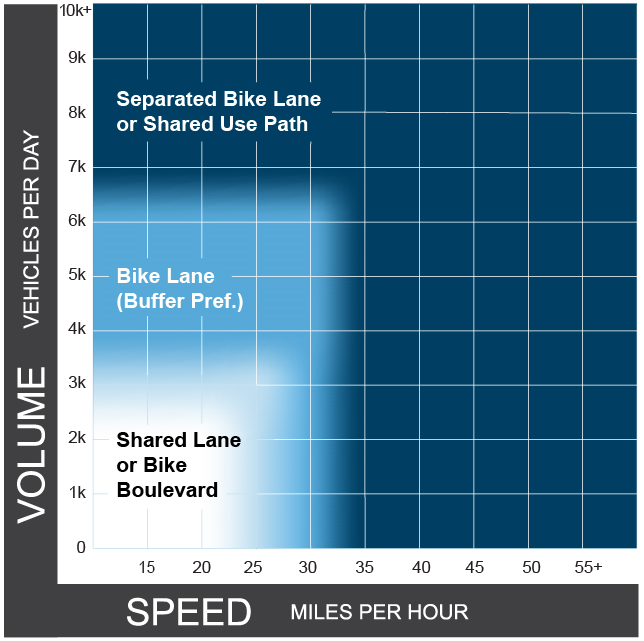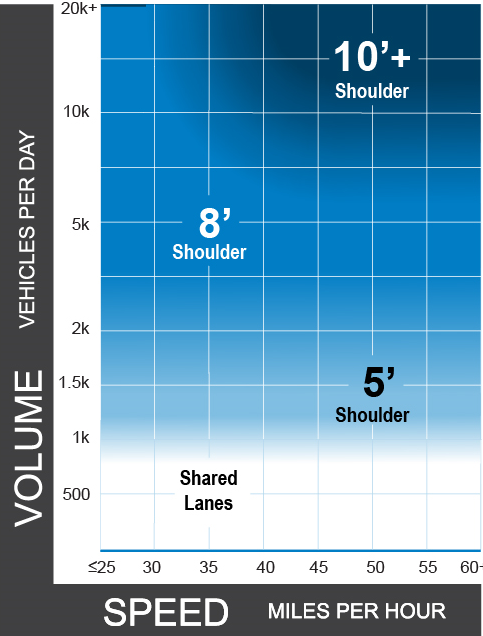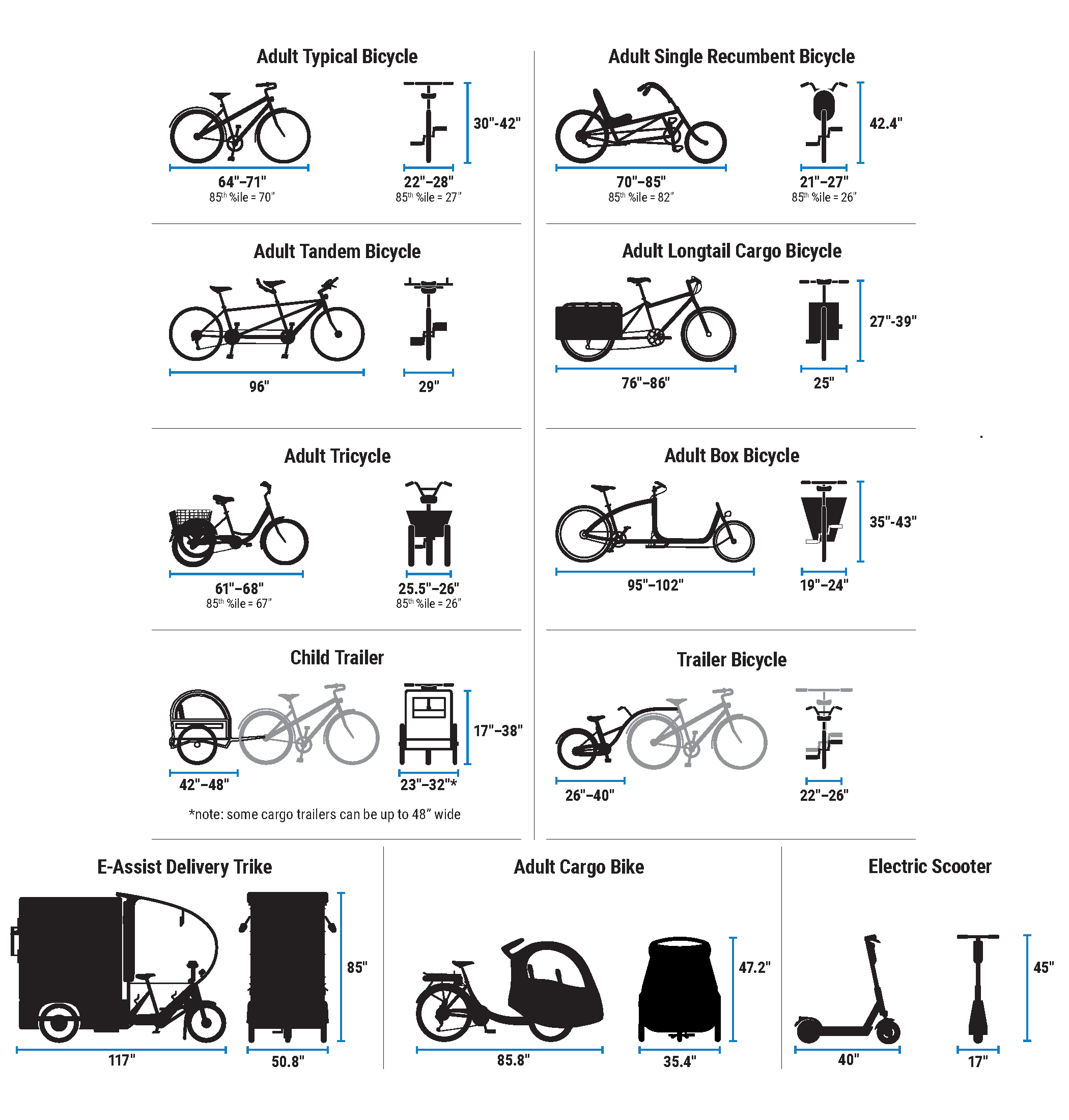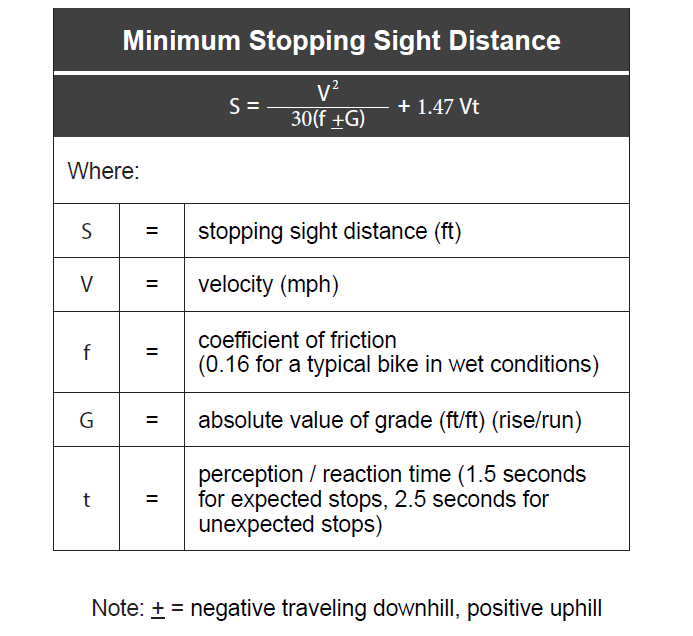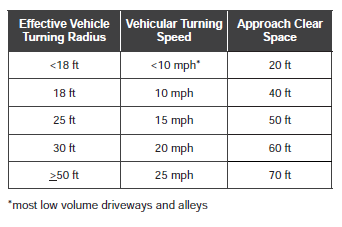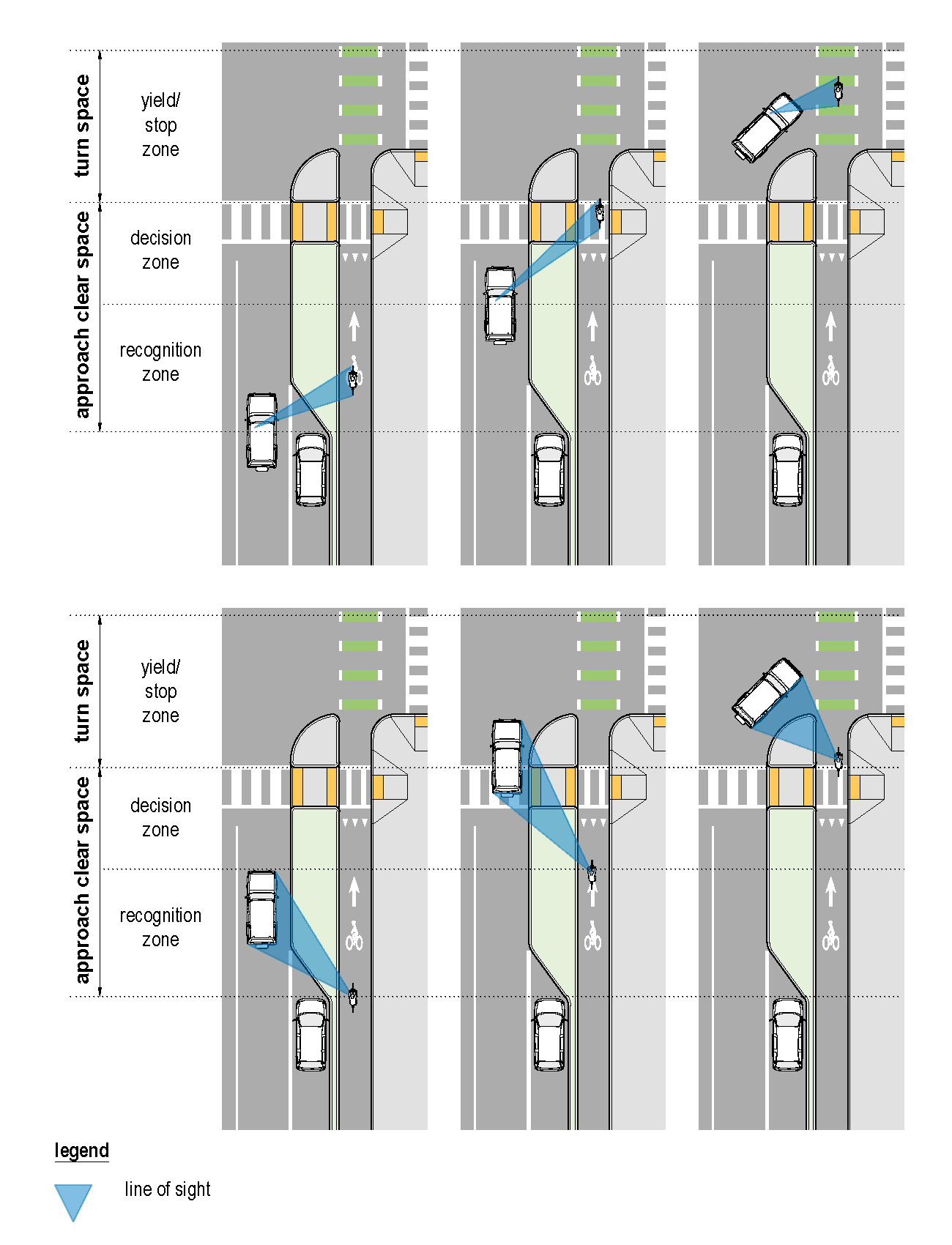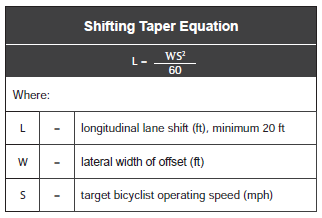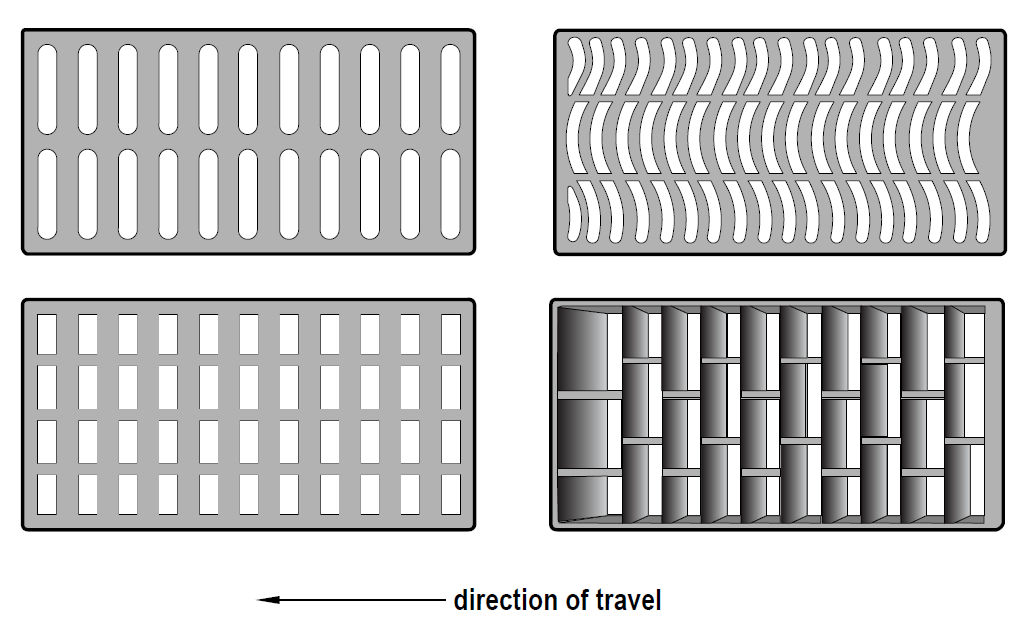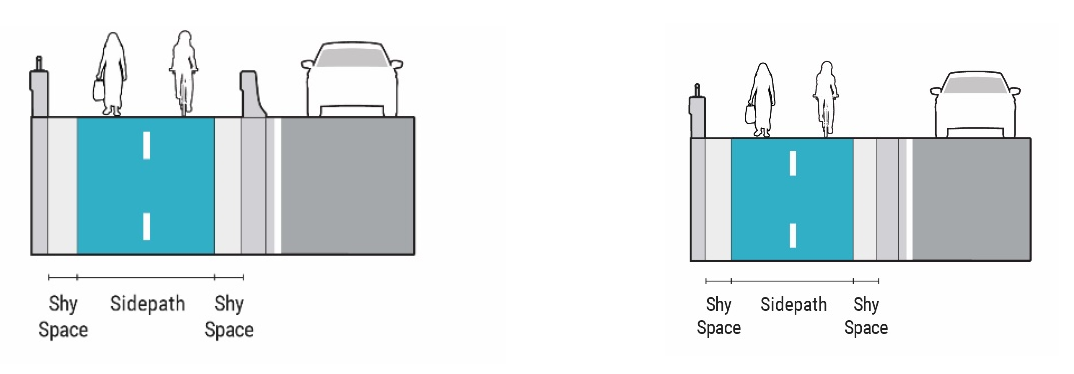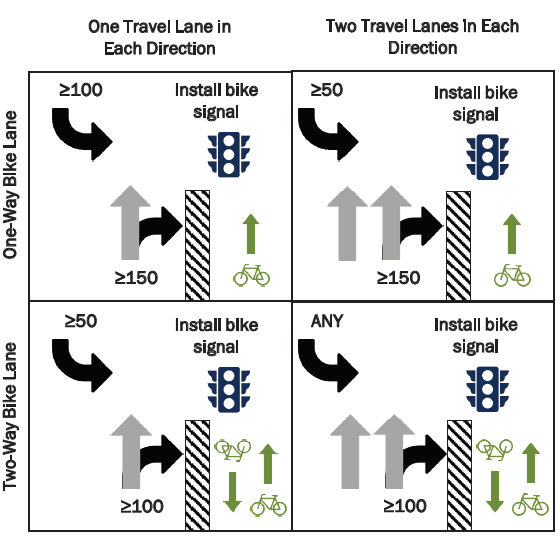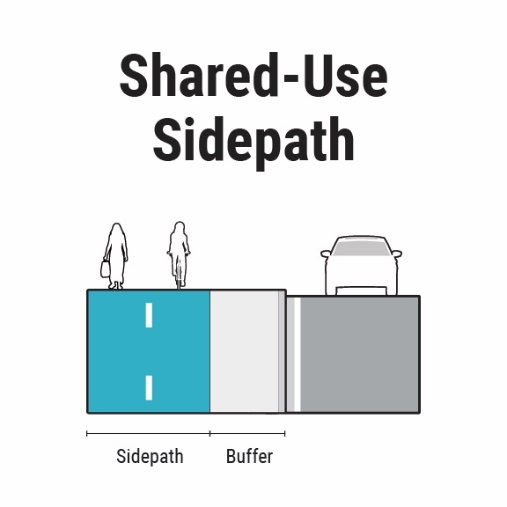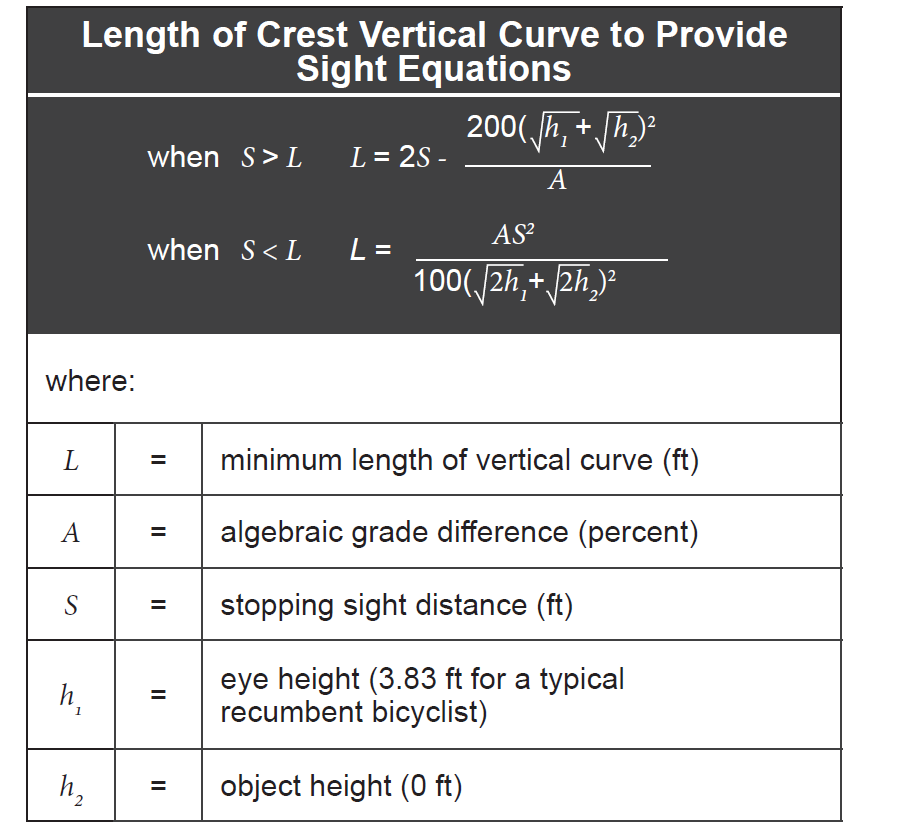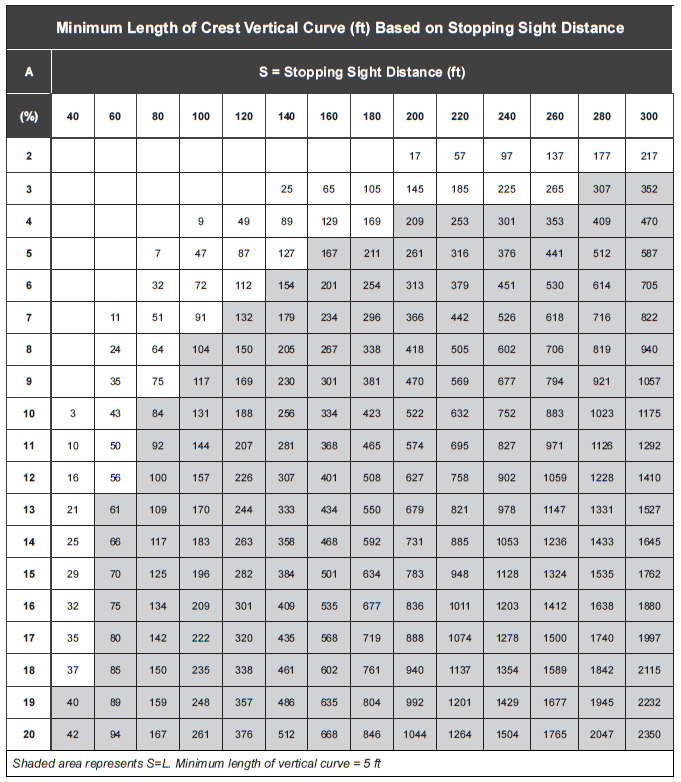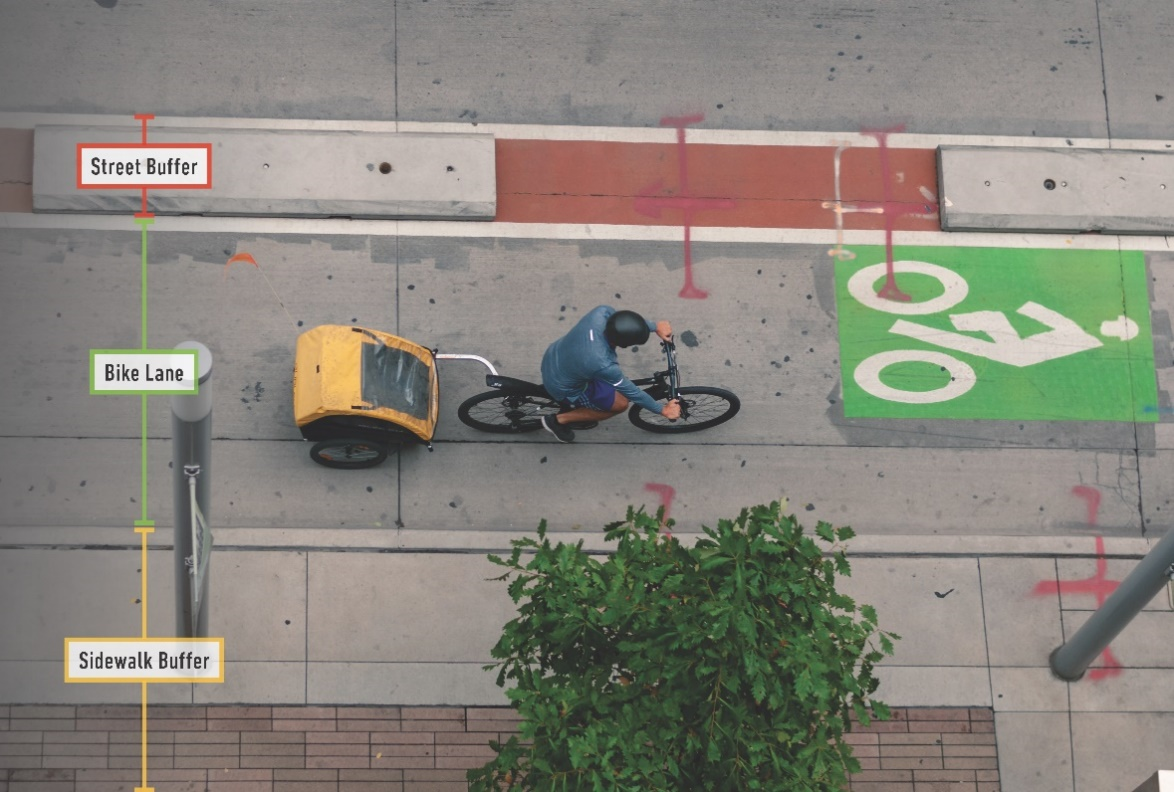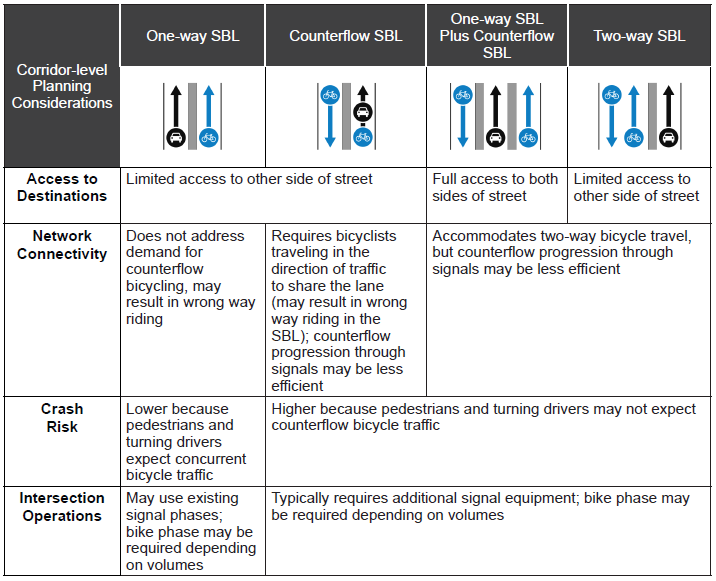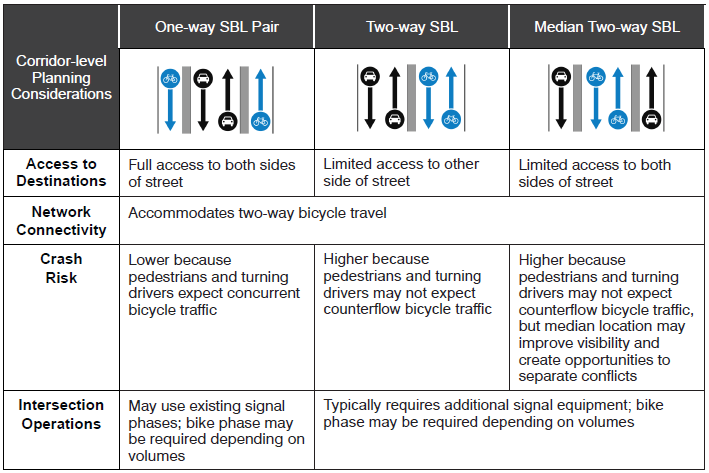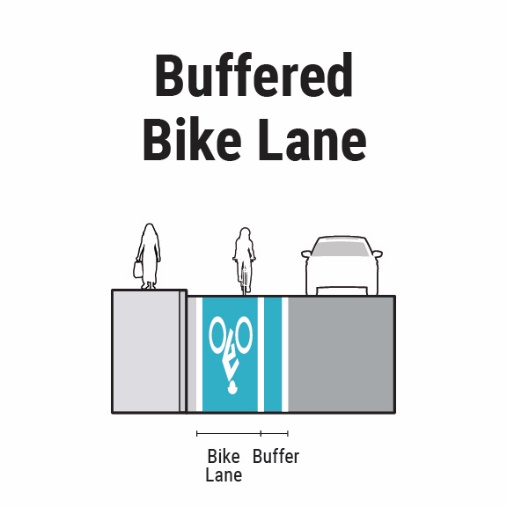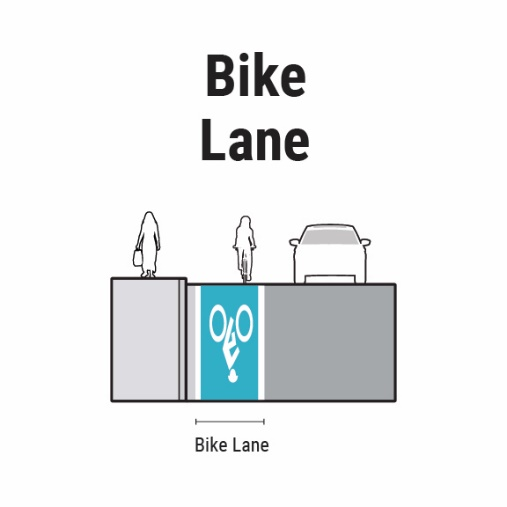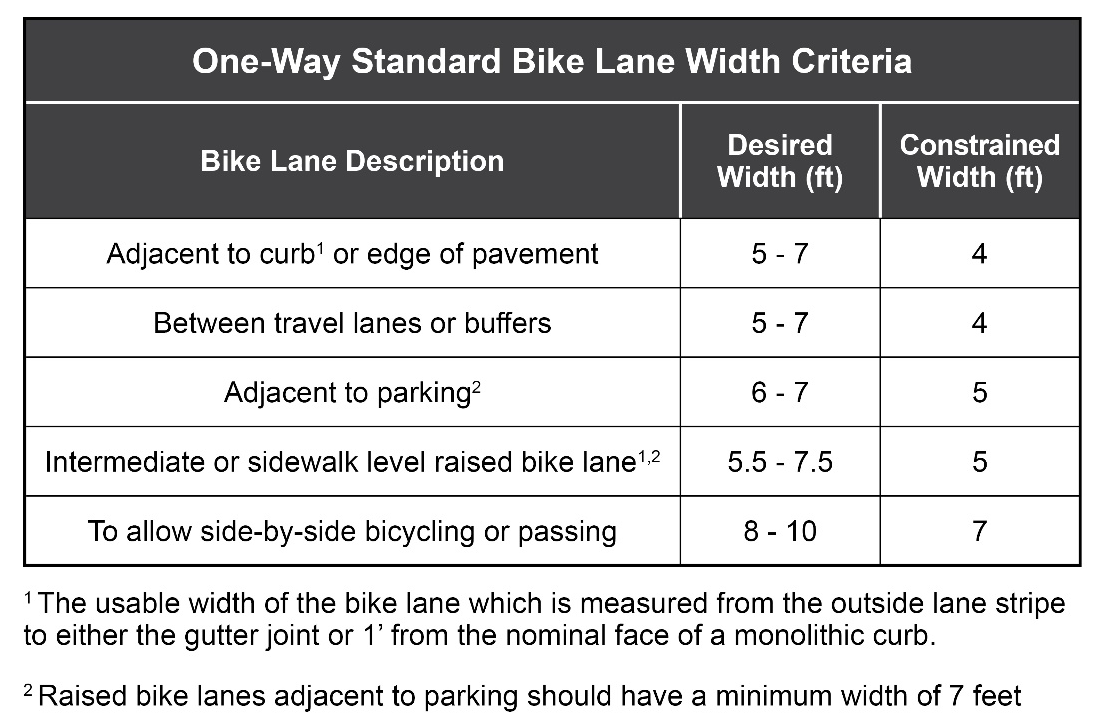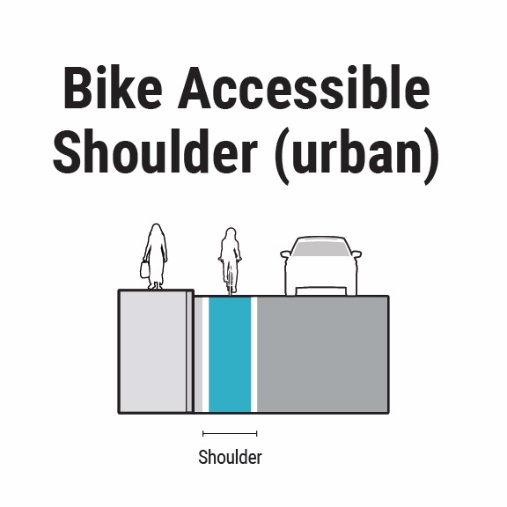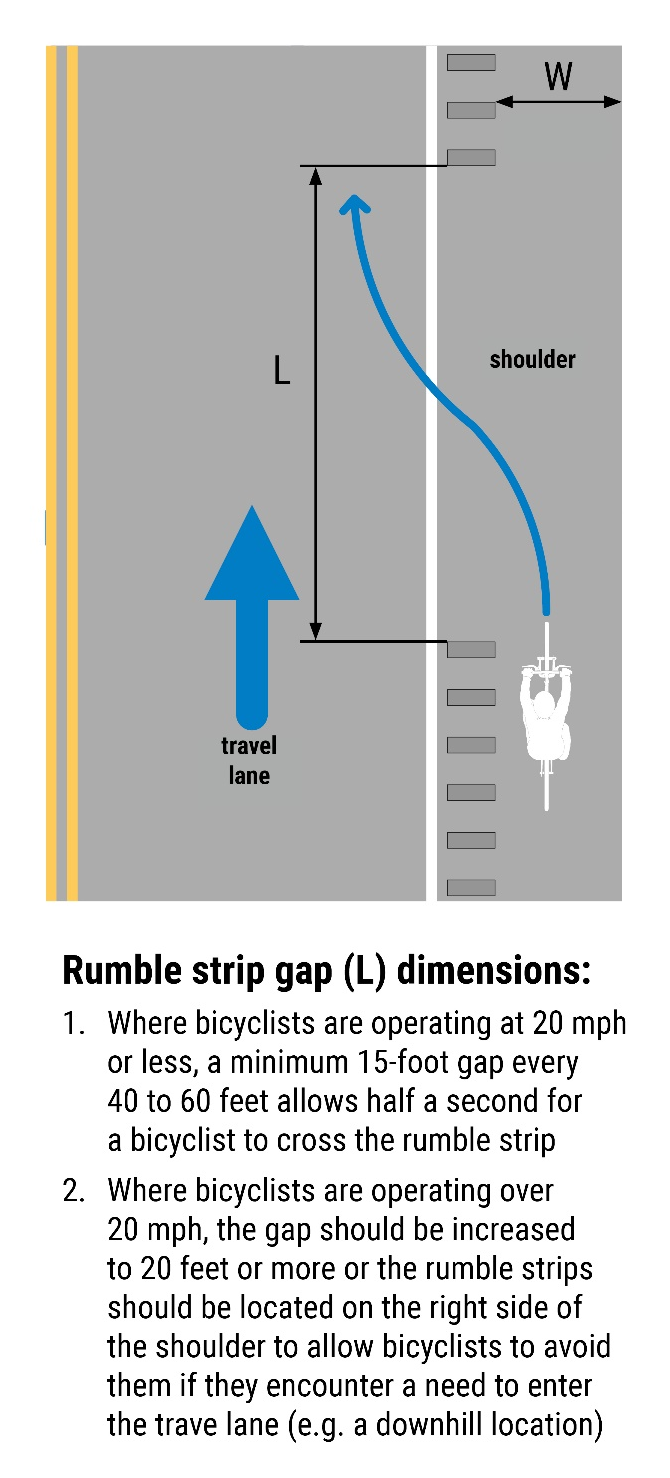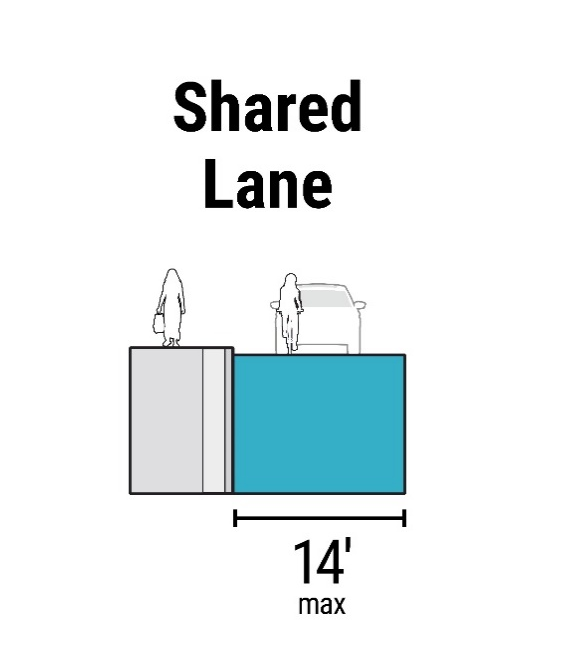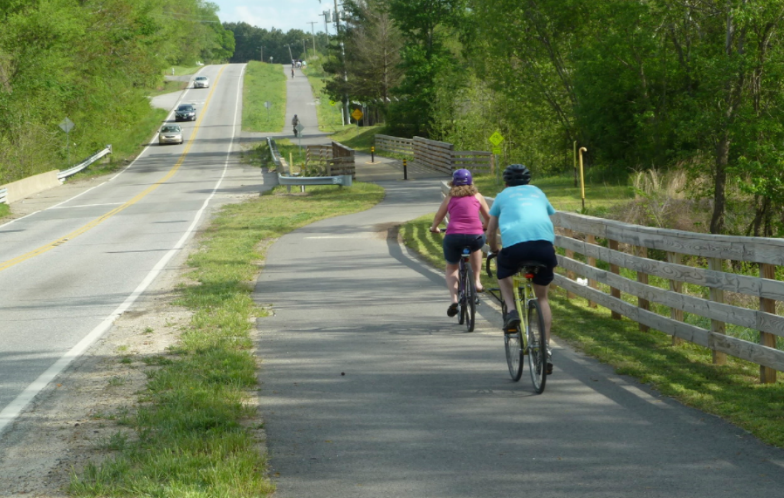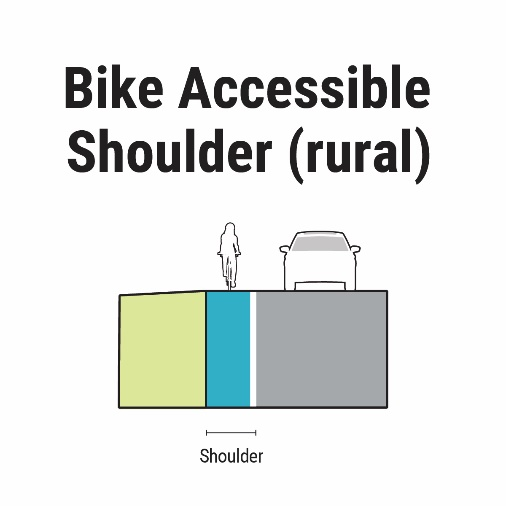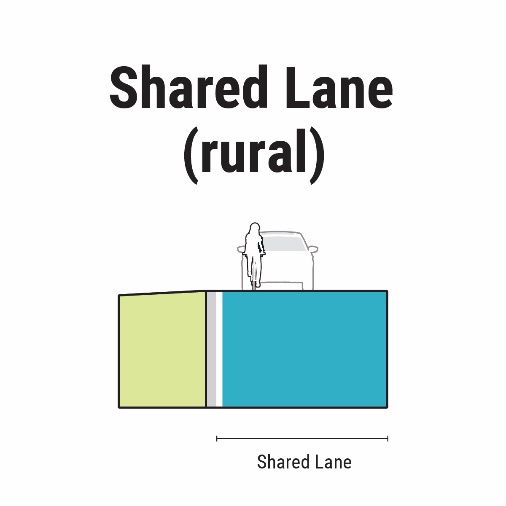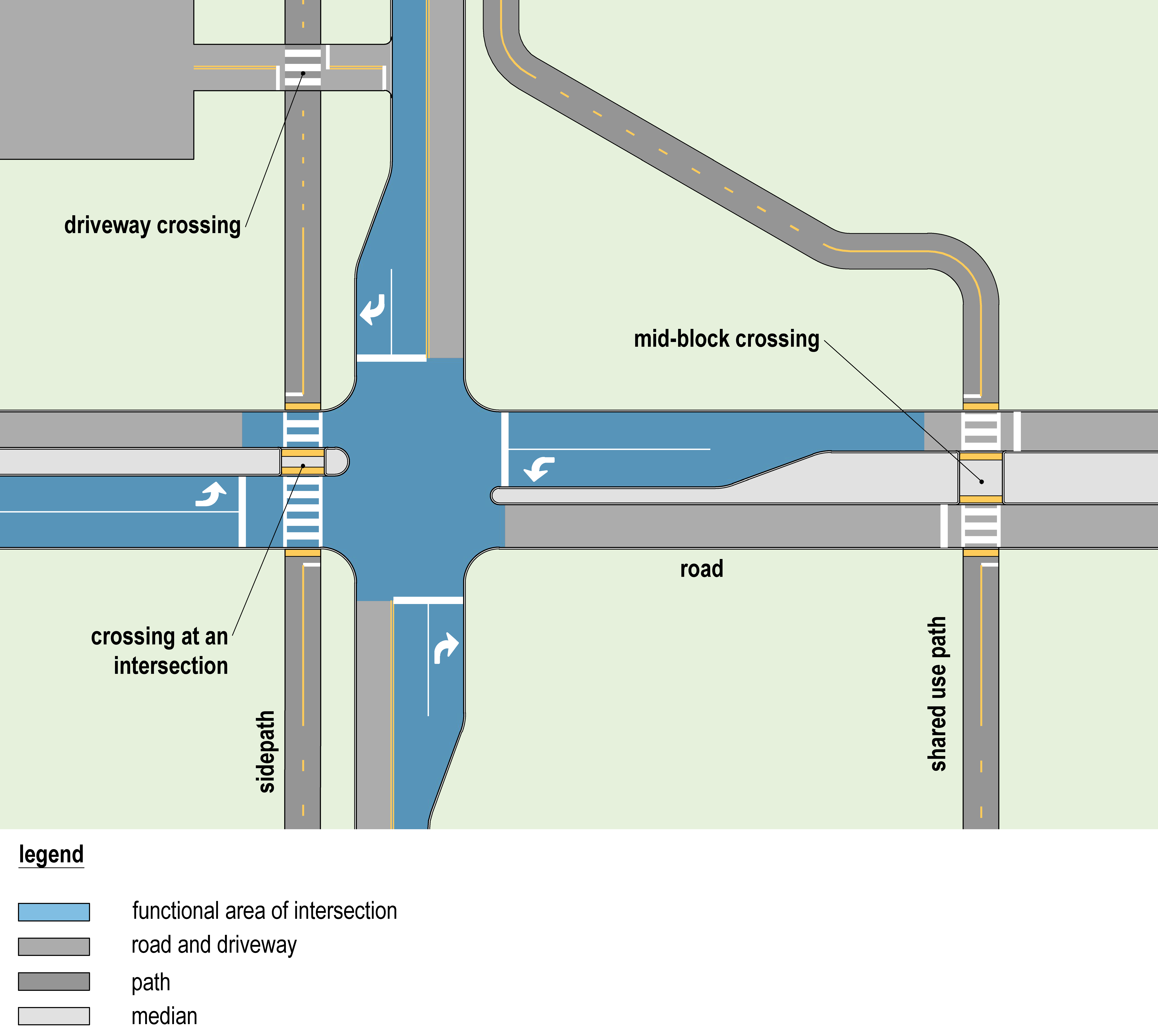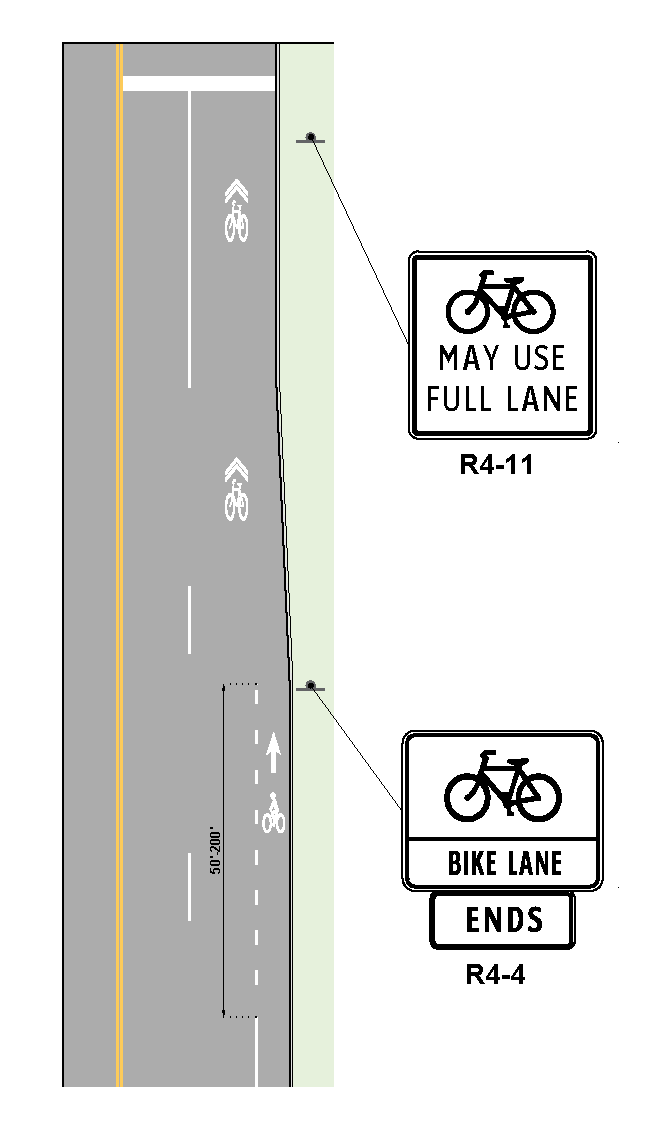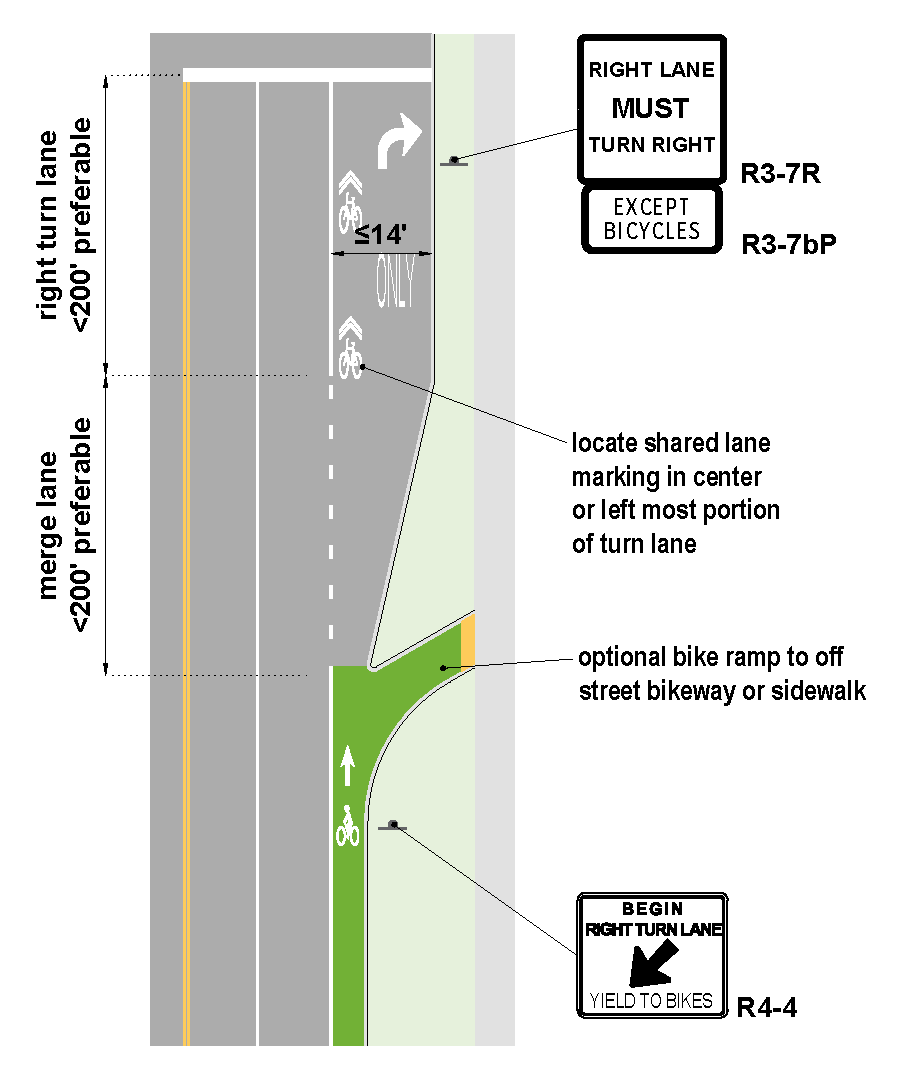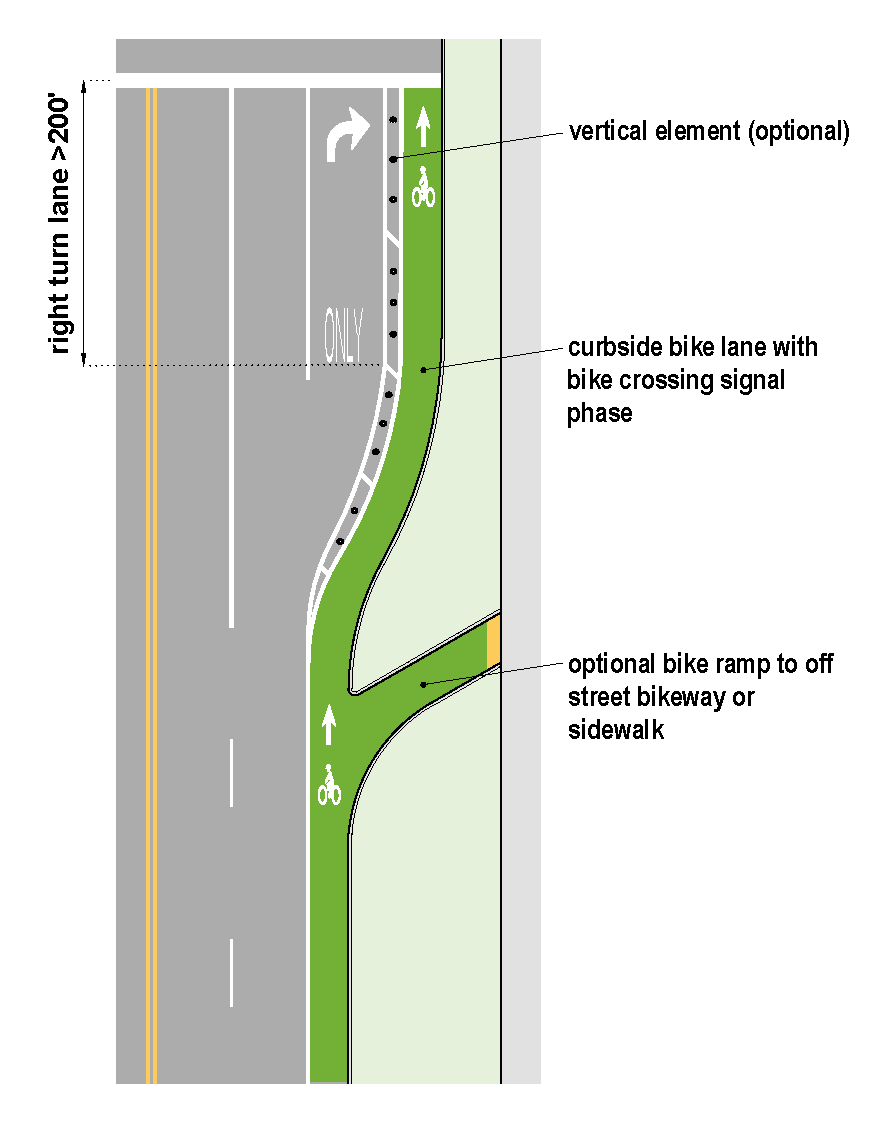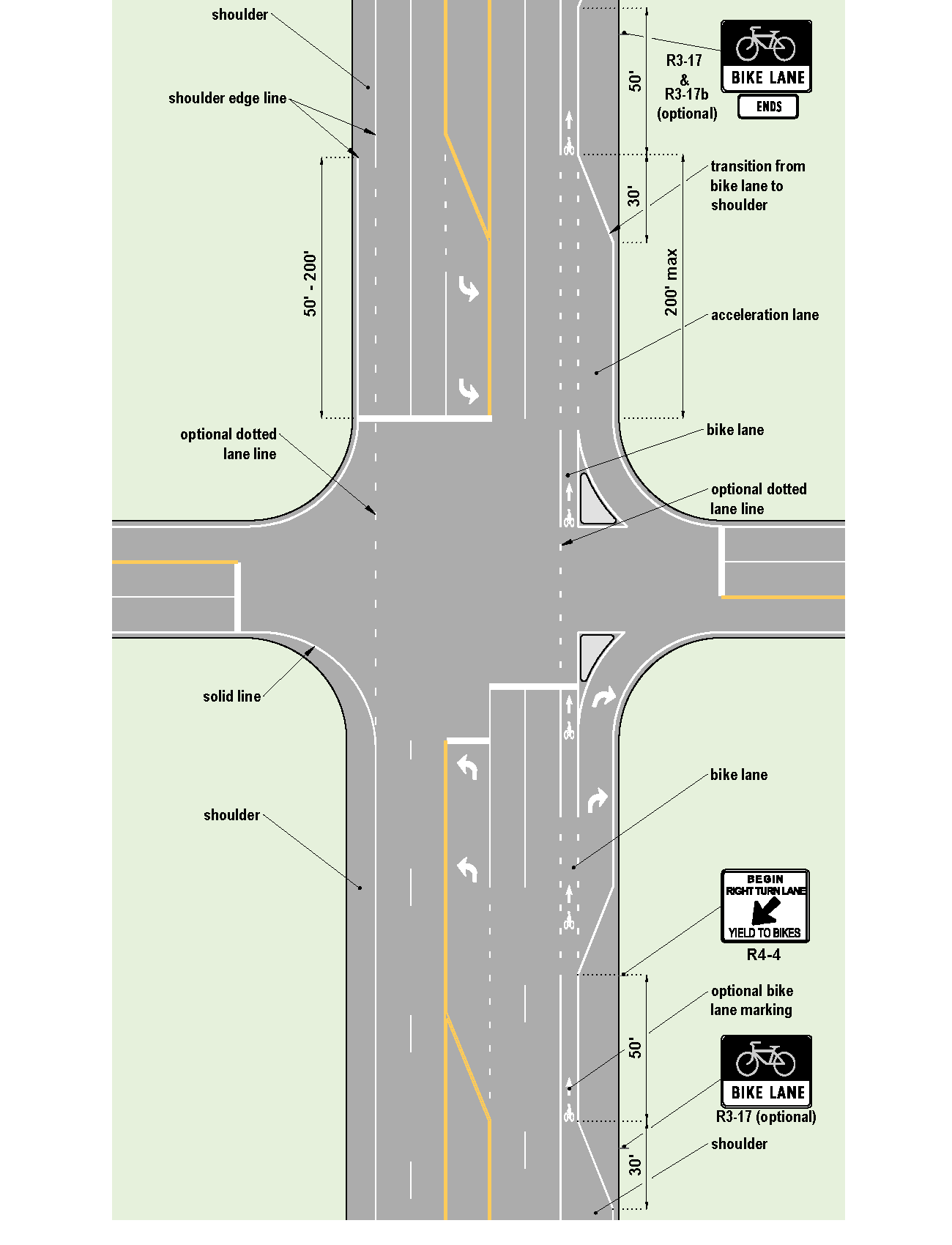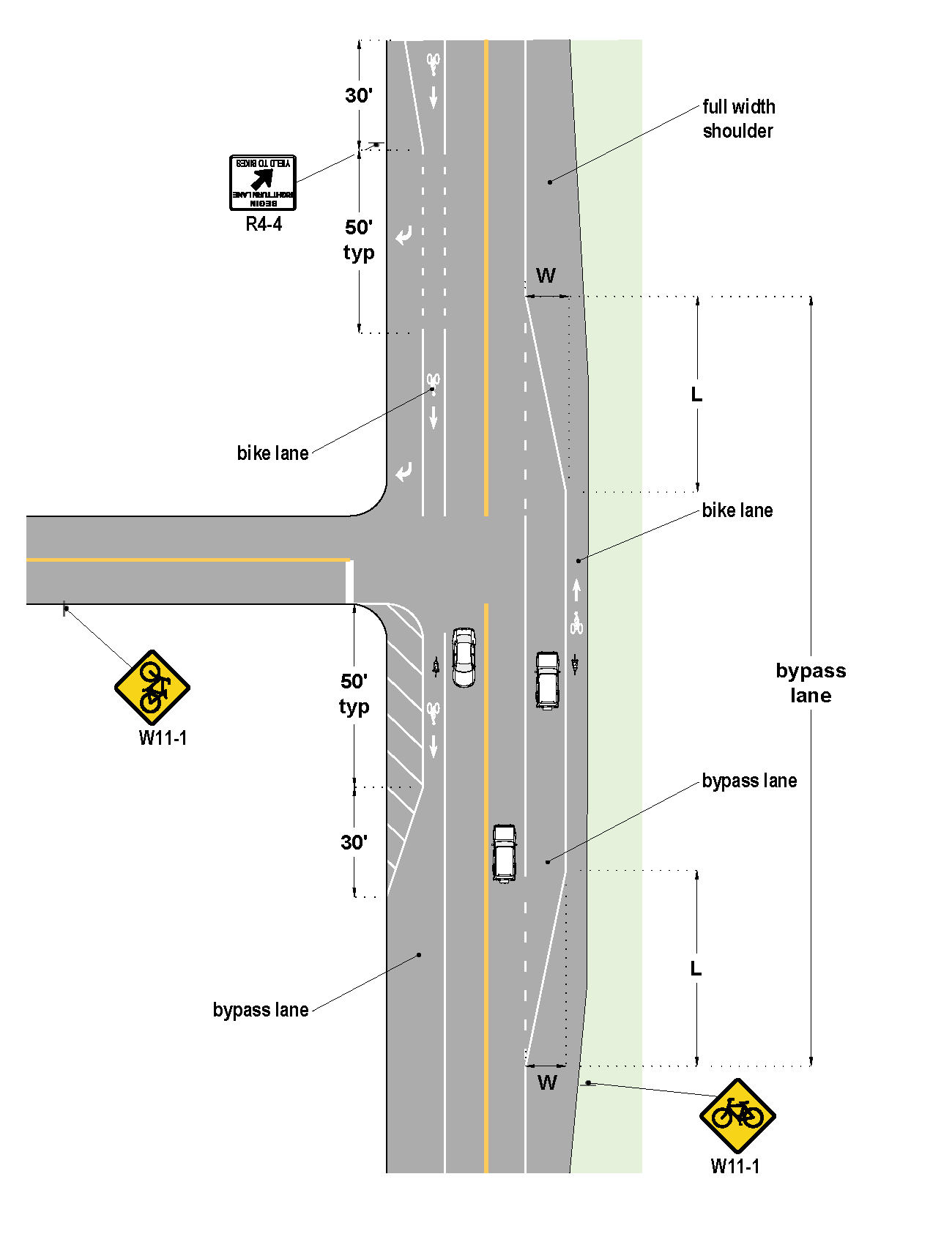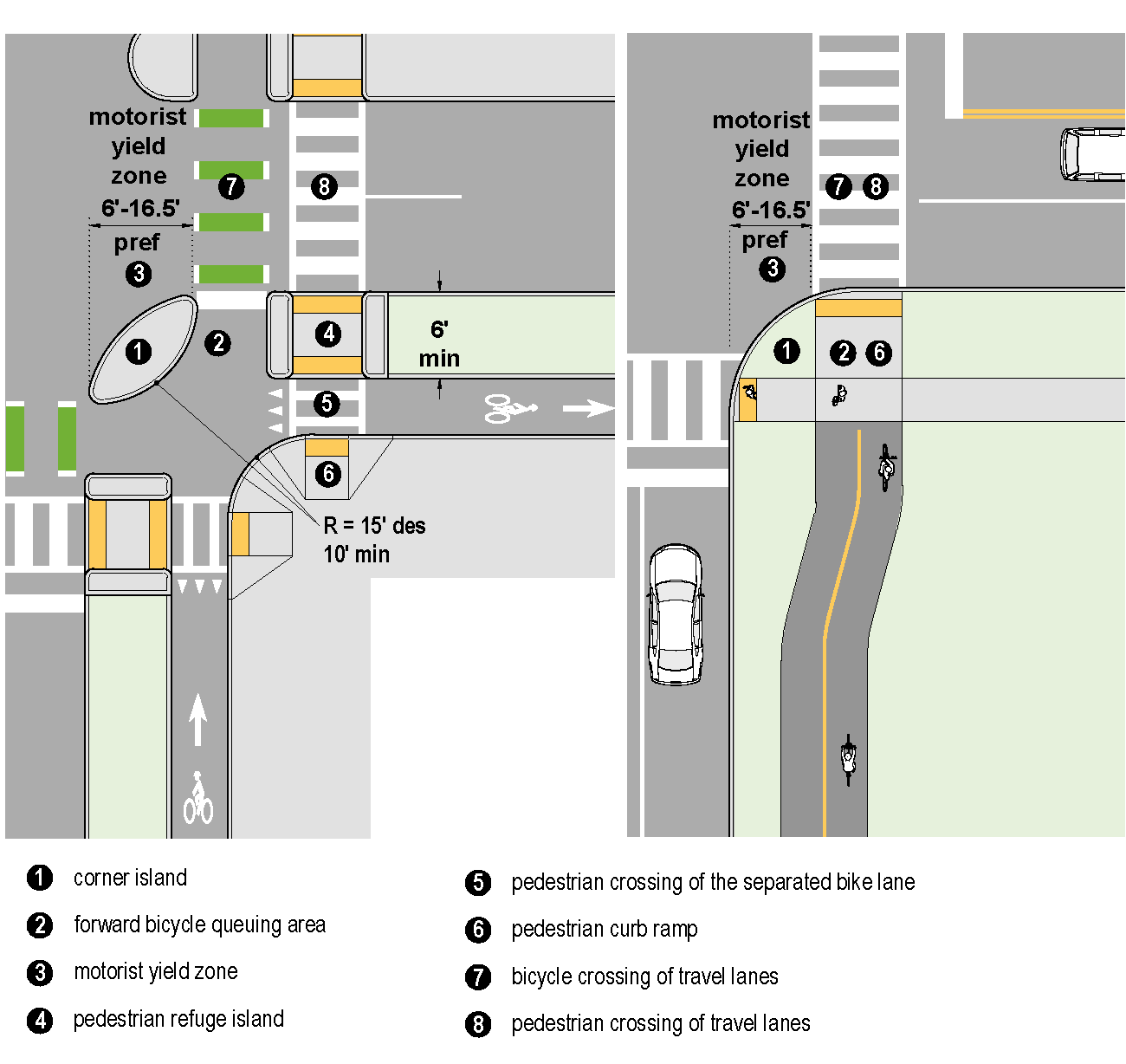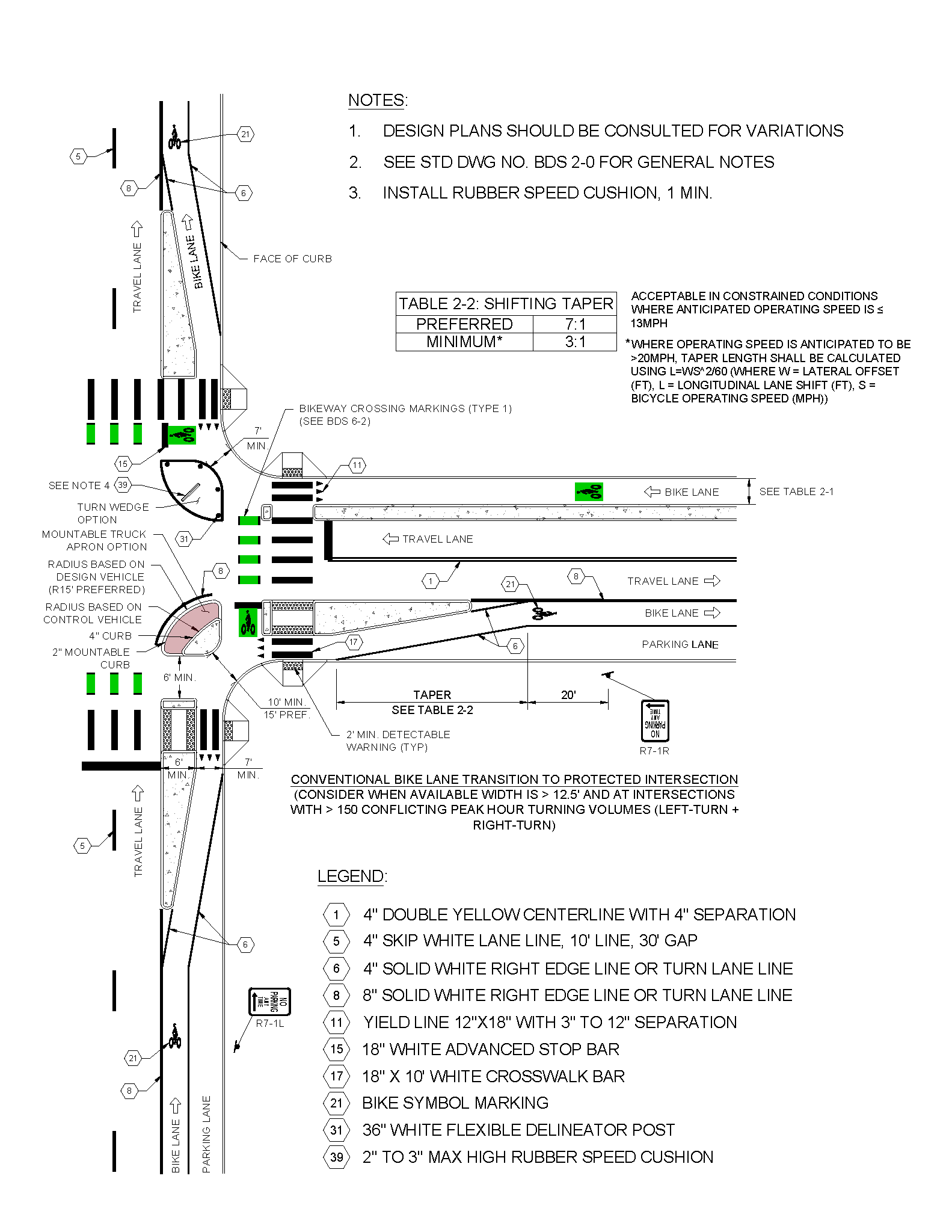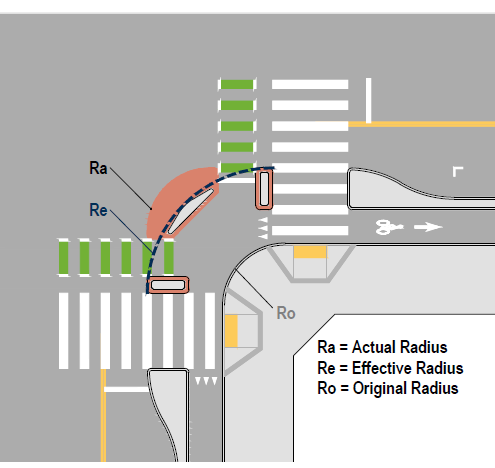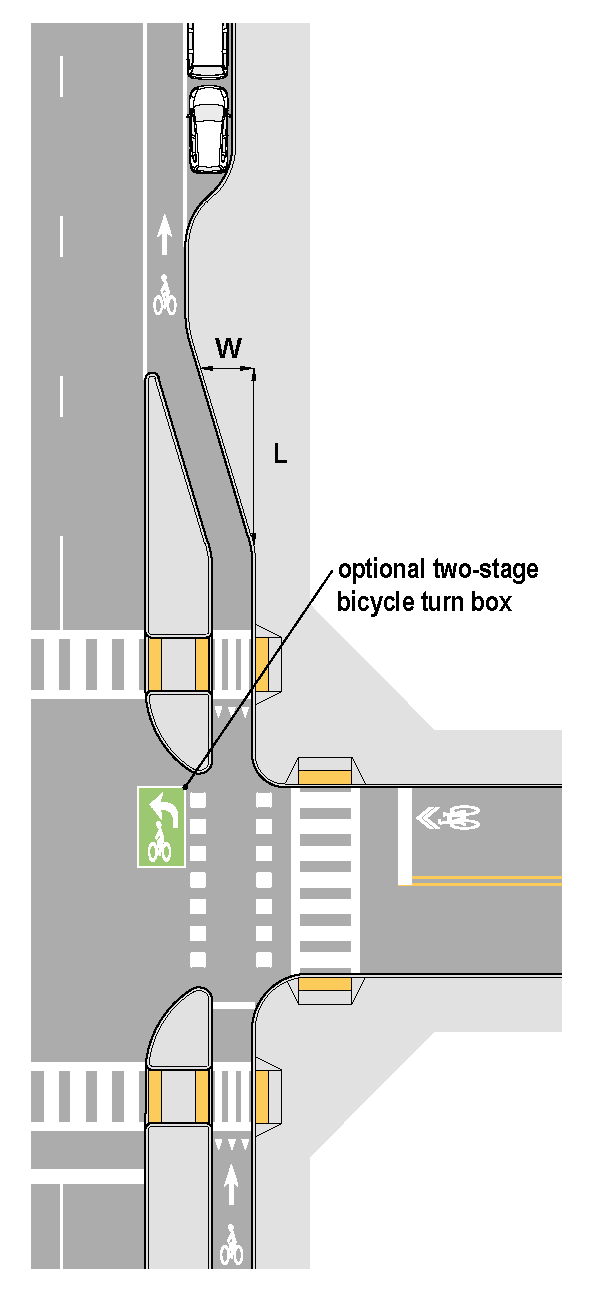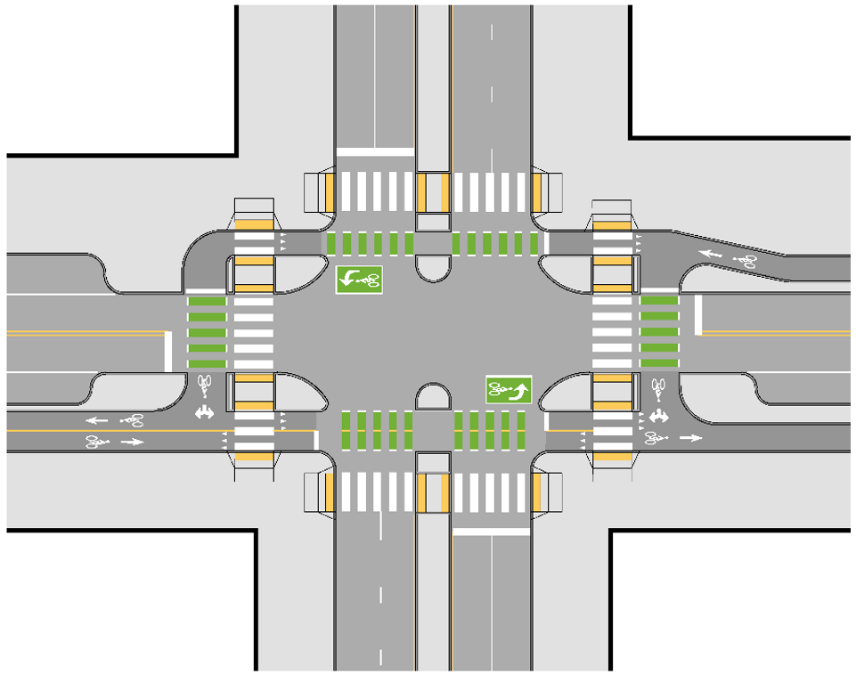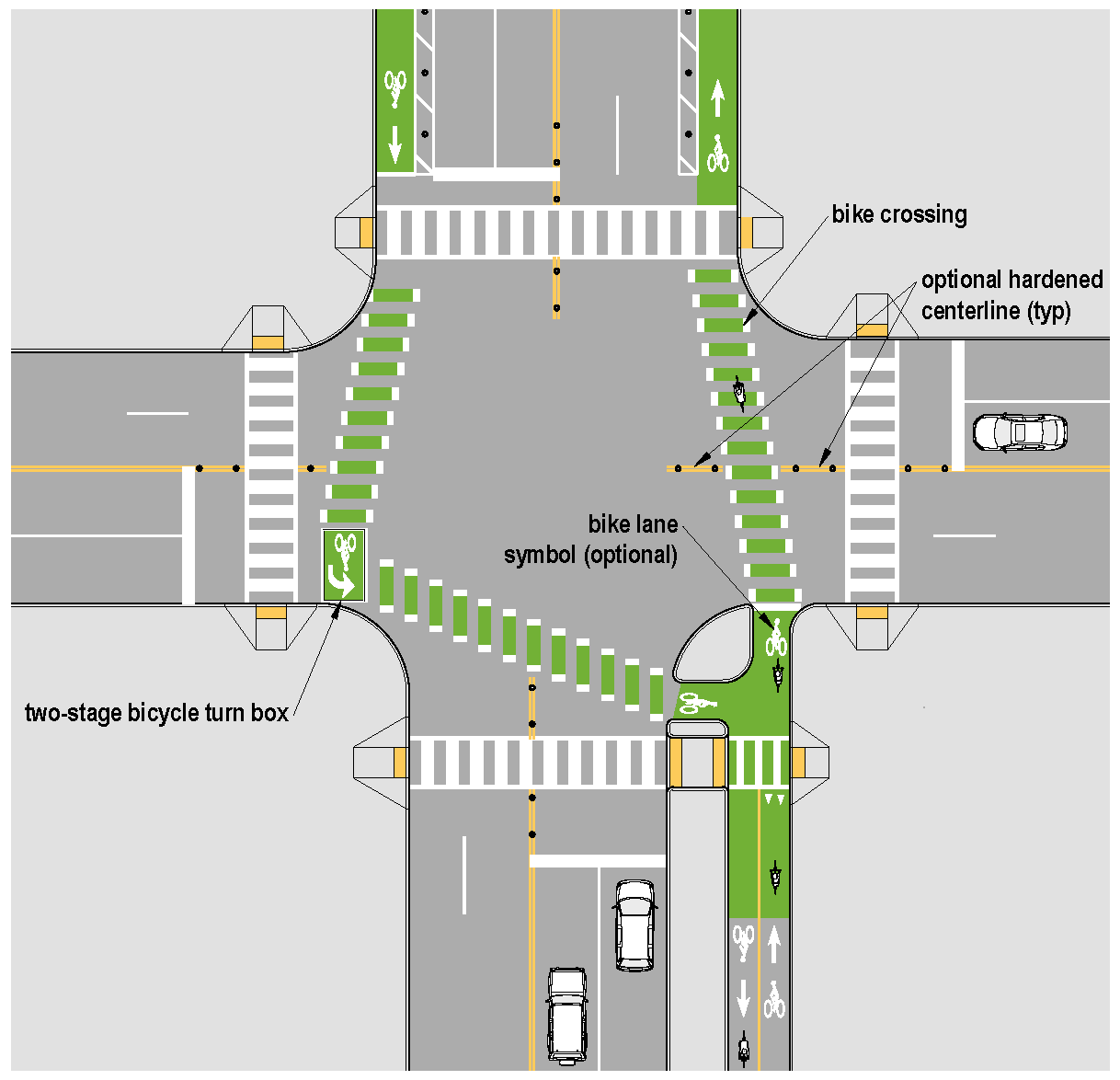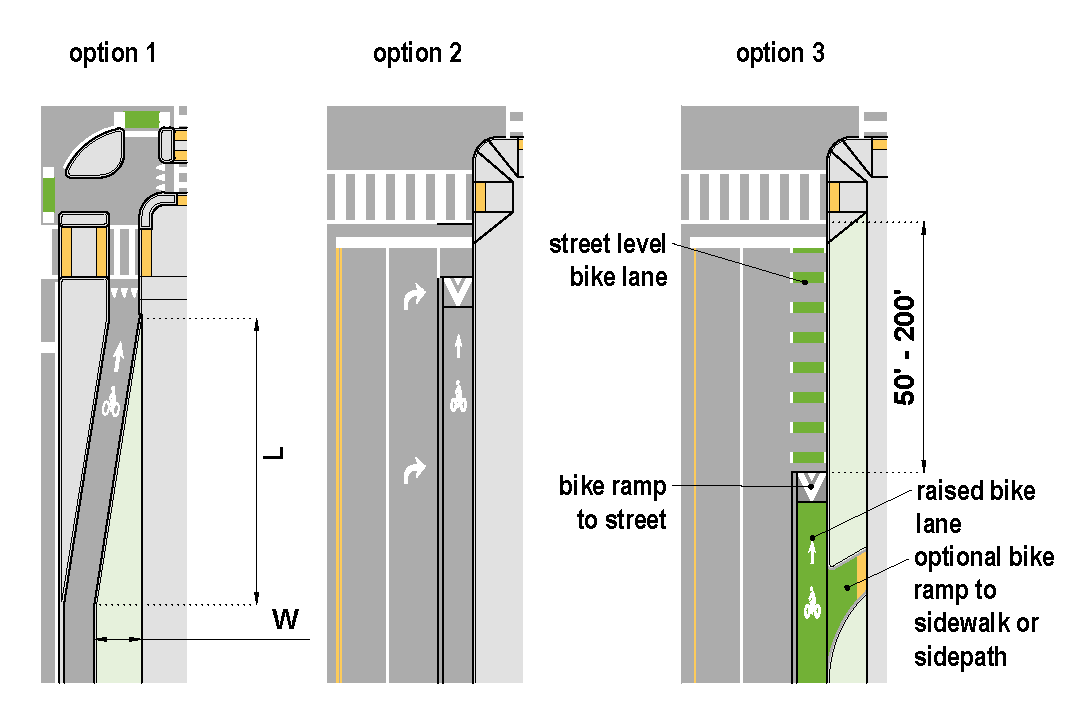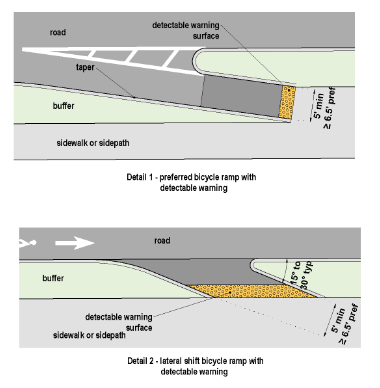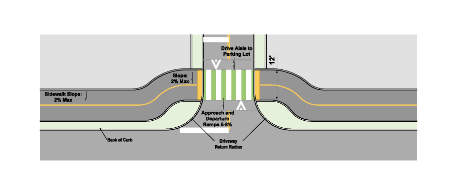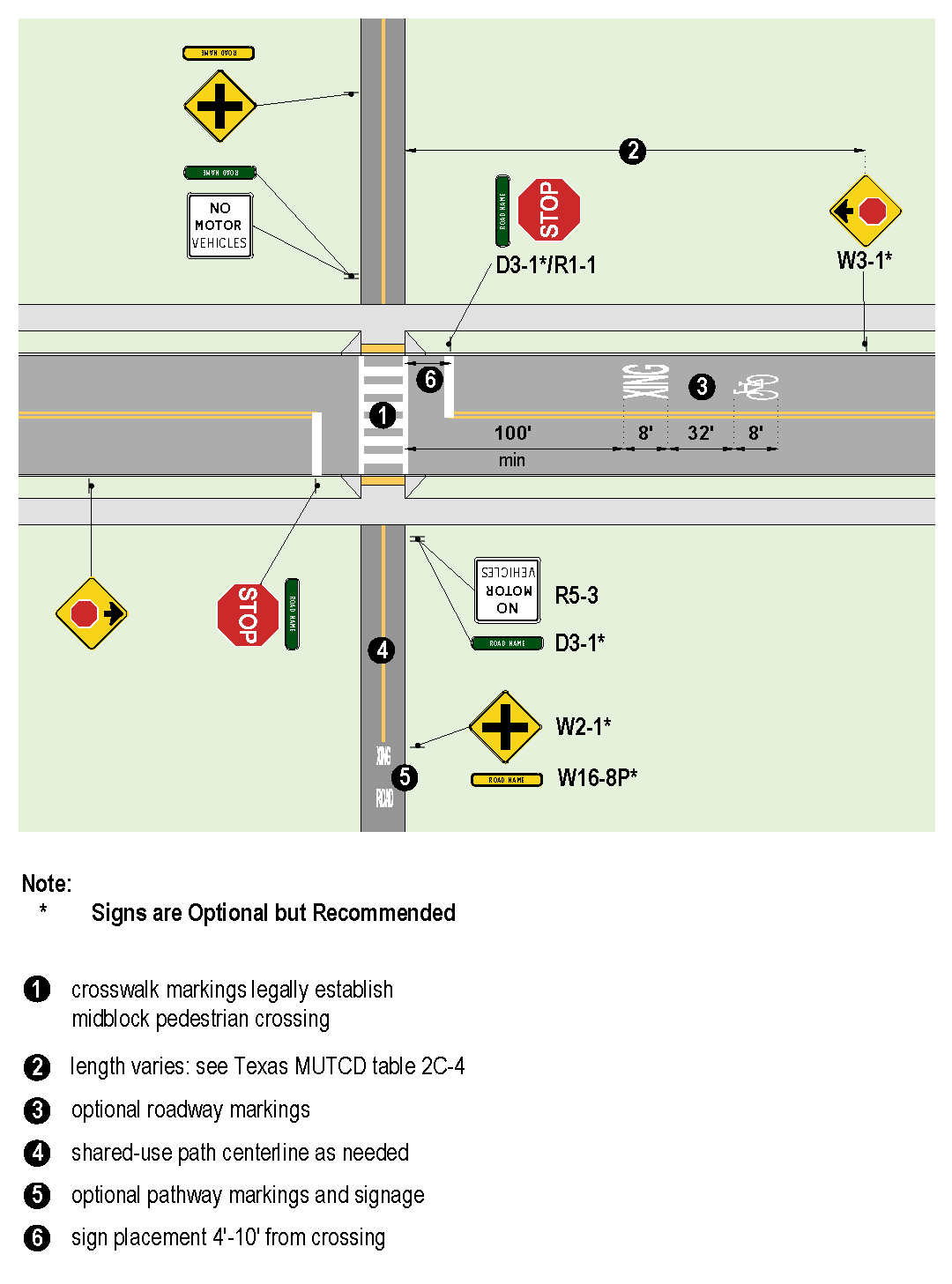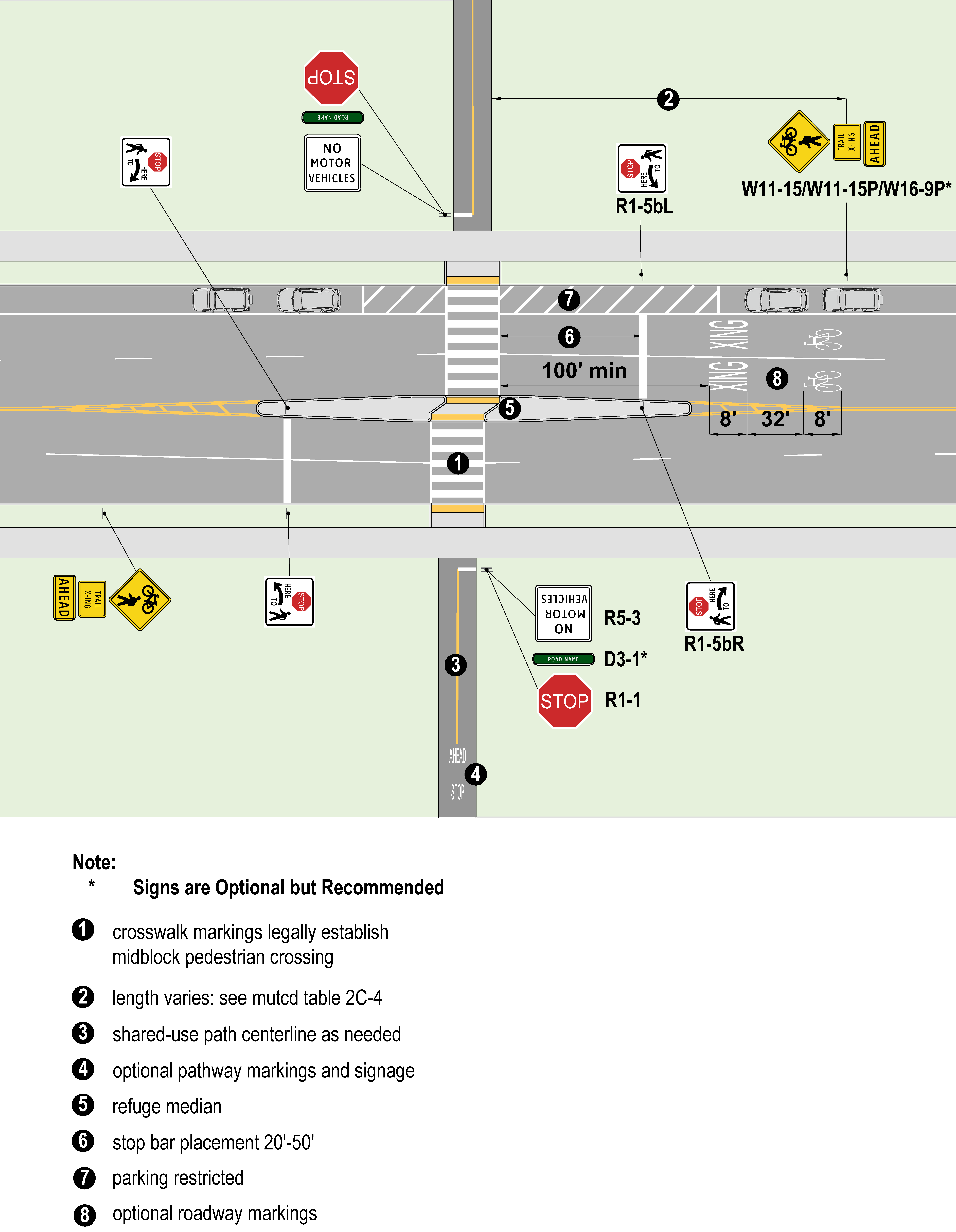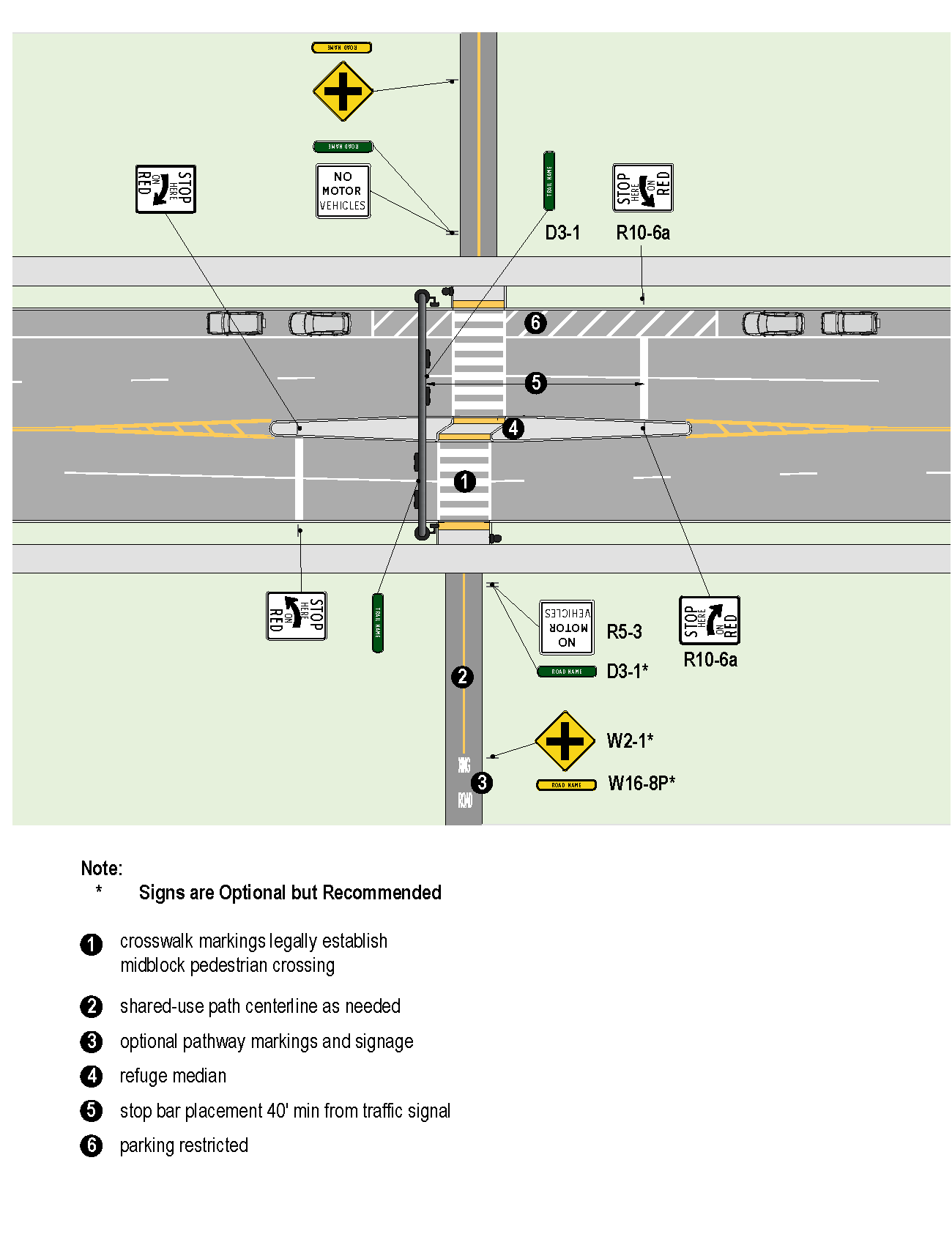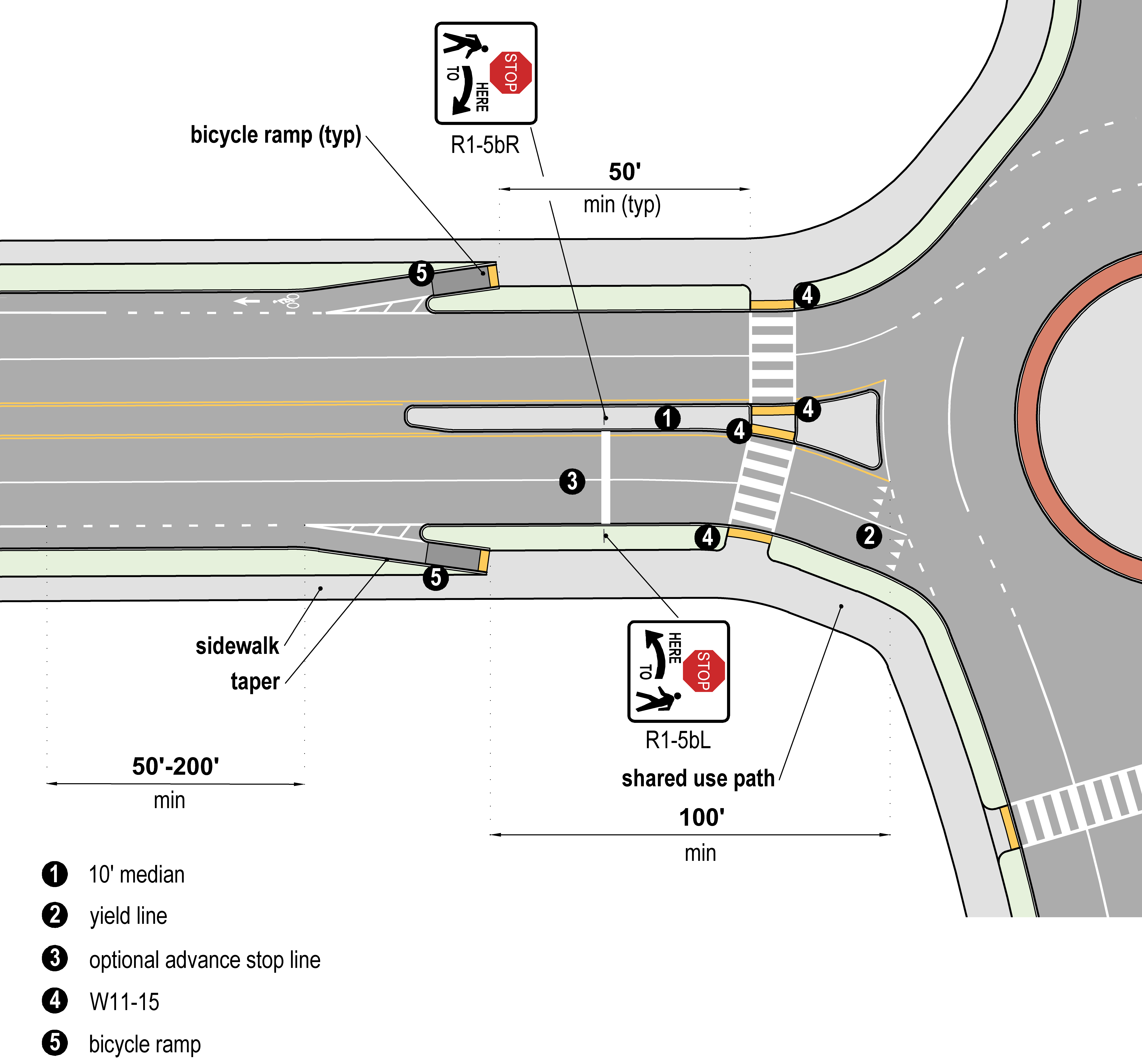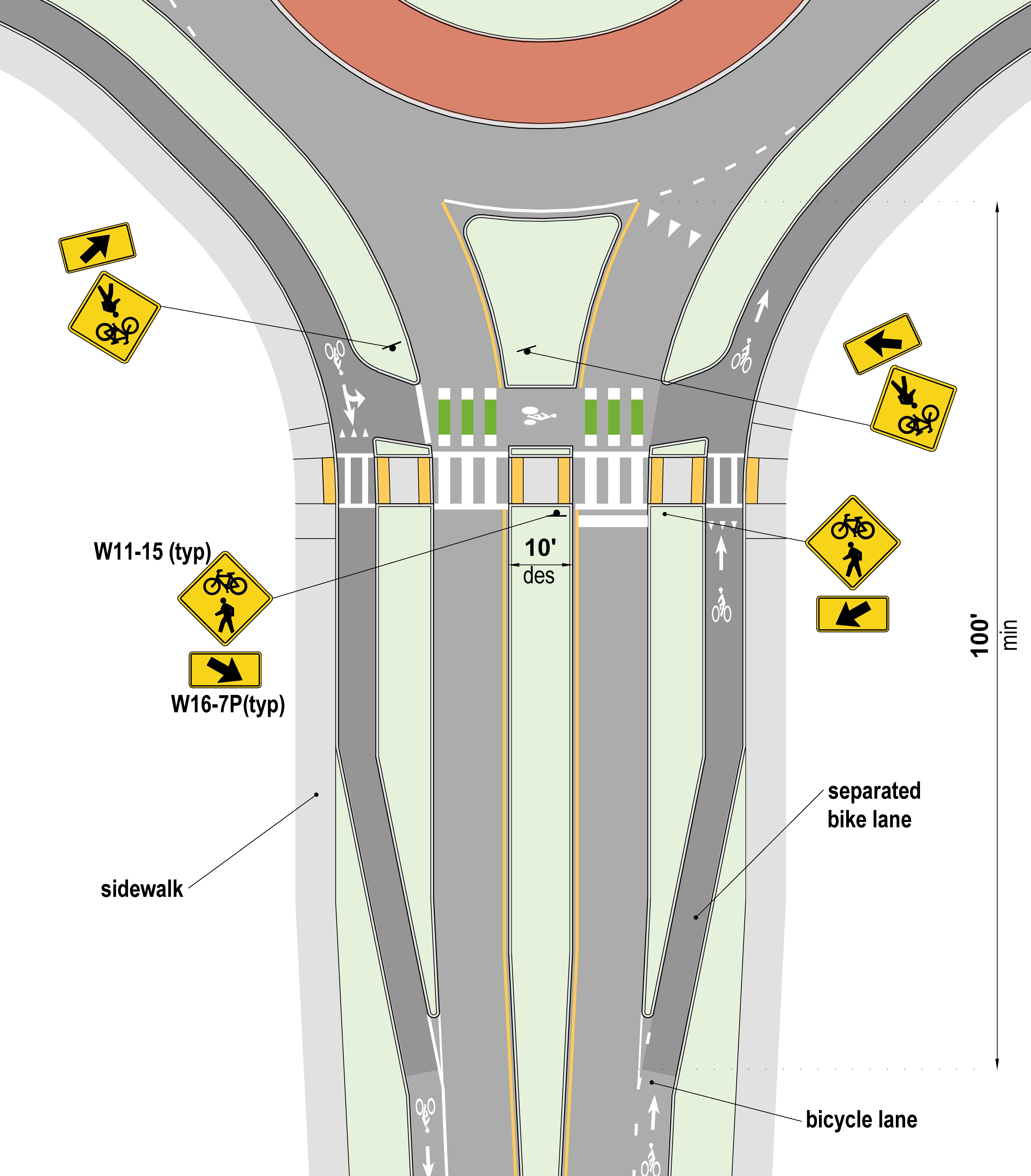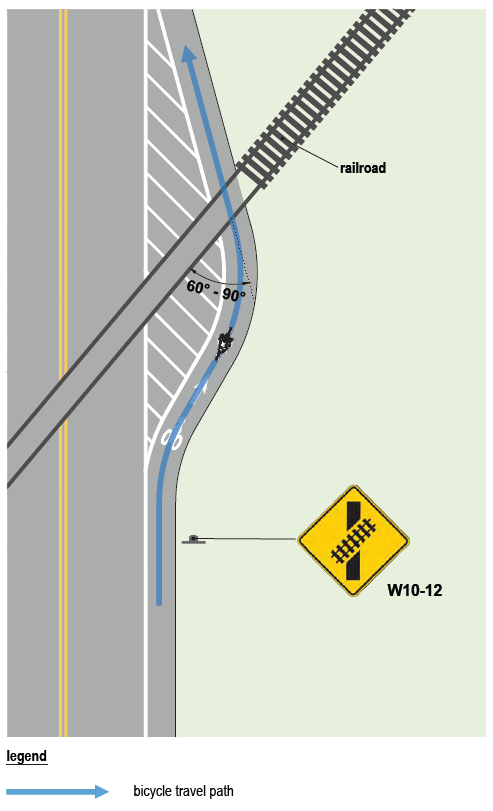Section 4: Bicycle Facilities
This section discusses the features and design criteria for bicycle facilities and includes the following subsections:
- Anchor: #NRGLJFBH
- 6.4.1 General Anchor: #VWLFXNUD
- 6.4.2 Planning and Context Anchor: #BDQRMXHC
- 6.4.3 Elements of Design Anchor: #YXWARMLA
- 6.4.4 Bicycle Facility Types Anchor: #VGBGOLGE
- 6.4.5 Intersections and Crossings Anchor: #BGCXHJYI
- 6.4.6 Maintenance, Operations, and Work Zone Anchor: #HDLXHKPH
- 6.4.7 References
6.4.1 General
6.4.1.1 Purpose
This chapter provides guidance on the design of bikeways with the goal of accommodating people of all ages and abilities riding bicycles. The application of this guidance will apply to TxDOT roadways and any project funded by TxDOT.
Note that “colored-pavement markings” are not currently prescribed in TxDOT policy. For the purposes of this guidance, in pictures, and figures where colored markings are shown they are for depiction purposes only to illustrate the general location of bicycle traffic. Additionally, the signing and pavement markings shown are examples. Current standard signing and pavement markings may be found in the TMUTCD, Standard Highway Sign Designs for Texas (SHSD) and applicable Traffic Standard Sheets.
6.4.1.2 Definitions
The following definitions are provided for the purpose of this Guide; therefore, definitions may vary when reviewing other sources.
- Anchor: #WBLYEXLE
- Bikeways: Any road, path, or facility intended for bicycle travel which designates space for bicyclists distinct from motor vehicle traffic, such as bike lanes, buffered bike lanes, bike accessible shoulders, shared use paths, and separated bike lanes. A bikeway does not include shared lanes, sidewalks, signed routes, or shared lanes with shared lane markings. Anchor: #WRATJVMW
- Bicycle Facilities: A general term denoting provisions to accommodate or encourage bicycling, including bikeways, bicycle detection, shared lanes and shared lane markings, wayfinding, as well as parking and storage facilities.
6.4.1.3 Relationship to Other Policies, Laws, and Regulations
6.4.1.3.1 AASHTO and FHWA Guidelines
This TxDOT Bicycle Accommodation Design Guidance is based on the review of national guidelines for the best practices for the design of bicycle facilities and is the governing bicycle guidance document for TxDOT. The 2012 AASHTO Guide for the Development of Bicycle Facilities (AASHTO Bike Guide) continues to be the governing document for specific design criteria that is not contained within this TxDOT Bicycle Accommodation Design Guidance. However, for guidance not contained within this TxDOT Bicycle Design Guidance, the FHWA Bikeway Selection Guide should be considered a companion to the AASHTO Bike Guide, and in instances of contradictions the FHWA guide shall take precedence because it contains design guidance more current than the AASHTO Bike Guide. The 2012 AASHTO Bike Guide does not cover certain bikeway types. For example, design for separated bike lanes is quickly evolving and, as such, a flexible design approach is encouraged. For further information on FHWA’s position on design flexibility, refer to the August 2013 memo “Bicycle and Pedestrian Facility Design Flexibility.”
6.4.1.3.2 U.S. Department of Transportation Policy
On March 11, 2010, U.S. DOT signed a federal policy statement on Bicycle and Pedestrian Accommodations Regulations and Recommendations. This policy statement emphasized that, “every transportation agency, including a state DOT, has the responsibility to improve conditions and opportunities for walking and bicycling.” The statement encourages transportation agencies “to go beyond minimum standards to provide safe and convenient facilities for these modes” on all transportation projects.
6.4.1.3.3 National Statutes
Under 23 U.S. Code 217(g)(1) it states, “Bicycle transportation facilities and pedestrian walkways shall be considered, where appropriate, in conjunction with all new construction and reconstruction of transportation facilities, except where bicycle and pedestrian use are not permitted.”
6.4.1.3.4 Texas Codes
The Texas Administrative Code (TAC) and the Texas Transportation Code (TTC) provide directives for the design of bicycle facilities in the state of Texas. Title 6 §201.902(c) of the TTC requires TxDOT to adopt rules relating bicycle use on the roads in the state highway system. Title 43 §25.53 of the TAC specifies that TxDOT must take bicycle accommodation into consideration during the planning and implementation of all construction and rehabilitation projects. Title 43 §25.54 of the TAC specifies that TxDOT will adopt the latest version of the AASHTO Bike Guide and will continue to review guidelines for design, construction, and maintenance of bicycle facilities with the intent to adopt new guidelines as appropriate.
Accordingly, this TxDOT Bicycle Accommodation Design Guidance is based on the review of national guidelines for the best practices for the design of bicycle facilities and supersedes aspects of the AASHTO Bike Guide. If a specific design criterion or guidance is not provided herein, see Section 6.4.1.3.1 for document precedence. It is anticipated that all guidance herein provides further enhancements to the safety and comfort level of most cyclists compared to the 2012 AASHTO Bike Guide.
6.4.1.4 Projects that can be Excepted from Bicycle Accommodations
Bikeways should be routinely included when planning and designing transportation facilities, addressing the needs of the target design user (see Section 6.4.2.3); consequently all projects must be consistent with the identified needs for bikeways as identified in the NEPA process. Exceptions to providing bikeways are permitted if the project meets one or more of the following criteria. Although an area may fall under one of the exceptions below, it is important to plan for anticipated growth where bicycling activity might become more prevalent in the future during the life of the project. MPO and local planning documents should be reviewed and coordinated with to identify anticipated future growth when selecting bikeways outside the urbanized boundaries. The documentation for having an exception based on the following criteria will be maintained with the project file with specific documentation as to the nature of the exception, but this is not considered a formal Design Exception or Design Waiver. The circumstances requiring a formal Design Exception or Design Waiver are documented in Section 6.4.1.6 of this guidance.
Note, projects located on the Texas Bicycle Tourism Trails Example Network are not excepted from providing bikeways regardless of location. The TxDOT Statewide Planning Map provides additional information on MPO boundaries, area types, and the Texas Bicycle Tourism Trails Example Network. Additionally, all On-System bridges regardless of location, involving bridge replacement, bridge deck replacement, or bridge rehabilitation will need to meet the bicycle clear space requirements specified in Section 6.4.2.4, and are not excepted. Off-system Bridges, with current ADT greater than 400 ADT, where this addition may represent an unreasonable increase in cost may be excepted from the bicycle clear space requirement, see Ch. 6, Section 1 for specific off-system bridge requirements for current ADT of 400 or less.
- Anchor: #CWFJOWFR
- The project is on a roadway where bicycle travel is specifically prohibited by law or Texas Transportation Commission Minute Order. Anchor: #XCANHHER
- The project is located outside of a respective Metropolitan Planning Organization (MPO) Boundary; AND is also located outside of any respective city limits with a population of 2,500 or greater. The TxDOT Statewide Planning Map provides additional information on MPO boundaries and area types. Before using this exception, project designers should seek out and consider local stakeholder input and community need. Anchor: #MJAGGDRX
- The project is in an urbanized setting (defined as a city, town, or Census-designated place with a population of 2,500 or greater) where a locally preferred alternative route has been adopted or implemented and bikeways are deemed impractical within the scope of the project. The project is in an urbanized setting with limited roadway improvements, and there is already a future project programmed (e.g., MPO Active Transportation Plan) where the bicycle updates would make more sense in the context of overall transportation improvements. Anchor: #AOAEGMJR
- The cost to provide features exclusively for bikeways is excessively disproportionate to the need or likely uses. While a determination of “excessively disproportionate” should be concluded on a case-by-case basis and well documented, exceeding 20% of the total project cost (including design, construction, ROW, etc.) may be considered as a general guideline. This exception should not be used if the project will help complete a gap in an overall bicycle network. Anchor: #DAPMMLVU
- The source of funding specifically precludes improvements other than those for which the funding is intended. Note that although Category 8 funding (which includes HSIP, Statewide systemic widening, and Road to Zero) does not currently have funding allocated specifically for bikeways, it is allowable to place money that has been specifically designated for bicycle accommodations into Category 8. Note, the following link from FHWA provides funding opportunities for bicycle facilities. ( https://www.fhwa.dot.gov/environment/bicycle_pedestrian/funding/funding_opportunities.cfm) Anchor: #RNHSHRRQ
- The type of work is limited in scope such that major roadway elements are not being constructed or reconstructed. For example: safety end treating culverts only, Metal Beam Guard Fence (MBGF) replacement only, sealcoat only, and other types of preventative maintenance projects. Note that resurfacing can provide the opportunity to restripe and/or improve the riding surface for bikeways in certain instances and, as such, would not necessarily warrant an exemption. Other projects with a narrow scope should be evaluated to determine if negative impacts to the bikeway may result.
6.4.1.5 Use of Dimensional Values for Bikeway Design
Due to the fact bicyclists operate with or adjacent to motor vehicles, the provision of facilities which meet minimum dimensions alone may not always ensure a safe or comfortable bikeway for bicycle travel. Because bicyclists are often operating with motor vehicles, designers should consider the bicyclists’ perception of safety and the type of bikeway relative to the context in which the bikeway is located. In many instances the use of minimum values for design criteria do not account for the user’s perception of safety using the facility. The perception of how safe a person feels on the transportation system can have significant impacts on how they choose to use or avoid the facilities provided. Assessments of perceived safety for the same site will vary between observers but is increasingly measurable by comfort rating tools found in the Highway Capacity Manual. Perceived safety is analogous to “subjective” safety as defined by the AASHTO Highway Safety Manual.
The following terms are used throughout the guide to define the desirable, minimum, and constrained conditions for which bikeway widths will be determined:
6.4.1.5.1 Desirable Values
Desirable values are stated explicitly throughout the chapter by using the words “desirable” or “desired.” In many instances, these will be presented as a range of values (e.g. bike lane width). The design value should be chosen to meet the purpose and need objectives of the bicycle facility where practicable. In general, desirable values (typically larger values) should be used to maximize the safety and comfort benefits for bicyclists and other users. Alternative values should only be used in locations where it is not possible to use desirable values due to social, economic, and environmental impacts.
6.4.1.5.2 Minimum Values
Minimum values are either implied by the lowest value in a range, or explicitly stated throughout the chapter by using the word “minimum.” The use of minimum values should not automatically be considered a default for bikeways due to the inherent vulnerability of bicyclists in the event of a crash. In some instances, the use of minimum design values may result in trade-offs with respect to the comfort and safety of bicyclists.
6.4.1.5.3 Constrained Values
Where the use of a minimum design value may degrade bicyclist safety or comfort, the words “in constrained conditions” are used. In general, the use of constrained values should only be considered:
- Anchor: #VVMUXTVI
- for limited distances (such as to bypass a transit stop or to accommodate a bikeway on an existing bridge); Anchor: #QPCGHQNJ
- as an interim measure where the larger values will result in the preferred design not being constructible; or Anchor: #DNXOCBOX
- at locations with low volumes of bicyclists where those volumes are anticipated to remain low. Anchor: #KUKNCGXC
- Additional engineering countermeasures at locations should be considered where the use of constrained values is likely to increase crash risk or reduce bicyclist comfort.
6.4.1.6 Design Exceptions and Waivers for Dimensional Values of Bicycle Facilities
As previously discussed, the process for deciding if projects can be excepted from providing bicycle facilities does not require a design exception or design waiver. However, if a project includes bicycle facilities and the preferred bicycle facility type cannot meet the respective criteria or thresholds, designers can select the next best facility type following the guidance in Section 6.4.2.5. A design exception or design waiver is needed if the minimum criteria for the selected facility is not met.
6.4.1.6.1 Urbanized Context (Urban Core/Urban/Suburban/Rural Town)
Design Exceptions
Bike Lane: If the minimum width specified in the Basic Design Guidelines is not met.
Shared Lane (Wide Outside Lane): If the traffic volume, speed, or width criteria (14-ft maximum, 13-ft minimum) specified in the Basic Design Guidelines are not met.
Design Waivers
Shared Use Path (Independent alignment or sidepath): If the minimum width criteria (minimum 10-ft, 8-ft constrained), buffer width, and other geometric criteria specified in the Basic Design Guidelines, and the associated AASHTO Bike Design criteria are not met.
Separated Bike Lane/Buffered Bike Lane: If the minimum criteria specified in the Basic Design Guidelines are not met.
6.4.1.6.2 Rural Context
Design Exceptions
Shared Lane (Wide Outside Lane): If the traffic volume, speed, or width criteria (14-ft maximum, 13-ft minimum) specified in the Basic Design Guidelines are not met.
Design Waivers
Shared Use Path (Independent alignment or sidepath): If the minimum width criteria (minimum 10-ft, 8-ft constrained), buffer width, and other geometric criteria specified in the Basic Design Guidelines, and the associated AASHTO Bike Design criteria are not met.
Bike Accessible Shoulder: For new construction, reconstruction, or widening projects in a rural setting where right-of-way is being acquired, a Design Waiver is required if a minimum width defined in the Basic Design Guidelines for each bikeway type is not provided (see Section 6.4.4).
Anchor: #i10135416.4.2 Planning and Context
6.4.2.1 Bicycle Planning Principles
Effective bikeway design and network planning often leads to more people bicycling by creating routes that are efficient, seamless, and easy to use. Having a clear understanding of good planning and design principles is important as these concepts will ultimately be the foundation for the design intention and potential trade-offs that may occur. Bicycle planning principles that can be used include safety, comfort, connectivity, and cohesiveness. Descriptions of these principles are provided in Table 6-1.
|
Safety |
|
|
Comfort |
|
|
Connectivity |
|
|
Cohesiveness |
|
6.4.2.2 Context Considerations
Context and engineering judgment play important roles in selecting the appropriate bicycle accommodations. FHWA identifies four components that are important in identifying what type of bicycle accommodation to use: project limits, land use context, types of bicyclists the bicycle accommodation is expected to serve, and key safety and performance criteria.
As part of these overarching themes, the elements outlined below should be documented in the design process and used to determine the selection of an appropriate bicycle facility type, as discussed in the following sub-sections:
- Anchor: #EUYLSYNV
- Project Identification: Project name, project ID (CSJ), roadway name, limits, county; Anchor: #VXSNNPHM
- Roadway Context: Adjacent roadway functional class, speed, average daily traffic volume, project length, intersection frequency and crossing road functional classification, driveway density; Anchor: #POQBPPUE
- Area Context: Land use context (see below); Anchor: #MSYOTELS
- Intended Bicycle Accommodation Users: Target design user (interested but concerned or all ages and abilities); and Anchor: #DGARMTIW
- Other Roadway Users: Truck percentage and key movements, transit operation (headway) and key stops, curbside lane activity, expected pedestrian demand.
6.4.2.2.1 Land Use Contexts
The land use context that surrounds a potential bikeway may influence the type of users (e.g. target design user), the number of users, and the potential interactions of other roadway users with the facility. Two context groupings have been used when providing guidance for bikeway selection:
- Anchor: #DTLCDEHI
- Urban and Suburban Contexts (referred to as “urbanized” and includes urban core and rural town which is defined in FHWA’s Separated Bike Lane Planning and Design Guide); and Anchor: #i1000504
- Rural Contexts.
The urban core and rural town are land use contexts that are anticipated to be added to a future version of the Roadway Design Manual that will allow additional flexibility with respect to roadway, and bicycle facility planning and design. The urban core would be contained within the current definition of an urban area. The rural town would be contained within the current definition of a rural area. A city with a minimum population of 2,500 and less than a population of 50,000 is defined as an urbanized cluster by the US Census and for the purposes of this guidance will fall within the Urban and Suburban Contexts. Note that certain towns with populations less than 2500 will have characteristics of a rural town as described below and may utilize the rural town bicycle criteria as deemed applicable.
Urban Core
The urban core context includes areas of the high-density, with mixed land uses among predominantly high-rise structures and with small building setbacks. The urban core context is found predominantly in central business districts and adjoining portions of major metropolitan areas. On-street parking is often more limited and time restricted than in the urban context. Substantial parking is in multi-level structures attached to or integrated with other structures. The area is accessible to automobiles, commercial delivery vehicles, and public transit. Sidewalks are present nearly continuously, with pedestrian plazas and multi-level pedestrian bridges connecting commercial parking structures in some locations. Transit corridors, including bus and rail transit, are typically common and major transit terminals may be present. Some government services are available, while other commercial uses predominate, including financial and legal services. Structures may have multiple uses and setbacks are not as generous as in the surrounding urban area. Residences are often apartments or condominiums. Driver speed expectations are low and pedestrian and bicycle flows are high. See Figure 6-1 for a depiction of Urban Core.
Figure 6-1. Typical Street in the Urban Core Context.
Rural Town
The rural town context applies to roads in rural areas located within developed communities. Rural towns generally have low development densities with diverse land uses, on-street parking, and sidewalks in some locations, and small building setbacks. Rural towns may include residential neighborhoods, schools, industrial facilities, and commercial main street business districts, each of which present differing design challenges and differing levels of pedestrian and bicycle activity. The rural town context recognizes that rural highways change character where they enter a small town, or other rural community, and that design should meet the needs of not only through travelers, but also the residents of the community. See Figure 6-2 for a depiction of Rural Town.
Figure 6-2. Typical Street in the Rural Town Context.
6.4.2.2.2 Speed and Volumes of Motor Vehicles
There are many factors to consider when selecting and designing bikeways, with motor vehicle speed and volume as the initial determinants of suitable bicycle facilities. The influence of speed and volume on the safety and perceived safety or comfort of bicycle riders is an important factor and the respective criteria for appropriate speeds and traffic volumes is contained in the subsequent guidance.
For the purposes of this bicycle guidance when a speed criteria is mentioned it will mean the higher of the design or posted speed (speed limit). The vehicular ADT or traffic volumes referenced pertain to existing conditions. The respective sidepath, or bicycle volumes referenced pertain to existing conditions or anticipated beginning conditions. Note that the anticipated growth in usage should also be considered when defining the footprint for the bicycle accommodations.
6.4.2.2.3 Other Factors
Other factors that should be considered in the selection of bikeways are listed in the FHWA Bikeway Selection Guide and summarized in Table 6-2.
|
Factor |
Description and Design Considerations |
|---|---|
|
Unusually high motor vehicle peak hour volumes |
On roadways that regularly experience unusually high peak hour volumes, more separation can be beneficial, particularly when the peak hour also coincides with peak volumes of bicyclists. |
|
Traffic vehicle mix |
Additional separation between bicyclists and motorists is particularly important on moderate volume to high-volume streets where heavy vehicles are an abnormally high percentage of traffic. Higher percentages of trucks and buses increase risks and discomfort for bicyclists due to vehicle size and weight, and the potential for motorists to not see bicyclists due to blind spots. This is particularly a concern for right turns, where large vehicles may appear to be proceeding straight or even turning left as they position to make a wide right turn movement. Visibility and awareness of bicyclists can be improved by providing:
|
|
Parking turnover and curbside activity |
Parked or temporarily stopped motor vehicles present a risk to bicyclists high parking turnover and curbside loading (commercial and passenger) may expose bicyclists to being struck by opening vehicle doors or people walking in their travel path. Vehicles stopped within bicycle lanes or travel lanes may require bicyclists to merge into an adjacent travel lane. In locations with high parking turnover, or curbside loading needs, wider bike lanes or separated bike lanes in lieu of bike lanes, can help to alleviate conflicts. This issue also encompasses locations where transit vehicles load and unload passengers within a bicycle lane or shared curb lane. |
|
Driveways/intersection frequency |
The frequency of driveways and intersections also impacts decisions regarding the design of separation between the street and the bicycle accommodation as well as the design of driveways. Motorists need adequate sight distance to enter and exit intersections and driveways and benefit from sufficient space to yield to bicyclists. This is particularly important for sidepaths (the AASHTO Bike Guide enumerates the potential areas of conflict) and two-way separated bike lanes located on one side of two-way streets where contra-flow bicyclist may be unexpected by motorists. High driveway frequency may make a one-way bicycle facility type a preferable option. Consideration may be given to consolidating driveways as applicable. Wider buffers and clear sight lines can improve bicyclist safety. Where contra-flow bicycling occurs, additional design features that slow motorists’ turning movements and give motorists more time to see oncoming bicyclists may significantly improve safety for all users. Frequent, closely spaced driveways may limit the ability to provide vertical elements necessary to provide separated bike lanes. In these locations, buffered bicycle lanes, bicycle lanes or shoulders may be the only viable bicycle facility unless it is feasible to provide a raised bike lane at sidewalk level to provide greater separation from traffic. |
|
Direction of operation |
For separated bikeways, a determination must be made as to whether the bikeway will be provided as a one-way facility on each side of the road, a two-way facility on one side of the road, or as two-way facilities on both sides of the road. As discussed above, the contra-flow bicyclist may be unexpected by motorists requiring additional design mitigations. This decision requires engineering judgment based on the bikeway’s role in the broader bike network, connectivity, safety impacts, the locations of destinations within the corridor, physical constraints within the ROW, and an assessment of intersection operations and frequency of driveways and intersections. |
|
Vulnerable populations |
The presence of high concentrations of children and older adults should be considered during project planning. These groups may only feel comfortable bicycling on physically separated facilities, even where motor vehicle speeds and volumes are relatively low. Typically, these populations are less confident in their bicycling abilities and, in the case of children, may be less visible to motorists and lack both roadway experience as well as sufficient cognitive or physical maturity to recognize and anticipate potential conflicts. They can also create more conflicts with pedestrians when they are expected to share the same space. |
|
Network connectivity gaps |
It is essential to consider the proposed transportation project in context of the local bicycle network. Wide, high-volume, or high-speed roadways can create substantial barriers to connectivity. Parallel alternative routes may not exist or may require bicyclists to ride several miles out of the way, adding substantial distance and travel time. Intersections between state and local roadways may feature a high number of conflict points, constrained right-of-way, or high-speed differential. Separated facilities can help close gaps in a low-stress network. Considerations include providing separate bicycle facilities under freeway underpasses, improving visibility of bicyclists, providing on-street connections between two major shared use paths, or routes connected to schools, major employers, parks, or other recreational opportunities. |
|
Transit considerations |
Biking offers a valuable “first-mile” and “last-mile” connection to transit systems, effectively expanding the transit-shed around a station or stop. It is important to ensure accessibility of transit boarding areas, pedestrian crossings, and parking spaces, while also integrating the bicycle network into transit systems. Traffic laws and agency policy often address transit vehicles and bicycles in the right most lane or right side of the roadway. Some agencies have designated shared “transit lanes” for bicycle riding, but frequent bus stops or roadway design may create delays or less safe conditions for bicyclists sharing a lane with heavy transit traffic. If the preferred bikeway for a roadway is a bike lane or separated bike lane, the placement of the bike lane with respect to where pedestrians may wait or travel when boarding or alighting transit vehicles should be considered, as should the extent to which transit operations impact bicyclists’ level of comfort and safety. As noted in FHWA’s Separated Bike Lane Planning and Design Guide, options for minimizing conflicts with transit include installing signs, pavement markings, and/or floating bus stops to provide for shared space, placing a separated bike lane on the left side of a one-way street (out of the way of transit stops along the right side), or choosing to install a separated bike lane on a nearby parallel corridor away from transit. |
6.4.2.3 Target Design User
Different bicycle riders may have varying tolerances associated with the importance of the individual planning principles outlined above. Figure 6-3 indicates the array of potential bicycle riders that should be considered when scoping and designing a roadway project.
Figure 6-3. Types of Bicycle Facility Users as a Percentage of Total General Population
|
Interested but Concerned |
Somewhat Confident |
Highly Confident |
|
(51 – 56%) |
(5 – 9%) |
(4 – 7%) |
Research over the last decade has evaluated how to classify the general population into different types of bicyclists. This research confirms that only a relatively small percentage of people can be classified as comfortable bicyclists in mixed traffic, and that a large majority of people prefer some level of separation from higher-volume, higher-speed motorized traffic. As such, in many jurisdictions across the United States, the common target design user are those who are interested in riding but concerned about safety (“Interested but Concerned” bicyclists) as this is the largest group of potential bikeway users among the general population. According to research, these bicyclists would ride more if they felt safer and, thus, are more likely to take short trips, avoiding busier arterial roadways. “Interested but Concerned” bicyclists prefer separation from vehicles and have a lower tolerance for traffic stress than more confident riders.
To maximize the potential for bicycling as a viable transportation option, it is important to design facilities to meet the needs of the “Interested but Concerned” bicyclist user profile. Bicycle facilities which meet the needs of the “Interested but Concerned” bicyclist will generally meet the needs of all bicyclists, therefore they are considered “All Ages and Abilities” bicycle facilities because they maximize potential use. One exception to this are situations where bicyclists are operating in large groups, or where individual bicyclist who prefer to operate at higher speeds (typically greater than 20 mph) who may prefer to operate in the travel lane. In general, more separation from motorized traffic is desirable to serve a greater number and type of users more safely. TxDOT endeavors to provide bicycle facilities to serve bicyclists of “All Ages and Abilities” to maximize the number of people who may use the facility.
6.4.2.4 General Bikeway Selection
The figures in this section provide some general guidance for the bicycle planning principles, target design user, and context discussed in the previous sections. Note, these Figures are for very general guidance and a preliminary bikeway recommendation. Section 6.4.4 provides specific design criteria and additional guidance for the application of bikeways to serve a target design user. In particular, elements associated with the respective roadway speed criteria discussed in the application discussion or each bikeway in Section 6.4.4 should be reviewed before making a final bikeway selection and choosing specific design elements. As long as the project meets the defined criteria in Section 6.4.4 for a specific bikeway, the engineer has the discretion to select the bikeway that is best suited to the project needs and constraints.
Figure 6-4 provides an example selection process from FHWA. Note that Figures 6-5 and 6-6 should be used to make the initial recommendation for the type of bicycle facility.
Figure 6-4. FHWA Bikeway Selection Process and Guide Outline
6.4.2.4.1 Requirements for Selection – Urban, Urban Core, Suburban, and Rural Town
For all urbanized (urban, urban core, suburban, and rural town) contexts, the following guidance is provided for various types of construction (the selection guidance is based primarily on FHWA’s Bikeway Selection Guide):
- Anchor: #GLAOXAEW
- For full reconstruction projects, new construction projects, or other construction projects whether in existing right-of-way or with additional right-of-way, the project should use Figure 6-5 for the initial recommendation for bikeway facility type. See section 6.4.2.5 for guidance on downgrading to the next best facility type. For the selected facility type, the geometric values should adhere to the specific guidance for that facility type. For values not provided in this guide, refer to the AASHTO Guide for the Development of Bicycle Facilities and, for separated bike lanes, FHWA's Separated Bike Lane Planning and Design Guide. Note: TAS/ADAAG requirements for each facility type must be met as well. Anchor: #OSXEMAMC
- For projects involving bridge replacement,
bridge deck replacement, or bridge rehabilitation, the following
guidance is provided:
- Anchor: #XVQVKBEI
- A 5-ft minimum clear space (4-ft shoulder and 1-ft offset measured to the toe of barrier) shall be provided on the structure and along the adjacent barrier. Off-System Bridges, with current ADT greater than 400 ADT, where this addition may represent an unreasonable increase in cost may be excepted from this requirement. See Ch. 6, Section 1 for specific off-system bridge requirements for current ADT of 400 or less. Where feasible, desirable shoulder width as shown in Figure 6-6 should be used. Anchor: #ASUKHMQF
- For roadways identified on the Texas Bicycle Tourism Trails Example Network, preferred 10-ft (minimum 8-ft) shoulder width should be provided on bridges.
Figure 6-5. Recommended Bicycle Facility Selection for Urban, Urban Core, Suburban, and Rural Town Context
NOTE: Use the higher of the design speed and the posted speed for the speed. To be conservative when designing for all ages and abilities facilities, designers should attempt to use the higher-level facility at the respective boundary limits.
6.4.2.4.2 Requirements for Selection – Rural
For rural context (not rural towns), the below guidance is provided for various types of construction:
- Anchor: #YMALOSJP
- For new construction,
reconstruction, or widening projects in a rural setting where right-of-way
is being acquired, the following guidance is provided:
-
Anchor: #JQOSAMGY
- When the scoping process and NEPA documentation indicates a need for bicyclist accommodations, the recommended bikeway is shown in Figure 6-6, indicating the desirable shoulder widths for various speeds and traffic volumes. In some cases, a shared use path or other locally preferred facility type may be identified during stakeholder outreach. See Section 6.4.4.9 for additional guidance on shoulders and shared lanes. See section 6.4.2.5 for guidance on downgrading to the next best facility type. Note: TAS/ADAAG requirements for each facility type must be met as well. Anchor: #VXYUOYUS
- Roadways indicated in TxDOT’s Bicycle Tourism Trails Study should be designed with a minimum 8-ft shoulder, a shared use path, or another locally preferred facility type.
Anchor: #HQRXQCRD - Where new construction, reconstruction, or widening is accomplished without additional right-of-way, the above should be followed where feasible. See section 6.4.2.5 for guidance on downgrading to the next best facility type. Note: TAS/ADAAG requirements for each facility type must be met as well. Anchor: #UXNKHWXR
- For projects involving bridge replacement,
bridge deck replacement, or bridge rehabilitation, the following
guidance is provided:
- Anchor: #RBURYSWF
- A 5-ft minimum bicycle clear space (4-ft shoulder and 1-ft offset measured to the toe of barrier) shall be provided on the structure and along the adjacent barrier. Off-system Bridges, with current ADT greater than 400 ADT, where this addition may represent an unreasonable increase in cost may be excepted from this requirement. See Ch. 6, Section 1 for specific off-system bridge requirements for current ADT of 400 or less. Where feasible, desirable shoulder width as shown in Figure 6-6 should be used. Anchor: #BXSCTPLP
- For roadways identified on the Texas Bicycle Tourism Trails Example Network, preferred 10-ft (minimum 8-ft) shoulder width should be provided on bridges.
Figure 6-6. Recommended Bicycle Facility Selection for Rural Context
NOTE: A separated shared use path is a suitable alternative to providing paved shoulders solely for the purpose of a bikeway and should be considered on Bicycle Tourism Trail Example Network segments as well as rural roads with ADT above 6000 vehicles per day. Use the higher of the design speed and the posted speed for the speed. If the percentage of heavy vehicles is greater than 5%, consider providing a wider shoulder or a separated path.
6.4.2.5 Bikeway Feasibility Assessment
There will be locations, mostly due to ROW not being acquired, where desirable or minimum bikeway width(s) are not feasible, even after all other design criteria were analyzed as minimum values (e.g. lane widths). In these cases, it will be necessary to consider downgrading the bikeway to the next best facility type and/or to provide a parallel facility. The following should be considered when evaluating bikeway feasibility.
6.4.2.5.1 Prioritizing Safety
When evaluating safety trade-offs, options that reduce serious injuries and fatalities should be prioritized over options that may reduce property damage or minor injuries.
Meeting safety and mobility goals are typical objectives for roadway designers. Designers have an ethical obligation to provide for the health, safety, and welfare of the public, which may require a careful evaluation of mobility goals where they have the potential to degrade safety. One user’s convenience or mobility should not be prioritized over another user’s safety. Most roadway and bikeway design projects can be designed to improve safety for all modes.
As discussed in Section 6.4.1.5, the dimensional values of bicycle facilities influence the safety and comfort of bicyclists. The impact of the use of minimum and constrained dimensional values should be considered carefully during feasibility assessments.
When a bike lane approaches a large intersection, several decisions have to be made that can impact safety. In locations with constrained right-of-way, the designer may have to evaluate whether to terminate a bikeway to provide an additional travel lane or turn lane. Intersections are locations where a high percentage of bicyclist crashes occur. It is preferable to maintain the bikeway to maximize safety and comfort of bicyclists. If the bikeway cannot be continued, care should be taken to ensure the transition is clear and consideration should be given to providing bicyclists an option to leave the roadway (see Section 6.4.5.2 for further guidance.)
Bikeways should remain consistent along a corridor. However, it may be preferable for safety reasons to increase separation as a bicycle facility approaches an intersection – for example a shoulder could transition to bicycle lane, or a bicycle lane could transition to a separated bicycle lane with a protected intersection at large intersections to minimize conflicts between motorists and bicyclists.
6.4.2.5.2 Considerations for Alternatives
Impacts on ridership, comfort/stress, safety, and overall network connectivity should be considered when evaluating alternative bikeway designs or parallel routes to ensure the project will still meet the purpose identified at the outset. The following tradeoffs need to be considered and documented in the design process:
- Anchor: #CFKJXBDY
- Reduced or suppressed ridership where the bikeway does not meet the needs of the target design user; Anchor: #UYGSFWGH
- Additional length of trip when bicyclists must use a parallel route. This length should not exceed 30% more than original route; Anchor: #MAOWRVAN
- Failure to provide a bikeway or critical connections that leave an important gap in the bicycle network; Anchor: #WHBPYLCE
- Reduced safety where bicyclists must operate with relatively high motor vehicle speed and/or high-volume traffic in shared lanes; Anchor: #FEFPJKSF
- Reduced safety where bicyclists must operate in narrow bikeways (e.g. narrow bike lanes adjacent to high turnover parking or narrow shared use paths with high volumes of pedestrians or bicyclists); Anchor: #LEWIVOXD
- Reduced safety where bicyclists improperly use facilities (e.g., ride the wrong way on shared lanes, sidewalk riding, etc.); and Anchor: #LWFENXLD
- Increased sidewalk bicycling where bicyclists are avoiding low-comfort/high-stress conditions
In instances where shared use paths or separated bike lanes are recommended by volume, speed, and/or other factors, but desirable facility widths cannot be obtained, it may still be preferable to provide separated facilities with minimum or reduced paths and/or buffer widths rather than putting bicyclists in the roadway with high-speed/volume traffic.
If selecting a parallel route as the preferred route to accommodate a bikeway that meets the needs of the Interested but Concerned bicyclist occurs, the provision of alternative bicycle facilities on the desired route should still be considered to accommodate the Highly Confident design user and to provide connections for bicyclists to and from properties that exist along that desired route. A typical example would be locations where the Interested but Concerned bicyclist is accommodated on a parallel, low volume local street along a bicycle boulevard because there is not sufficient width available to provide a separated bike lane on the desired route. In these instances, the provision of a bike lane or shoulder can be still be beneficial to serve the more confident bicyclists on the higher volume roadway to improve their safety and access to destinations along the roadway.
Anchor: #i10146386.4.3 Elements of Design
6.4.3.1 Design Characteristics of Bicyclists
Regardless of the target design user identified in the bikeway selection process, the adult bicyclist should typically be used to establish geometric design controls because the adult bicyclist is typically the fastest and physically largest user. However, the designer should consider all likely users of a bikeway when establishing design controls. Common exceptions to using the adult bicyclist to establish design controls are:
- Anchor: #GQETPVUO
- Using pedestrian performance criteria at street crossings where pedestrians will be crossing with bicyclists. This is common at shared use path, local street, or bicycle boulevard crossings of arterials, which must be designed to ensure a pedestrian can safely cross the road at a typical walking speed; Anchor: #JYTKCQRH
- Using the heights and speeds of recumbent bicyclists or child bicyclists for the purposes of establishing sight distances or crossing times at intersections. Both users are shorter in height and slower at starting from a stop compared to adult bicyclists; and Anchor: #EVSOSSLQ
- Using a bicycle with a trailer for the purposes of designing median refuge islands, rail-crossings, or queuing areas because these devices lengthen and widen the operating space required.
6.4.3.2 Bicycle Types
Some of the types of devices that are commonly used on Texas streets and trails are shown below in Figure 6-7. Typical variations in height, width, and length are noted. Although recommended widths for bike lanes, shared use paths, and sidewalks in the RDM generally address these devices, designers should be cognizant of the expected use of the longest and widest devices and provide appropriate accommodations for the use of these devices.
Figure 6-7. Typical Dimensions of Bicycle Types
6.4.3.3 Bicyclist Operating Speeds
The speed of a bicyclist is dependent upon several factors, including the age and physical condition of the user; the type and condition of the user’s equipment; the purpose and length of the trip; the condition, location, and grade of the bikeway; the prevailing wind speed and direction; and the number and types of other users on the facility. Although some adults may be able to maintain faster speeds (e.g., 25 to 30 mph) on level grades and attain speeds higher than 35 mph on steep descents, typical adult bicyclists average 8 to 12 mph on flat terrain, and steep inclines may result in speeds comparable to walking (2 to 3 mph). Research has found a median cruising speed for urban bicyclists as 9.7 mph with a 15th percentile speed of 8.2 mph. The 15th percentile speed should be used to inform bicycle crossing speeds at intersections as it represents the lowest range of bicyclist operating speeds.
For this reason, there is no single design speed that is recommended for all bikeways. Design speed considerations for bikeways are incorporated into specific bikeway guidance throughout Section 6.4.4 as appropriate.
6.4.3.4 Sight Distance
Chapter 2, Section 3 of the RDM provides detailed information about motorist Sight Distance. The AASHTO Bike Guide provides detailed guidance for evaluating bicyclist stopping sight distance, horizontal sight distance, and the evaluation of sight distance to establish traffic control at trail roadway intersections. The following supplements that guidance.
6.4.3.4.1 Bicycle Stopping Sight Distance
Adequate motor vehicle stopping sight distance is important for the safety of pedestrians and bicyclists who must cross roadways. Refer to Chapter 2 Section 4 Intersection Sight Distance for procedures for determining motor vehicle stopping sight distances.
Bicycle stopping sight distance (SSD) is the distance needed to bring a bicycle to a fully controlled stop. It is a function of the user’s perception and brake reaction time, the initial speed, the coefficient of friction between the wheels and the pavement, the braking ability of the user’s equipment, and the grade. The coefficient of friction for the typical skidding bicyclist is 0.32 for dry conditions and 0.16 for wet conditions. A perception and brake reaction time of 2.5 seconds should often be used, though 1.5 seconds may be used where braking or stopping is more expected, such when approaching intersections where scanning for conflicts is anticipated.
Figure 6-8. Stopping Sight Distance Formula and Table
6.4.3.4.2 Intersection Sight Distance
Chapter 2 Section 4, Intersection Sight Distance establishes a range of recommended sight triangles that correspond to requirements for motorists to have sufficient space to identify, react, and potentially yield to other traffic at an intersection based on the traffic control applied at the intersection. Applying the sight triangle requirements provided in Chapter 2 Section 4, Intersection Sight Distance will generally result in sufficient sight distance for bicyclists when operating on bicycle facilities located within the street, such as shared lanes, bike lanes, and separated bike lanes.
Intersections of Shared Use Paths and Roadways should be calculated using a combination of Motorists SSD requirements along their travel path and bicyclist SSD along their travel path. The AASHTO Bike Guide provides additional discussion on these sight triangles considerations.
6.4.3.4.3 Sight Distance Considerations at Intersections with Separated Bike Lanes and Sidepaths
At intersections with separated bike lanes and sidepaths it is important to evaluate potential right and left turning conflicts across the bikeway with right turning motorists (Case A) and left turning motorists (Case B); both of which create two unique sight triangles. For each case, there are two yielding scenarios based on who is closest to the intersection for which the provision of adequate sight distance between users is paramount:
Turning Motorist Yields to (or Stops For) Through Bicyclists
This scenario occurs when a through moving bicyclist arrives or will arrive at the crossing prior to a turning motorist, who must stop or yield to the bicyclist who is likely to be within the intersection at the time the motorist turns. This is shown visually in the top portion of Figure 6-9. Vertical elements near the intersection to separate bicyclists, including on-street parking, should be set back sufficiently for the motorist to see the approaching bicyclist providing the motorist sufficient time to slow or stop before the conflict point.
Through Bicyclist Yields to (or Stops For) Turning Motorist
This scenario occurs when a turning motorist arrives or will arrive at the crossing prior to a through moving bicyclist. This is shown visually in the bottom portion of Figure 6-9. This scenario can occur when a bicyclist approaches after a motorist has stopped and yielded to other people crossing in the intersection and the crossing is clear for the motorist to proceed. The motorist may begin turning as the bicyclist approaches, requiring the bicyclist to slow and potentially stop while the motorist completes the turning movement.
To provide sufficient sight distance between turning motorists and approaching bicyclist, it is necessary to provide a minimum approach clear space. This clear space is calculated by the determining the amount of space traveled by each user navigating the approach before they reach the conflict point which occurs in each of these zones:
- Anchor: #AMFGNUPB
- Recognition zone – the approaching bicyclist, motorist, or pedestrian has an opportunity to see the other user(s) and evaluate their respective approach speeds. Anchor: #XCERCLYK
- Decision zone – the bicyclist, motorist, or pedestrian identifies who is likely to arrive at the intersection first and adjusts their speed to yield or stop if necessary. Anchor: #OBRBOYUU
- Yield/stop zone – a space for the motorist or bicyclist to yield or stop, if necessary.
The key design parameter to determine the necessary approach clear space is the turning speed of the approaching motorist which is influenced strongly by the effective turning radius available to them to execute the turn. It is preferable for turning motorist speeds to be below 15 mph at locations where they are expected to stop or yield to pedestrians and bicyclists in a crossing. Table 6-3 presents approach clear space values assuming the bicyclist design speed is 15 mph and that stopping is occurring under wet conditions and on flat terrain. As both bicyclists and motorists should be expecting potential conflict or the need to stop or yield, reaction times are assumed to be 1.5 seconds. The approach clear space may be increased or decreased to account for other approach speeds or reaction times if they are known.
Table 6-3. Intersection Approach Clear Space by Vehicular Turning Design Speed
Figure 6-9. Yielding Scenarios Case A
(See Section 6.4.1.1 for additional signing and pavement marking guidance.)
Case A: Right-Turning Motorist Across Separated Bike Lane or Sidepath
Figure 6-9 depicts Case A, which applies when a motorist is making a permissive right turn across a bikeway. In this case the motorist will be decelerating for the right turn and their turning speed will be controlled by the intersection corner geometry and width of the receiving roadway. Table 6-3 identifies the minimum approach clear space, measured from the point of curvature of the motorist’s effective turning radius, which represents the location where the motorist will have decelerated to the turning speed; this location may or may not be the curb line point of curvature. Providing the appropriate clear space provides the necessary sight lines between motorists and bicyclists to stop (or yield) as appropriate. For locations with two-way separated bike lanes or sidepaths, additional approach clear space is not typically required as the recognition zone between the counter-flow bicyclist movement and the right-turning motorists should exceed the recommended sight distances.
Case B: Left-Turning Motorist Across Separated Bike Lane or Sidepath
Figure 6-10 depicts Case B, which applies when a motorist is making a permissive left turn across a bikeway. On two-way streets with a two-way separated bike lane or sidepath, there are two sight lines that should be maintained. A left-turning motorist approaching a turn needs a line of sight to bicyclists approaching from the same direction. Table 6-3 identifies the minimum approach clear space based on the effective turning radius for the left-turning motorist.
The provision of Bike Case A for motorists making a right-turn across a two-way bikeway provide the necessary line of sight between a left-turning motorist and a bicyclist approaching from the opposite direction. On one-way streets with a left-side separated bike lane or sidepath, Case A should be applied for left turns as it has the same operational dynamics.
On streets with two-way traffic flow, the operational dynamic of a motorist looking for gaps in traffic creates unique challenges that cannot be resolved through improving sight distance. This is a challenging maneuver because the motorist is primarily looking for gaps in oncoming motor vehicle traffic and is less likely to scan for bicyclists approaching from behind. Unlike for Case A where the motorist is decelerating towards the crossing, the motorist in Case B will be accelerating towards the crossing once they perceive a gap in traffic. This creates a higher potential for conflicts on roads with the following:
- Anchor: #GEGTEHRD
- High traffic volumes and multiple lanes; Anchor: #TOTKFLDU
- Higher operating speeds; and Anchor: #ODMOTIAQ
- High left turn volumes.
Where it is not feasible to eliminate high-speed and high-volume conflicts through signalization or other traffic control, it may be necessary to reevaluate whether turns should be permitted, whether a sidepath or two-way separated bike lane is appropriate at the location, or provide adequate space for the motorist to complete the turn and then stop or yield to potential conflicts with crossing bicyclists and pedestrians with a protected intersection configuration (see Section 6.4.5.2).
Figure 6-10. Intersection Sight Distance Case B
(See Section 6.4.1.1 for additional signing and pavement marking guidance.)
6.4.3.5 Horizontal Shifting Tapers
Changing the horizontal alignment of bike lanes and separated bike lanes may be accomplished with either horizontal curves or shifting tapers. Large radius curves which meet or exceed the guidance for horizontal curves of shared use paths may be used but will typically only be practical for use on shared use paths. In most applications within a roadway corridor, tapers will be easier to establish and are sufficient. Tapers should generally occur gradually, with a minimum length as calculated using the formula in Table 6-4.
Table 6-4. Shifting Taper Equation
Solid white lane lines should be used to guide bicyclists around obstructions at a taper of Length (L) = (1+ W (Width of Obstruction)) * Bicyclist Speed (S) along the roadway (e.g. drainage grates) or shared use paths (e.g. bollards) following the TMUTCD Section 9C.06 and Figure 9C-8. See guidance on design speed for each bikeway type throughout Section 4.4.
6.4.3.6 Surface Treatments
6.4.3.6.1 Shared Use Path Considerations
Paved Surfaces
It is important to construct and maintain a smooth ridable surface clear of defects, joints, and other potential obstructions on bicycle facilities. Shared use paths must also meet pedestrian accessibility surface requirements. Reinforced concrete is typically preferred for all bikeways compared with asphalt, crushed aggregate, sand, clay, or stabilized earth. Since unpaved surfaces provide less traction, they decrease braking ability for bicyclists which can cause bicyclists to lose control more easily.
Permeable Pavements
If permeable pavements are smooth, stable, and slip resistant, they can be used for bikeways. By facilitating gradual absorption of water into the ground, permeable pavement can increase bike traction and reduce icing by providing an outlet for standing water, provided that the surface is maintained to ensure continued permeability.
Locating utilities within or close to permeable pavements should be avoided to the maximum extent possible or limited to crossings of the bikeway. When repairs are necessary, utility companies sometimes do not recognize permeable pavements, and replace them with standard asphalt, reducing stormwater treatment capacity. Where crossings are unavoidable, a carrier pipe should be provided to allow access to the utility without damaging the permeable pavement.
Unpaved Surfaces
Unpaved surfaces may be appropriate on an interim basis but the preferred trail surface is paved. Interim unpaved surfaces could be used on rural shared use paths in relatively flat terrain, where the intended use of the path is primarily recreational. To accommodate people with disabilities, unpaved pathways should be constructed of materials that are firm and stable. Possible surfaces for unpaved paths include crushed stone, stabilized earth, and limestone screenings, depending upon local availability.
6.4.3.6.2 Utility Considerations
Addressing utility location may not be practical in retrofit situations where minimal reconstruction is anticipated. In those cases, care should be taken to ensure utilities will not present a hazard to bicyclists.
In new construction or substantial reconstruction presents opportunities to proactively address utility placement. Careful consideration of utilities within a roadway corridor can minimize potential utility conflicts with bicyclists and ensure adequate maintenance access for utility owners. The following should be considered:
- Anchor: #AHPGQRTB
- Avoid locating
utility covers and large ventilation grates within bikeways to maintain
a smooth bicycling surface and minimize detours during utility work.
Where unavoidable, utility covers and large ventilation grates within
bikeways should be:
- Anchor: #XXMJUXTB
- smooth and flush with the bikeways surface, Anchor: #SNDGWTXN
- minimizes the need for avoidance maneuvers by bicyclists, and Anchor: #QDHXNCEY
- skid resistant to prevent a crash hazard.
Anchor: #AAYPYHSH - Locate poles and fire hydrants outside a minimum of 2-ft from bikeways Anchor: #MNCFKECL
- Bikeways retrofitted within an existing roadway may require realignment of traffic signal heads and detection equipment. Anchor: #JKVVAPCG
- Where bikeways are collocated with overhead lines, designers should be aware of required clearances from both poles and overhead conductors, and ensure that site elements such as bridges, railings, retaining walls, signs, and bicyclists’ operating envelope remain outside of the required clearances.
6.4.3.6.3 Drainage Considerations
Bikeways should be designed to prevent water ponding, ice formation, and the collection of debris. The following should be considered:
- Anchor: #VPTIRHTQ
- A cross slope of 1 percent typically provides adequate conveyance of drainage. Anchor: #TJQIDPGP
- Sloping bikeways in one direction instead of crowning is preferred and simplifies drainage and surface construction. Anchor: #MPEIKJFE
- Bikeways retrofitted within a road corridor may be located within existing slope and drainage patterns of the respective roadway to minimize changes to the roadway’s drainage system. Anchor: #XCEOBCBH
- Drainage grates should be located outside the bikeway whenever practical (e.g. placed entirely within a gutter next to a bike lane) to minimize a reduction of the usable width of the bikeway. Anchor: #ULILOWEX
- Drainage grates that extend into a bikeway
may cause bicyclists to swerve increasing crash risks. Where this
is unavoidable, to minimize crash risk the following should be considered:
-
Anchor: #BDDJYNTV
- Guide bicyclists around the grate with pavement markings (see Section 6.4.3.5) Anchor: #WRMECJHJ
- Install bicycle friendly drainage grates which meet the following parameters: Anchor: #MBHGNGSR
- Skid resistant to prevent a crash hazard, Anchor: #WHGRKWFP
- Align grate openings perpendicular to the bicyclists’ direction of travel (see Figure 6-11), Anchor: #DPTLUDXX
- Limit the gap between the grate and frame to 0.5 inch or less, perpendicular to the path of travel, Anchor: #MHUJVRNK
- Grates should remain smooth and flush with the bikeways surface
Figure 6-11. Bike Compatible Drainage Gates
6.4.3.6.4 Bikeway Curb Considerations
Some curb types can increase the risk of bicycle crashes if struck by a wheel or pedal. The face of curb angle, and curb height influence the functional width of the bikeway, crash risk to bicyclists, the ability to exit bikeways, and the risk of encroachment into the bikeway by other users. In locations where the bikeway is located between curbs, it is preferable to provide sloping curbs or reduced height curbs (less than 3-in). For curbs less than 3 inches in height there is no minimum shy space; however, shy space to other appurtenances should be carefully considered. For curbs between 3 inches and less than 6 inches in height, a desirable shy space of 1-ft, with no minimum in constrained conditions, applies. Refer to the current TxDOT Curb Standard (CCCG) for illustrations on the various TxDOT standard curb types.
Curbs with integral gutters include a longitudinal seam parallel to bicycle travel that may deteriorate, resulting in dips or ridges that increase crash risk for bicyclists. Gutters also may have uneven surfaces where street resurfacing activities do not adequately remove asphalt approaching the gutter. Where curbs are provided with integral gutter, the minimum shy space to the curb is the width of the gutter.
6.4.3.7 Railings and Barriers Adjacent to Bikeways
A barrier that separates vehicular traffic from a sidepath or separated bike lane must:
- Anchor: #RMFJTFXT
- be a minimum of 31-inches in height; Anchor: #YKFIHHEH
- meet the current barrier standards; and Anchor: #IFBIGQMM
- provide an end treatment consistent with current Roadway Design standard practice.
Where barriers are used immediately adjacent to a sidepath with minimum width dimensions, there may be risk a bicyclist could fall over the top; in these circumstances a minimum barrier height of 42-in is recommended. Barriers across bridge structures must meet the respective Bridge Railing Manual Requirements.
Barriers or railings located on the outside of a sidepath used to protect bicyclists and path users from falling into a hazard must be a minimum of 42-inches in height. A higher 48-in to 54-in continuous barrier or railing may be considered in locations where:
- Anchor: #MFBFHEAT
- bicyclist speeds are likely to be high (such as on a downgrade); Anchor: #NNIDCYUW
- high winds are typical (such as on bridges); or Anchor: #POUJTFND
- a bicyclist could impact a railing at a 25-degree angle or greater (such as on a curve).
Shy spaces to railings and barriers shall not be included within the width of the SUP (see Figure 6-12).
Figure 6-12. Example Bridge with Barriers for Sidepaths; High-speed (left) and Low-speed (right)
Where shared use sidepaths (SUP) or separated bike lanes (SBL) with sidewalks (SW) are provided on a bridge where the roadway cross section must narrow, the narrowing should be prioritized in the following order:
- Anchor: #WQLNKCKL
- Minimize shy distances to constrained conditions to vertical barriers (1-ft); Anchor: #GVRFYFDL
- Minimize street buffer to minimum width (4-ft); Anchor: #WHKYFBKL
- Narrow SUP width from desired to constrained
minimum; or
- Anchor: #RPDLYSYA
- Narrow SBL width from desired to minimum Anchor: #LSFHIPVG
- Narrow SW width to the minimum
6.4.3.8 Intersection Elements
6.4.3.8.1 Bicycle Crossing / Conflict Markings
Where a bike lane crosses an intersection separate from a crosswalk, bike lane markings may be extended through the intersection to delineate the bicycle crossing. Bike lane crossings are desirable to:
- Anchor: #PLXEBFHO
- Delineate a preferred path for people bicycling through the intersection, especially a crossing of a wide or complex intersection; Anchor: #AQOAPBOP
- Improve the legibility of the bike crossing to roadway users; and Anchor: #VVMKRCIY
- Encourage motorist stop or yielding behavior, where motorists must merge or turn across the path of a bicyclist or pedestrian.
Figure 6-13 provides design details for various bike crossing scenarios.
Figure 6-13. Bicycle Crossing Pavement Markings
(See Section 6.4.1.1 for additional signing and pavement marking guidance.)
6.4.3.8.2 Bicycle Signals
At signalized intersections, bicyclists may be controlled by motor vehicle signals, pedestrian signals, or bicycle signals. A bicycle signal provides a separate indication for the exclusive use of bicyclists. The use of a bicycle signal requires a “[BICYCLE] SIGNAL” (R10-10b) sign installed immediately adjacent to the signal. Bicycle signals are typically used in the following situations:
- Anchor: #SJBWKIDT
- Two-way separated bike lanes; Anchor: #LVVKRDGK
- One-way separated bike lanes where the right-turn or left-turn motor vehicle movements across the separated bike lane exceed the thresholds in Figure 6-14; Anchor: #HUEQSLYE
- Where bicyclists’ position in the bikeway does not allow them to see motor vehicle or pedestrian signals that may otherwise be able to control their movement; and Anchor: #RNQPQLOK
- Where intersection complexity is such that signals are helpful, as determined by engineering judgment.
Bicycle signals can use a standard vehicle signal head with the R10-10b sign or may use a signal with bicycle signal faces that comply with the requirements in FHWA’s Interim Approval (IA)-16. However, IA-16 has a specific requirement that bicycle signal faces may only be used if all bicycle movements are protected. An approved Request to Experiment from FHWA is needed for locations where permissive turns are allowed across a bike lane controlled by bicycle signal faces. See the TMUTCD for additional guidance on the use of Bicycle Signal Faces.
6.4.3.8.3 Considerations for Phase Separation
Designers should assess the number of right or left-turning motorists across sidepaths, raised bike lanes, or separated bike lanes which are physically separated from adjacent motorists during the peak hour to identify if permissive turns should be considered to manage potential conflicts which can arise due to their physical separation at the intersection. Figure 6-14 identifies the thresholds where signal phase separation between bicyclists and turning motorists is recommended, but other factors such as the intersection complexity, number of signal phases, and engineering judgement should guide the designer’s decisions.
Figure 6-14. Signal Phase Separation of Turning Motorists
Bikeway Lighting
Fixed-source lighting can improve visibility along bikeways at night or under other dark conditions. Lighting can also greatly improve bicyclists’ ability to detect surface irregularities under such conditions, even when their bicycles are properly equipped with headlamps. Most bicycle trips occur during daylight hours, yet a relatively high incidence of crashes occur at night and dusk/dawn on roadways without bikeways. Nationally, 48 percent of bicyclist fatalities and 28 percent of bicyclist injuries occurred during the 12-hour period between 6 p.m. and 6 a.m.
Provision of lighting should be considered where night-time use of bikeways is anticipated and especially on:
- Anchor: #IQQDSVSP
- Bikeways provide convenient connections to transit stops and stations, schools, universities, shopping, and employment areas, Anchor: #UMRXMXEJ
- Under vehicular bridges, underpasses, tunnels, or locations with limited visibility, Anchor: #BWOYKXOA
- Along bridges used by bicycles and pedestrians, Anchor: #DRJASMQQ
- Along high use portions of bikeways that lead to areas with frequent evening events, Anchor: #ADBWXRFX
- At trail intersections with higher volume roadways, and Anchor: #AHOAKHGS
- At major trail entrances
Designers should refer to Chapter 7 Section 3.9 for information and guidance on the design of pedestrian scale lighting and appropriate illumination levels. Bikeway lighting should follow the same principles.
6.4.3.9 Restrict Motor Vehicle Use of Bicycle Facilities
Unauthorized use of shared use paths, on-street bicycle lanes, and separated bicycle lanes by motorists occurs occasionally. In general, this is a greater issue on shared use paths that extend through independent rights-of-way that are not visible from adjacent roads and properties. Per the TMUTCD, the NO MOTOR VEHICLES (R5-3) sign can be used to clarify vehicle restrictions.
The routine use of bollards and other similar barriers (e.g. z-gates, fences) placed within the clear width of a bicyclists operating path to restrict motor vehicle traffic is not recommended. Bollards should not be used unless there is a documented history of unauthorized intrusion by motorists that results in injury. Barriers such as bollards, fences, or other similar devices used to limit access to bikeways create permanent obstacles to bicyclists, which can cause serious injury. Bicyclists approaching these obstructions may shield them from a following bicyclist’s view until a point where the trailing rider does not have sufficient time to react which can contribute to crashes.
Where a device to restrict motorists is determined to be necessary, consider the use of flexible or spring-mounted delineators before installing rigid bollards.
Anchor: #i10162386.4.4 Bikeway Types
This section provides a description and brief design guidance for the most common bicycle facility types. From left to right, Figure 6-15 shows decreasing separation between bicyclists and motor vehicles. The bikeways presented on the left have the greatest appeal to the Interested, but Concerned bicyclist (see Section 6.4.2.3) since they have the most separation from motor vehicles.
A detailed description of each bikeway for urbanized contexts can be found starting in Section 6.4.4.2 through Section 6.4.4.8; rural contexts can be found in Section 6.4.4.9. For additional guidance not stated herein, see additional design resources listed in Section 6.4.7, which are sourced throughout this guide. It should be noted that different facility types may be used within different land use contexts or within the same land use context. Additionally, due to possible project site limitations, different facility types may be used to accommodate the origin and destination routes of bicyclists and pedestrians on each side of the roadway. For Roadways on TxDOT’s Texas Bicycle Tourism Trails Example Network, provide appropriate Bike facility in coordination with the local community.
Figure 6-15. Bicycle Facility Types by Level of Separation
Chapter 9 of the TMUTCD provides detailed guidance on traffic control devices for bicycle facilities. Designers should refer to that chapter in addition to any bikeway specific guidance provided in the sections below.
6.4.4.1 Bicycling Operating Space and Bikeway Widths
The physical space for each bicycle is determined by the width of the widest portion of the bicycle which is typically the handlebars or the wheelbase on adult tricycles, child trailers, or adult box bicycles. To accommodate most bicyclists, it is recommended that the target design user be an adult bicyclist operating with a trailer to establish the following minimum physical space dimensions:
- Anchor: #AFMOVPSX
- 30-inches in horizontal width; Anchor: #NQLVYFQW
- 10-ft in length; and Anchor: #OFEOUTLU
- 7-ft in height.
Figure 6-16 shows the operating space for the bicyclist described above. The minimum operating space for a bicyclist is 42-in. To provide additional shy space to other users or vertical objects, a minimum of 6-in of additional shy space is required. For this reason, operating space is generally assumed to be 48-in for a single direction of bicycle travel, and essentially functions as a “lane” of travel for a bicyclist. This lane does not need to be marked on a bikeway unless it operationally beneficial to do so. The bikeway width minimums in the guidance below accounts for the operating and shy spaces required.
Figure 6-16. Operating Space for Bicyclists
6.4.4.2 Shared Use Paths Adjacent to Roadways (Sidepaths)
6.4.4.2.1 Description
Figure 6-17. Example Shared Use Path Schematic
Shared Use Paths adjacent to roadways are located within a roadway corridor following the roadway alignment (hence the term sidepath) and are physically separated from motorized vehicular traffic by a landscaped buffer or a barrier. Sidepaths are generally designed for two-way travel, because in addition to bicyclists, users may include inline skaters, skateboarders, and pedestrians. Sidepaths which do not provide adequate width may increase crash risk between people on the path.
Conflict points occur between motorists and path users at intersections and driveways. Of particular challenge is the contra-flow movement of higher speed users such as bicyclists. Conflict points should therefore be minimized and mitigated to the greatest extent practicable to maximize the comfort and safety of users operating on the facility (see Section 6.4.5). The consolidation of driveways will reduce conflicts within the corridor.
Shared use paths may also be constructed with an independent alignment from a roadway which typically limits conflict points to mid-block crossings of roadways. The shared use path on an independent alignment allows the vehicular driver to address the conflicts of the bicyclists exclusively, before proceeding to the roadway intersection and then addressing the standard conflicts with other vehicular traffic. The AASHTO Bicycle Design Guide and RDM should be reviewed for additional guidance of shared use paths in independent alignments. The following guidance is specific to sidepaths.
6.4.4.2.2 Basic Design Guidelines
Application
Shared use paths are particularly useful when roadway width is limited and providing an on-street bikeway is not feasible. However, before defaulting to a shared use path, careful consideration should be given to potential conflicts between pedestrians and bicyclists as it is preferable to use separated bike lanes with sidewalks in urban areas and other locations where pedestrian volume is likely to result in conflicts between bicyclists and pedestrians as discussed in the width guidance.
For roadways with high driveway density, frequent street crossings, or overall high driveway volumes a one-way bicycle facility may be a more appropriate option, with an appropriate facility provided on each side of the roadway to provide needed origin and destination points. One-way bicycle facility preferred options include a separated or buffered bike lane. As identified in the AASHTO Bicycle Design Guide, for longer distances on urban and suburban streets with a considerable number of driveways and street crossings, two-way sidepaths can create operational concerns. Additional consideration should also be given with respect to parking configurations in the driveway vicinity thar may tend to obstruct the sidepath usage or sight lines.
Width
When selecting a sidepath width, designers should consider the anticipated user volumes and mode split (bicycles, pedestrians, runners, etc.). The FHWA Shared Use Path Level of Service – Users Guide (SUPLOS) is a helpful tool to inform a decision regarding the width of a path (link to the calculator tool: https://www.fhwa.dot.gov/publications/research/safety/pedbike/05138/trail_los_calculator.cfm).
The inputs into the SUPLOS calculator include the path width, trail user volume (one direction), trail user mix (mode split), and presence of a centerline stripe; the output is the calculated SUPLOS. A SUPLOS of “C” or better is desirable over the life of the facility to ensure it is comfortable and safe for all users. Table 6-5 provides an example calculation and set of typical inputs.
As a starting point for a new facility (without a shared use path), bike and pedestrian counts should be taken during the anticipated peak hour period on the existing roadway, and/or an analogous parallel facilities which may provide a component of latent demand for the new shared use path. A reasonable factor should be applied for anticipated future growth of share use path usage. The Texas Bicycle and Pedestrian Count Exchange ( https://mobility.tamu.edu/bikepeddata/) contains pedestrian and bicyclist count data for various facilities statewide and can be used as an additional source of information.
The desired width for a sidepaths may range from 11-ft to 15-ft or more, depending on the SUPLOS calculation. These widths will accommodate higher user volumes while minimizing conflicts between them (based on the SUPLOS output). On a 12-ft sidepath, three “lanes” of users can operate simultaneously, allowing people to operate side-by-side while being passed by a person in the other direction (see Section 6.4.4.1). To maximize service life and to assure a reasonable SUPLOS grade, paved widths should not be less than 10-ft.
As path user volumes increase, designers should consider increasing the width of the sidepath up to 15-ft. As path widths begin to exceed 15-ft in width, it may be desirable to separate pedestrians from bicyclists into sidewalk and separated bike lanes to minimize speed differential between pedestrians and wheeled users.Where it is determined to separate bicyclists and other higher-speed wheeled users from pedestrians (including people walking or using wheelchairs or other assistive devices) there are four strategies which can be considered (see Figure 6-18):
- Anchor: #WLNFUSQO
- A wide path can be provided which separates users using pavement markings; Anchor: #CXKHWDCV
- A wide path can be provided which separates users with a traversable surface delineation; or Anchor: #MQJFMRRO
- Separate paths can be used which are physical separated from each other. Anchor: #LRGMLBRS
- A separate bicycle facility type may be selected.
Figure 6-18. Potential Options for Separation of Shared Use Paths
The standard minimum width is 10-ft. A minimum width of 8-ft may be used in rare circumstances where all the following conditions are met:
- Anchor: #VPMBYQNQ
- Bicycle traffic is expected to be low (< 50 bicyclists/hour) during peak hours on the path; Anchor: #DDAUOVFH
- Pedestrian use of the facility is not expected to be more than occasional or less than 30% of total path traffic; Anchor: #IUIQICDN
- Horizontal and vertical alignments provide frequent, well-designed passing and resting opportunities where the width is at least 10-ft; and Anchor: #URBOSSFL
- The path will not be regularly subjected to maintenance vehicle loading conditions that would cause pavement edge damage.
In constrained conditions, a minimum width of 8-ft may be used for short distances to avoid physical constraints such as bridge abutments, utility structures, and environmental constraints.
|
Segment Name |
Path Width |
Centerline |
Volume (users per hour in 1 direction) and Mode Split |
|
|||||
|---|---|---|---|---|---|---|---|---|---|
|
Name |
Width (ft) |
1=Center-line |
One-Way (per hour) |
Adult Bicyclists |
Peds |
Runners |
In-Line Skaters |
Child Bicyclists |
SUPLOSgrade |
|
More Peds |
12.0 |
0 |
100.0 |
20.0% |
60.0% |
15.0% |
2.0% |
3.0% |
C |
Street Buffer Width and Considerations
The space between the inside edge of sidepath and adjacent edge of outside travel lane (uncurbed), or face-of-curb (curbed) is the street buffer. It is desirable to provide as much distance from the road as is practicable given project conditions.
The minimum street buffer is shown in Table 6-6.
|
Roadway and speed condition |
Minimum street buffer |
|---|---|
|
Curbed low-speed (45 mph or less) |
4-ft from FOC 1 |
|
Curbed high-speed (50 mph or greater) |
6-ft from FOC 1 |
|
Uncurbed all speeds |
10-ft |
|
Note:
|
|
The desirable street buffer would be the respective desirable clear zone values from RDM Table 2-12. Increasing the buffer width in the vicinity of driveways provides better alignment and visibility and is beneficial to all users.
A minimum shy space of 2-ft should be provided to intermittent (e.g. signs, streetlights, utility poles) and continuous (e.g. walls, railings, fences, barriers) vertical objects to minimize crash risks and increase the comfort of path users. Where space is available, wider shy spaces are desirable. In constrained conditions, this shy space may be reduced to 1-ft except to post mounted signs.
A graded shoulder with a minimum 2-ft width, 5-ft desirable, with a maximum cross-slope of 1V:6H should be provided on both sides of all shared use paths where natural terrain is present adjacent to the path alignment.
Where a bikeway is adjacent to a hazardous condition such as a parallel body of water or steep downward slope, a shoulder between the bikeway and the top of the slope of 5-ft is desirable. For steep slopes where the shoulder is less than 5-ft, physical barriers or rails are recommended in Chapter 7 Section 3.12. Specific railing considerations for bicyclists are provided in Section 6.4.3.7.
Signing and Marking
Signs installed in the vicinity of sidepaths shall be installed in accordance with the applicable TMUTCD criteria. The TMUTCD requires all signs be located a minimum of 2-ft laterally from the nearest edge of a shared use path.
The MUTCD requires that no portion of a sign or its support be placed within 2-ft laterally from the near edge of a shared use path. Where space is available, wider shy spaces are desirable.
See TMUTCD – Section 9C.03 Marking Patterns and Colors on Shared-Use Paths for information about signing and marking for sidepaths. Additional information is provided in Section 6.4.5.3 regarding mid-block shared use path crossings.
Bicyclist Design Speed
A target design speed of 15 mph is generally appropriate to accommodate bicyclists on a shared use sidepath given the fact bicyclists are operating with pedestrians and may encounter driveways and intersections due to the alignment alongside the roadway.
For shared use paths with lower volumes of users expected now and in the future, a design speed of 18 to 30 mph may be appropriate where pedestrian volumes are low (less than 30 percent) and the primary purpose of the shared use path is to provide a higher speed bicycling opportunity between destinations.
On unpaved path surfaces, bicyclists tend to travel slower to compensate for reduced braking ability, so a lower design speed of 12 mph may be used.
Cross Slope and Grade
Cross slopes of 1 percent are more comfortable for people with disabilities and people bicycling with more than two wheels (e.g., cargo bike, adult tricycles, or trailers); to meet pedestrian accessibility guidelines the cross slope cannot exceed 2 percent.
For shared use paths in independent alignments, longitudinal grades must meet pedestrian accessibility guidelines as they are expected users of the facility. While final standards have not been adopted, the guidelines described in the U.S. Access Board’s Supplemental Notice of Proposed Rulemaking (SNPRM) on Shared Use Paths provide the best available information on accessibility of shared use paths.
Therefore, grades on shared use paths on an independent alignment are limited to 5 percent to maximize pedestrian accessibility. The SNPRM acknowledges that certain conditions such as physical constraints (existing terrain or infrastructure, notable natural features, etc.) or regulatory constraints (endangered species, the environment, etc.) may prevent full compliance with the 5 percent maximum grade. In those cases, mitigations should be considered to assist pedestrians.
Options to mitigate excessive grades on shared use paths include the following:
- Anchor: #LRQLBLPV
- Use higher bicycle design speeds for horizontal and vertical alignments, stopping sight distance, and other geometric features; Anchor: #WYWRHWDE
- When steep grades occur over a long distance, consider an additional 4 to 6-ft of width to permit slower bicyclists to dismount and walk uphill, and to provide more maneuvering space for faster downhill bicyclists (see Chapter 7 Section 3.3.3); Anchor: #DVYFXMKK
- Install the Hill Warning Sign for Bicyclists (W7-5) and advisory speed plaque in conditions where the steep grade is unexpected and not visible; Anchor: #MNMFJGSW
- Exceed minimum shy distances, add recovery areas and/or protective railings; Anchor: #QVBPBPKA
- If other designs are not practicable, use a series of short switchbacks to traverse the grade. If this is done, an extra 4-ft to 6-ft of path width is recommended to provide maneuvering space; Anchor: #WCOJLKLB
- Provide resting intervals with flatter grades to permit users to stop periodically and rest; and Anchor: #TUWDEABY
- Consider the provision of accessible pedestrian handrails.
When shared use paths are within the same alignment of the roadway, the sidepath grades will typically match the grade of that adjacent roadway. Where practical, a sidepath on a roadway with a grade that exceeds 5 percent should be designed to meet accessibility guidance to the maximum extent feasible.
6.4.4.2.3 Horizontal Geometric Design
Table 6-7 provides the minimum radii for horizontal curves for paved shared use paths for various design speeds. These values use a 20-degree lean angle.
In general, a greater than 60 ft radii is preferred for horizontal alignment. For Shared Use Paths 10-ft or less in width in constrained locations where environmental or physical constraints limit the ability to apply a 60-ft radius, slower design speeds (12 to 16 mph) may be appropriate to allow the use of sharper horizontal curves to minimize impacts; however, the design should not result in a path with continuous combination of sharper curve. In these situations, wider paths or curve widenings of 2-ft to 4-ft should be considered to let users navigate the effects of substandard curves.
The AASHTO Bike Guide should be consulted where it is desired to develop curves using the superelevation method keeping in mind that shared use paths must meet accessibility guidelines which limit cross slopes to a maximum of 2 percent.
|
Design Speed (mph) |
Minimum Radius (ft) |
|---|---|
|
10 |
18 |
|
12 |
27 |
|
14 |
36 |
|
15 |
41 |
|
16 |
47 |
|
18 |
60 |
|
20 |
74 |
|
25 |
115 |
|
30 |
166 |
6.4.4.2.4 Vertical Geometric Design
Table 6-9 provides the vertical curve length needed based on stopping sight distance on crest vertical curves. Table 6-8 provides the equation for calculating this length for scenarios not shown in Table 6-9. A recumbent bicyclist is recommended to establish design criteria and the following assumptions should be used:
- Anchor: #PTVQQNGP
- The eye height of the recumbent bicyclists is 3.83-ft; and Anchor: #AAFARAPQ
- The object height is at the ground surface (i.e. 0-in) to recognize that impediments to bicycle travel can exist at pavement level.
Table 6-8. Crest Vertical Curve Equation.
Table 6-9. Minimum Vertical Curve Length Based on Stopping Sight Distance
6.4.4.2.5 Other Considerations
Crashworthy barriers, when used on locations with sidepaths, should be located between the roadway and sidepath. A minimum of 1-ft of shy distance is needed between the vehicular traffic and the barrier, and between the sidepath traffic and the barrier.
On roadways which do not have roadside obstacles requiring a barrier, a barrier or railing may be considered to improve path user safety where the facility has all these conditions present:
- Anchor: #HKOTCNWV
- The road is uncurbed; Anchor: #WRKMXAVX
- If shoulders are present, the road has shoulders less than 4-ft in width; and Anchor: #LEFLDCPB
- The road is a high-speed facility.
Section 6.4.3.7 provides additional details on the design of barriers and railings. Designers should refer to Chapter 7 Sections 3.7.3.1 and 3.7.3.2 in the Pedestrian chapter for further details on bridges and underpasses for shared use paths.
To improve the safety of contra-flow bicyclists who may be unexpected by motorists, the following measures should be considered during design:
- Anchor: #HOGGGKOL
- Provision of 6 to 20-ft street buffers at crossings to create space for motorists to stop and yield to path users while turning; Anchor: #VWXEYTDQ
- Provision of clear sight lines allowing motorist to see approaching bicyclists, pedestrians, and motorists; Anchor: #ELKBASPB
- Provision of traffic control signs, and clearly marked bicycle crossings following TMUTCD (Part 9) to alert motorists of bicycle travel; Anchor: #FIGOSEIJ
- Reduction and consolidation of driveways to the greatest extent practicable to reduce conflict points; Anchor: #JFLCEJDF
- Constructing driveways at sidewalk level to emphasize bicycle use along a sidepath to motorists entering/exiting driveways to slow turning motorists and improve their likelihood of stopping and yielding to crossing path users; and Anchor: #HBRLVOUI
- At signalized intersections consider:
-
Anchor: #YFVSQPFX
- Provide a leading interval or phase separation to minimize conflicts where path volume exceeds 100-150 users/hour and right turning vehicle volume exceeds 100 vehicles/hour; Anchor: #IKCDFJAS
- Provide a leading interval or phase separation to minimize conflicts where path volume exceeds 100-150 users/hour and left turning vehicle volume exceeds 50 vehicles/hour or roadway operating speeds exceed 35 mph; and Anchor: #GBUAFQBY
- Prohibit right turns on red where vehicles frequently block the crosswalk.
Each end of a sidepath should directly connect to an on-street bike facility, another trail or path, or to a bicycle-compatible local street. Where no interconnecting bikeways exist, advanced signage should be installed informing roadway users that the path ends, and bikes may use the full lane. Additional signage in conformity with TMUTCD can be provided that directs bicyclists to interim facilities along alternate routes.
The minimum vertical clearance to obstructions over the path that may be used in constrained areas is 8-ft. The desirable vertical clearance to obstructions is 10-ft. In some situations, vertical clearance greater than 10-ft may be needed to permit passage of maintenance and emergency vehicles, or where equestrian use may be expected.
6.4.4.3 Separated Bike Lanes
6.4.4.3.1 Description
Figure 6-19. Example Separated Bike Lane Schematic
A separated bike lane is a bicycle lane that is physically separated from the adjacent motor vehicle traffic by vertical elements in the street buffer. They typically are designed to operate one-way but may also operate two-way. These are sometimes also referred to as protected bike lanes. Separated bike lanes combine the user experience of a shared use sidepath with a designated area for bike use only like a conventional bicycle lane, separate from pedestrians. They are distinct from the sidewalk but may be at sidewalk level (see Cambridge, MA, example). Vertical elements separating the bike lane from the travel lane may include continuous raised medians, flexible posts, intermittent concrete curbing (see Austin, TX, example), or parked vehicles.
Separated bicycle lanes are more appealing to a wider range of bicyclists on higher volume and higher speed roads than striped bike lanes. They avoid the conflict with an opening car door and prevent motor vehicles from driving, stopping, or waiting in the bikeway. They also provide greater comfort to pedestrians by separating them from bicyclists operating at higher speeds and further separating pedestrians from motor vehicles. Full guidance can be found in FHWA’s Separated Bike Lane Planning and Design Guide and the Massachusetts DOT Separated Bike Lane Planning & Design Guide.
Figure 6-20. Examples of Separated Bike Lanes by Separation Types
The cross section of a separated bike lane has three distinct zones (see Figure 6-21):
- Anchor: #IVKSMXSV
- Bike lane – The bike lane is the space in which the bicyclist operates. It is located between the street buffer and the sidewalk buffer. Anchor: #RWSRAJRI
- Street buffer – The street buffer separates the bike lane from motor vehicle traffic. Anchor: #XEBOCSML
- Sidewalk buffer – The sidewalk buffer separates the bike lane from the sidewalk.
Figure 6-21. Separated Bikeway with Three Distinct Zones
6.4.4.3.2 Basic Design Guidelines
Application
Raised medians, curbs, or other low-profile, hard separated bike lanes should only be used in locations with speeds of 45 mph or less.
Separated bike lanes with flexible posts or crashworthy barriers are allowable for high-speed roadways.
Raised separated bike lanes (at sidewalk level) are allowable for all speeds.
Bike Lane Width
The desirable width of a separated bike lane depends upon the volume of users and the context of the design as shown in Table 6-10 for one-way separated bike lanes. Two-way separated bike lane widths should follow the previous guidance in Section 6.4.4.2 (Shared Use Path widths). The use of constrained dimensions should only be considered:
- Anchor: #KKORCOLR
- for limited distances. Anchor: #RRPHCDIW
- as an interim measure where the larger values will result in the preferred design not being constructible. Anchor: #ABNHJDRH
- at locations with low volumes of bicyclists where those volumes are anticipated to remain low (< 50 bicyclists/hour)
|
Peak Hour Directional Bicyclist Volume |
Between Vertical Curbs or Flex Posts(ft) |
At Sidewalk Level(ft) |
|---|---|---|
|
< 150 |
6.5 – 8.5 |
5.5 – 7.5 |
|
150 - 750 |
8.5 – 10 |
7.5 – 9 |
|
> 750 |
> 10 |
> 9 |
|
Constrained Condition* |
5 |
4 |
*Peak Hour Directional Bicyclist Volume not applicable
Buffer Widths and Considerations
The sidewalk buffer zone separates the sidewalk from the separated bike lane to communicate the sidewalk and the separated bike lane are distinct spaces. There is no minimum width, however, it is necessary to consider the needs of vegetation or street furniture if that is provided as the buffer. Sidewalks buffers need to include a detectable edge so pedestrians with vision disabilities can distinguish between the bike lane zone and the sidewalk. The sidewalk buffer zone may include:
- Anchor: #MPRDPNMS
- Street furniture or other vertical elements (such as a row of street trees), Anchor: #LDCHOUTI
- Continuous landscaping, or Anchor: #FSRPAIIF
- A curb to separate the bike lane from the adjacent sidewalk.
Separated bicycle lanes that are raised to sidewalk level with a wider buffer from traffic provide a high level of separation from traffic, but often require road reconstruction. The street buffer between the bike lane and travel lanes is needed to improve bicyclists’ comfort and to create space for vertical elements to reinforce the separation.
- Anchor: #NWIJHHCL
- For one-way separated bike lanes separated from vehicular traffic by a raised median or curb (low-speed), a minimum 2-ft buffer (measured from face of curb to face of curb) is required (see Separated Bike Lane depiction above). Anchor: #MNRMSSJT
- For non-curbed separated bike lanes, a minimum of a 2-ft buffer is required for low-speed conditions, and 3-ft for high-speed conditions. Anchor: #XSBYMDUQ
- Additional buffer area is recommended to improve bicyclists’ comfort and to increase separation between bicyclists and vehicular traffic. Anchor: #MSQTIENC
- See the Section 6.4.4.2 for guidance on buffers on two-way separated bicycle lanes. Two-way separated bicycle lanes also need to meet the guidance in Section 6.4.4.2 and Section 6.4.5 with respect to intersecting driveways, and conflict points. Anchor: #RCWBSTPC
- In scenarios where there is none, or limited space for a street buffer, designers may consider a raised bike lane, see Section 6.4.4.6.
Continuous or intermittent vertical elements such as raised medians or flexible delineator posts are needed in the street buffer to provide separation between motor vehicle traffic and the bike lane. See section 6.4.4.4 for additional guidance for the marking of buffers.
Signing and Marking
While the TMUTCD does not provide specific guidance for marking separated bike lanes, these bikeways can be marked following the best practices for shared use paths and bike lanes following the guidance in this document and the TMUTCD.
Bicyclist Design Speed
For separated bike lanes in urban areas, a target design speed of 15 mph is generally appropriate. Higher design speeds may introduce safety challenges where bicyclists interact with motorists and pedestrians. Lower bicyclist and motorist operating speeds at conflict points allow bicyclists and motorists more time to perceive potential conflicts. This is particularly important at intersections with separated bike lanes.
Cross Slope and Grade
Cross slopes of 1 percent are more comfortable for people with disabilities and people bicycling with more than two wheels (e.g., cargo bike, adult tricycles, or trailers); however, cross slope may match existing roadway conditions without a maximum where necessary.
Other Considerations
Separated bicycle lanes that are protected from traffic by a row of on-street parking offer a greater degree of separation. Additional vertical elements may be required to keep parked vehicles within the parking lane.
During the concept design stage for a separated bikeway, it is necessary to determine if it would be more appropriate to place a one-way separated bike lane on each side of the street, or to place a two-way separated bike lane or sidepath on one or both sides of the street. Selecting the appropriate configuration requires an assessment of many factors, including safety, overall connectivity, ease of access, available right-of-way, curbside uses, intersection operations, ingress and egress at the termini, maintenance, and feasibility. Table 6-11 and Table 6-12 provide an overview of trade-offs for various scenarios.
Table 6-11. Separated Bike Lane Configurations on a One-Way Street
Table 6-12. Separated Bike Lane Configurations on a Two-Way Street
NOTE: A raised curb separator on a separated bike lane may be a tripping hazard if it is located near a pedestrian path. Mitigation may include high visibility markings, offset the raised curb separator from the crosswalk, and add flexible delineators.
6.4.4.4 Buffered Bike Lanes
6.4.4.4.1 Description
Figure 6-22. Example Buffered Bike Lane Schematic
A buffered bike lane is a one-way bike lane that is separated from the adjacent motor vehicle lane or parking lane by a striped buffer area that may include chevrons, diagonal lines, or wide pavement marking stripes. When sufficient roadway width is present, or if the number of travel lanes is reduced, a buffer may be striped between a bike lane and travel lane to provide additional comfort for both bicyclists and motorists. This provides space for bicyclists to pass one another or ride side by side without encroaching into a motor vehicle travel lane. The buffer adds to the perception of safety and encourages greater use of the on-street bicycle network. Providing added separation between motorists and bicyclists who may be traveling at substantially different speeds appeals to a wider array of bicycle users.
6.4.4.4.2 Basic Design Guidelines
Application
See Figure 6-5 in Section 6.4.2.4 for initial recommendations on when to use a buffered bike lane; the criteria below defines the criteria for all available applications for all speeds.
Bike Lane Width
The desirable useable width of a buffered bike lane is 5 to 7-ft exclusive of the buffer. The minimum useable width is 4-ft exclusive of the buffer. The usable width of the bike lane is measured from the outside buffer stripe to either the gutter joint or 1-ft from the nominal face of a monolithic curb.
Buffer Width and Considerations
Buffers should be a minimum of 2-ft wide for speeds of 45 mph or less, and 3-ft wide for 50 mph or greater.
Buffers generally consist of a combination of standard longitudinal markings and crosshatching. Diagonal or chevron crosshatch markings are optional; however, they are recommended in locations with buffers that exceed 2-ft in width.
Where provided, crosshatching should be provided at a regular interval. See Figure 6-23 for examples of bike buffer lane types.
Figure 6-23. Examples of Buffered Bike Lane Types
Signing and Marking
The stripe near the travel lane should be six inches wide, while the stripe near the bicycle lane can be four inches. If buffer is 3-ft wide, diagonal hatching should also be marked. If buffer is wider than 3-ft, chevron hatching should also be marked.
Buffers can be striped between travel lanes and bike lanes, between bike lanes and parking lanes, or both.
Bicycle markings and signage should be used and are the same as a conventional bike lane.
Bicycle Design Speed
Not applicable as the roadway will be designed to accommodate motorist target design speeds which will exceed bicyclists.
Cross Slope and Grade - Not applicable.
Other Considerations - Not applicable.
6.4.4.5 Bike Lanes
6.4.4.5.1 Description
Figure 6-24. Example Bike Lane Schematic
Bike lanes are one-way facilities on a roadway that typically carry bicycle traffic in the same direction as adjacent motor vehicle traffic. Bike lanes are provided for the exclusive use of bicyclists and are identified through signage, striping, or other pavement markings. These lanes allow bicyclists to ride at comfortable speeds and encourage a position within the roadway where they are more likely to be seen by motorists. Bike lanes are typically on the right side of the street, between the outside travel lane and curb, parking lane, or road edge. While the bike lane distinguishes predictable areas for bicyclist and automobile movement, bicyclists may leave the bikeway to pass other bicyclists or avoid debris and other traffic conflicts.
6.4.4.5.2 Basic Design Guidelines
Application
Bike lanes should only be used in locations with speeds of 45 mph or less. For high-speed locations, a buffered bike lane is recommended.
In locations where space allows and additional protection and conspicuity is desired, designers may consider a raised bike lane, see Section 6.4.4.6. This can be particularly beneficial at intersections, see Section 6.4.5.
Width
The width of a bike lane has a significant impact on a bicyclists’ comfort and their central operating position within a bike lane. See Table 6-13 for one-way standard bike lane width criteria. As the adjacent motorized traffic volume and speed increases, or as the relative percent of heavy vehicles increases, bicyclists will try to move away from vehicles operating in the adjacent travel lane, positioning themselves closer to parked vehicles or the edge of roadway which can increase their crash risk.
Table 6-13. One-Way Standard Bike Lane Width Criteria
Signing and Marking
A solid white edge line (6-in wide) should be placed between the bike lane and travel lane. Lane lines between parked cars and the bike lane are optional.
Standard bike lane symbols and arrows, per the TMUTCD should be used to inform bicyclists and motorists of the restricted nature of the bike lane, and markings should be placed at periodic intervals to remind motorists of the presence of bicyclists.
Bike lane symbol markings should be placed no more than 50-ft downstream from an intersection. The first marking after an intersection or driveway should be placed outside of the wheel path of turning vehicles to reduce wear.
- Anchor: #QWAEEFWF
- In urban areas, it may be appropriate to space the symbols closer than 250-ft where motorist conflicts may be higher such as approaches to areas with significant parking turnover, intersections, driveways, or turn lanes. Anchor: #HNRQHQUI
- In suburban and rural areas, with long distances between intersections and little roadside activity, bike lane symbols may be spaced 1,000-ft apart or more.
Bicycle Design Speed
Not applicable as the roadway will be designed to accommodate motorist target design speeds which will exceed bicyclists.
Cross Slope and Grade - not applicable
Other Considerations
The effective width of a bike lane should not include rumble strips or standard drainage inlets.
Drainage grates located in the bike lane should be designed to prevent bicycle tires from catching in the grate pattern.
6.4.4.6 Raised Bike Lanes
A conventional bicycle lane can be raised above the street grade to create more separation from vehicles when a separated bike lane (see Section 6.4.4.3) with horizontal separation is not feasible or desired. In general, a separated bike lane is preferable to a raised bike lane to prevent motor vehicle encroachment and to reduce the potential for a bicyclist to crash while transitioning from the raised bike lane to the roadway at intersections. While a mountable curb between the raised bike lane and travel lane can reduce crash risk for bicyclists, it will not discourage motorists from encroaching into the raised bike lane. Raised bike lanes should not be installed adjacent to on-street parking due to the greater risk of dooring.
Raised bike lanes can be raised slightly, between street level and sidewalk height (intermediate level), or at can be located at sidewalk height (sidewalk level). Specific information on the curb types adjacent to raised bike lanes are discussed in Section 6.4.3.6.
Figure 6-25. Raised Bike Lane Considerations
(See Section 6.4.1.1 for additional signing and pavement marking guidance.)
6.4.4.6.1 Basic Design Guidelines
Application
A raised bike lane can be paired in a corridor with either a separated bike lane or a conventional bike lane in scenarios where cross sections vary and/or additional conspicuity is desired for the bikeway users. These are most commonly used on roadways which do not have sufficient width to provide separated bike lanes with desirable street buffers where the alternative would be to provide a standard bicycle lane. Raised bike lanes require bicyclists to merge into the travel lane or a standard bike lane at intersections or to transition to a sidewalk (see Section 6.4.5.2),
Width
The width of raised bike lanes should accommodate the anticipated bicyclist demand and reduce the likelihood that a bicyclist will have to transition to an adjacent travel lane or sidewalk to pass other bicyclists or to avoided hazards such as debris, surface defects, or objects in the bike lane. The width should also consider the elevation of the bike lane.
Table 6-13 provides minimum and constrained widths for both raised bike lane scenarios.
Signing and Marking
A white edge line should be located at the edge of the travel lane to clarify the edge with the bike lane. A wide white edge line may be used, but it is recommended at locations with an intermediate height bike lane to provide additional emphasis of the mountable curb or the lower height curb (see Figure 6-25).
To further differentiate the raised bike lane from an adjacent travel lane or sidewalk and increase awareness of the elevation change the raised bike lane may:
- Anchor: #NNOJDGEO
- Be built with contrasting paving materials; Anchor: #UVIBCTJF
- Include a normal width white edge line adjacent to the sidewalk curb; and/or Anchor: #HMPKJKLQ
- Include BIKE LANE (R3-17) regulatory signs at locations with a supplemental RAISED plaque in black letters.
Bicycle Design Speed
For raised bike lanes, a target design speed of 15 mph is generally appropriate as these bikeways are typically narrower than separated bike lanes and bicyclists do not have the ability to enter the roadway. Higher design speeds may introduce safety challenges where bicyclists interact with motorists and pedestrians. Lower bicyclist and motorist operating speeds at conflict points allow bicyclists and motorists more time to perceive potential conflicts. This is particularly important at intersections with raised bike lanes where bicyclists must merge into the roadway or enter a shared pedestrian space.
Cross Slope and Grade
A minimum cross slope of 1 percent typically provides adequate conveyance of drainage
Other Considerations
To prevent motor vehicle encroachment into the bike lane, a sidewalk-level raised bike lane built with a curb between the bike lane and travel lane is preferred. Where sidewalks are adjacent to the raised bike lane, a detectable edge should be provided to reduce the likelihood people with vision disabilities will enter the bike lane. This may lead to the construction of an intermediate-level bike lane. Section 6.4.4.3 provides additional guidance for sidewalk buffer design.
At locations where an intermediate-level raised bike lane is less than 7-ft in width, the bike lane should have a continuous mountable curb on both sides, between the bike lane and travel lane and the bike lane and the sidewalk, allowing bicyclists to traverse the curb if necessary. While the provision of a curb along the travel lane is more likely to discourage motorists from entering the raised bike lane, it may also decrease the comfort and safety of bicyclist if the bike lane is not sufficiently wide or if it is necessary for the bicyclist to exit the bike lane.
The bike lane elevation may vary within a single corridor via bicycle transition ramps which raise or lower the bike lane as needed at pedestrian crossings, transit stops, driveways, and intersections. Additional details on the design of intersections is discussed in Section 6.4.5 later in this guide. Frequent elevation changes along a corridor should be avoided because they reduce the comfort of the bicycling environment and can create maintenance challenges.
Raised bike lanes will require special considerations for maintenance activities as it may be difficult to maintain a debris free surface with standard street maintenance practices. For example, street sweepers cleaning an adjacent travel lane may push additional debris onto an intermediate level bike lane. Additionally, drainage will be based on the curb type used and may require inlets instead of drainage grates.
Raised bike lanes on roadways with frequent driveways should be considered carefully. The driveway design may require the bikeway to be lowered, resulting in frequent elevation changes which may be uncomfortable.
6.4.4.7 Bike Accessible Shoulders
6.4.4.7.1 Description
Figure 6-26. Example Bike Accessible Shoulder Schematic
Bike accessible shoulders are one-way facilities on a roadway that carry bicycle traffic in the same direction as adjacent motor vehicle traffic. A bike accessible shoulder is one that is at least as wide or wider than a bike lane to accommodate bicyclists and paved to provide a smooth, solid surface across its width. While the bike accessible shoulder distinguishes predictable areas for bicyclist and automobile movement, bicyclists may leave the shoulder to pass other cyclists or avoid debris and other traffic conflicts.
6.4.4.7.2 Basic Design Guidelines
Application
See Figure 6-6 in Section 6.4.2.4 for guidance on recommended shoulder width.
In rural environments, see Figure 6-6 in Section 6.4.2.4 for guidance on desirable shoulders widths.
Width
For any given roadway, the determination of the appropriate paved shoulder width should be based on the roadway’s context and traffic conditions following the guidance in Chapter 3 of the RDM for shoulder requirements on new location and reconstruction projects. However, it should be noted that the shoulders in the RDM may consist of graded (soft) and paved (hard) surfaces. To ensure accommodation of bicyclists, it is desirable for paved shoulders to conform to the widths in Figure 6-6.
Some shoulders should be up to 10-ft wide adjacent to higher speed roadways as indicated in Figure 6-6 to allow bicyclists to operate with more separation to the high-speed traffic. Roadways indicated in TxDOT’s Bicycle Tourism Trails Studyv should be designed with a 10-ft shoulder (8-ft minimum) shoulder, a shared use path, or another locally preferred facility type should be available. The minimum widths for a bike accessible shoulder are defined below.
- Anchor: #EBHGQEEA
- A minimum width of 4’ is allowable in low speed (45 mph or less) conditions. Anchor: #QNJUOOAO
- A minimum width of 5’ is allowable for high-speed conditions. Anchor: #OBDDMIGV
- A minimum width of 5’ is required for shoulders adjacent to bridge railings, MBGF, and other vertical elements.
The width of the bike accessible shoulder does not include rumble strips. See below for more information on rumble strip considerations.
Signing and Marking
A solid white edge line (6-in wide) should be placed between the shoulder and travel lane.
Bike accessible shoulders typically do not have bike lane markings, but they may include signage indicating the presence of bicyclists.
A bike accessible shoulder may transition to a bike lane with signage and markings at intersections to communicate the exclusive use of the space by bicyclists.
Bicycle Design Speed – not applicable
Not applicable as the roadway will be designed to accommodate motorist target design speeds which will exceed bicyclists.
Cross Slope and Grade
Cross slopes of 1 percent are more comfortable for people with disabilities and people bicycling with more than two wheels (e.g., cargo bike, adult tricycles, or trailers); however, cross slope may match existing roadway conditions without a maximum where necessary.
Other Considerations
Rumble strips are used to warn the driver that they are leaving the travel way and therefore may have a beneficial effect on the safety of bicycles using the shoulder. If rumble strips are to be used, or are anticipated in the future, allowances should be made in the shoulder to provide an adequate width for bike accommodations beyond the rumble strip. Profile pavement markings serve a similar function as milled rumble strips and can be considered as an option to avoid a reduction in the width of the accessible shoulder. Where bicycle traffic is expected, rumble strips should be designed as follows to minimize crash risk for bicyclists (see Figure 6-27). See latest RS Standards for additional guidance on rumble strips.
Periodic gaps (Figure 6-28) should be provided to allow bicyclists to safely enter or exit a shoulder as needed (e.g., to avoid debris, pass other bicyclists or disabled vehicles, make left turns, etc.) without having to ride over the rumble strips.
- Anchor: #VJVNYPNK
- Where bicyclists are operating at 20 mph or less, a minimum 15-ft gap every 40 to 60-ft allows half a second for a bicyclist to cross the rumble strip. Anchor: #EVUOGCOA
- Where bicyclists are operating over 20 mph, the gap should be increased to 20-ft or more or the rumble strips should be located on the right side of the shoulder to allow bicyclists to avoid them if they encounter a need to enter the travel lane (e.g. a downhill location).
Figure 6-27. Rumble Strip Placement in a Shoulder
Figure 6-28. Rumble Strip Design and Gap Placement
6.4.4.8 Shared Lanes (wide outside lane)
6.4.4.8.1 Description
Figure 6-29. Example Shared Lane Schematic
Shared lanes (wide outside lane) are lanes that allow compatibility of operation for both motorized vehicles and bicycles. Since bicycles may be operated on all roadways except where prohibited by statute or regulations, shared lanes without markings already exist in many different urban, urban core, suburban and rural town settings.
Note that although marked shared lanes are allowed in the TMUTCD for certain conditions, TxDOT as a general policy does not recommend marked shared lanes for TxDOT roadways due to the higher speed nature of TxDOT roadways as compared to local jurisdictions.
6.4.4.8.2 Basic Design Guidelines
Application
Shared wide outside lanes in urbanized applications should only be used in locations with low volumes (3,000 ADT or lower) and low speeds (35 mph or less).
Width
The usable width for a wide outside lane should be 14-ft maximum and 13-ft minimum. The usable width is measured from the lane stripe to either the gutter joint or 1 -ft from the nominal face of a monolithic curb.
If the usable width is greater than 14-ft, a bike lane should be provided instead. Use of minimum travel lane widths may be necessary to incorporate the bike lane.
Signing and Marking
Typical supplemental signage may include: BICYCLES MAY USE FULL LANE (R4-11). See TMUTCD for signing applications.
Custom signage may include language instructing vehicles to change lanes to pass or use a 3-ft passing distance.
Bicycle Design Speed
Not applicable as the roadway will be designed to accommodate motorist target design speeds which will exceed bicyclists.
Cross Slope and Grade - not applicable
6.4.4.9 Rural Bikeway Types
Figure 6-30. Example Photo of Rural Shared Use Path
6.4.4.9.1 Shared Use Path
A Shared Use Path adjacent to roadway (sidepath) with separation from the roadway is an option on rural facilities. An additional option is a Shared Use Path on an independent alignment. While it is recognized that these types of facilities are not usually feasible on most rural projects, consideration should be given to using them on the Texas Bicycle Tourism Trails Example Network and rural roadways with ADT over 6000. If they are used, see Section 6.4.4.2 and the AASHTO Bike Guide for further design guidance.
Figure 6-31. Example Rural Bike Accessible Shoulder Schematic
6.4.4.9.2 Bike Accessible Shoulders
Bike accessible shoulders in rural areas function the same as bike accessible shoulders in urban areas with the exception that the roadway will generally not have curb at the edge. If they are used, see Section 6.4.4.7, and the AASHTO Bike Guide for further design guidance.
6.4.4.9.3 Shared Lanes (wide outside lanes)
Shared lanes (wide outside lane) are lanes that allow compatibility of operation for both motorized vehicles and bicycles. Since bicycles may be operated on all roadways except where prohibited by statute or regulations, shared lanes without markings already exist in many rural settings.
Figure 6-32. Example Rural Shared Lane Schematic
Note that although marked shared lanes are allowed in the TMUTCD for certain conditions, TxDOT as a general policy does not recommend marked shared lanes for TxDOT roadways due to the higher speed nature of TxDOT roadways as compared to local jurisdictions. Also, shared lane markings alone do not provide any additional safety for bicyclists and do not substantiate a dedicated bicycle facility. In a rural applications, shared wide outside lanes should only be used in locations with low volumes (1,000 ADT or lower) and speeds of 45 mph or less.
Anchor: #i10198886.4.5 Intersections and Crossings
The design of bikeways at intersections will come in many configurations as they are natural locations to transition between bikeway types and to respond to conditions where bikeways are discontinued. Each intersection is unique and requires engineering judgment to determine an appropriate design to maximize safety. The following guidance provides examples for how to transition bikeways at intersections for common conditions.
Due to the mixed nature of traffic at intersections (pedestrians, bicyclists, and motorists), the designer should keep in mind the speed of each travel mode and its resulting effect on design values when considering design treatments. The fastest vehicle should be considered for approach speeds (typically the bicyclist and motor vehicle) because these modes require the greatest stopping distance. By contrast, for departures from a stopped condition, the characteristics of slower users (typically pedestrians and bicyclists) should be considered due to their greater exposure to cross traffic.
Intersection crossings occur within the functional area of an intersection of two or more roadways (see Figure 6-33). Intersection crossings for bicyclists are typically parallel to at least one roadway and have unique operational challenges. Geometric design guidance for intersections should also be applied to driveway crossings and alley crossings to promote safety and legibility for bicyclists and pedestrians. Mid-block crossings are those located outside of the functional area of any adjacent roadway intersection. Grade-separated crossings pass over or under a roadway and eliminate conflicts between bicyclists and motorists.
Figure 6-33. Crossing Locations Relative to Intersections Functional Area
(See Section 6.4.1.1 for additional signing and pavement marking guidance.)
6.4.5.1 Principles of Intersection Design
6.4.5.1.1 Minimize exposure to conflicts
Intersections with bikeways should be designed to minimize bicyclist exposure to motorized traffic and minimize bicyclist conflicts with both motorists and pedestrians. Exposure to conflicts can be eliminated with:
- Anchor: #EUPFHBBJ
- geometric design treatments; Anchor: #VGKFVWOK
- restricting turn movements; Anchor: #DHLUSXCD
- providing traffic signal phasing that manages conflicts; or Anchor: #XOTGJHJE
- providing grade separation where appropriate.
Where elimination of conflicts is not possible or practical, intersection designs should limit the amount of time and space where bicyclists are exposed to moving or crossing traffic in locations where:
- Anchor: #SVWXASPU
- Bicyclists cross multiple vehicular travel lanes, Anchor: #VDMVJXLE
- Bicyclists operate between moving vehicular travel lanes, Anchor: #XSMWVAJI
- Bicyclists wait in areas exposed to moving motor vehicle traffic (e.g., waiting to turn left in a shared lane), Anchor: #UQOECELT
- Motorists merge with, or turn across the path of, bicyclists, and Anchor: #NXQCNWEO
- Bicyclists cross pedestrian travel paths or other bikeways.
While they do occasionally occur, crashes between bicyclists and pedestrians are comparatively rarer than those between bicyclists and motorists or between pedestrians and motorists. Designers can minimize crash risk between bicyclists and pedestrians by providing clear sight distance between pedestrians and approaching bicyclists at locations where bicyclists cross a pedestrian facility.
6.4.5.1.2 Reduce speeds at conflict points
If conflict points cannot be eliminated, intersection design should minimize the speed differential between users at the points where travel movements intersect by reducing motorist speeds at these locations. Intersections where bicyclists operate should be designed to ensure slow speed motorist turning movements (10 mph or less) and weaving movements (20 mph or less) across the path of bicyclists.
6.4.5.1.3 Communicate right of way priority
Intersection design should provide bicyclists, pedestrians, and motorists with cues that both clearly establish which user(s) have the right of way and consistently communicate expected stopping or yielding behavior.
Traffic control devices should communicate the priority right of way through the provision of:
- Anchor: #GIEQTRCH
- Marked crosswalks at shared use path crossings; Anchor: #DWMGRYAN
- Marked bicycle crossings of roadways and driveways; Anchor: #ETYBYSAY
- Providing audible and vibrotactile devices for people with disabilities at crossings of bikeways where appropriate; Anchor: #EXNEPAQH
- Marked pedestrian crossings of bikeways; Anchor: #NLBJOYFU
- Regulatory or warning signs for crossing, merging, or turning traffic where appropriate; and Anchor: #VCCCQERA
- Signalization where appropriate.
6.4.5.1.4 Provide adequate sight distance
It is necessary to provide adequate sight distances and visibility between bicyclists, motorists, and pedestrians as they approach intersections. Adequate sight distance is needed to perceive and react to avoid potential conflicts. See Section 6.4.3.4 for more details.
6.4.5.1.5 Provide clear transition between bikeway types
Intersections are likely to be locations where bicyclists transition between different types of bikeways. These transitions should be intuitive to all users of the intersection. It is also important to provide clear and direct paths for pedestrians across bikeways. See Section 6.4.5.2 for more details.
6.4.5.1.6 Accommodate people with disabilities
Intersections should be designed in accordance with accessibility guidelines. Designs should ensure that people with limited or no vision are given sufficient cues to prevent them from unintentionally moving into the street or a bike-only bikeway. See Chapter 7 Section 3.2.2 and other general information in the pedestrian guidance.
6.4.5.2 Intersection Approach Treatments
Managing potential conflicts with merging or crossing motor vehicle traffic is a fundamental challenge for bicyclists operating within bikeways at intersections. As a bikeway approaches an intersection, designers should aim to provide a continuous and direct route through the intersection, driveway, or alley that is legible to all users of the roadway. Designers should also aim to minimize or eliminate conflict areas and to maintain bikeway continuity up to and through an intersection, as intersections can be the most stressful locations for bicyclists to navigate. Constrained environments may occur at intersections where additional motorist capacity is needed to accommodate turn lanes. Designers have several options when balancing bikeway designs with the need to accommodate turning traffic. Given the operational reality that bicyclists are operating on the right-side of the roadway as a slower, vulnerable roadway user, a key design influence is the interaction of bicyclists with right turning traffic and the geometric design of the intersection where this interaction occurs. The design of the intersection approach is influenced significantly by the bikeway design on the approach and departure of the intersection. The following guidance covers the most common transition scenarios.
For all scenarios described in this section, a high-comfort optional bicycle ramp to a sidewalk or protected intersection (see Section 6.4.5.3) should be considered where the bikeway selection guidance in Section 6.4.2.4 indicates a need for additional separation and the existing condition is a shared lane, shoulder or bicycle lane.
6.4.5.2.1 Shoulder or Bicycle Lane Terminated to a Shared Through Lane
Figure 6-34 shows an intersection where a shoulder or bicycle lane is terminated because the roadway narrows, or the lane becomes an additional through travel lane. The bicycle lane or shoulder should be dotted between 50 and 200-ft prior to the point where it ends to clarify this is a location where bicyclist must either merge into the traffic lane or where a bicycle ramp is provided, have the option to exit to a sidewalk, separated bike lane, or sidepath. A BICYCLE warning sign (W11-1) or BICYCLES MERGE sign may be considered at the start of the dotted lane line followed by a BICYCLES ON ROADWAY or BIKES MAY USE FULL LANE sign. At locations with bicycle lanes, a BICYCLE LANE ENDS sign may be posted in lieu of a BICYCLES MERGING sign.
Figure 6-34. Example Shoulder or Bike Lane Terminating to a Shared Through Lane
(See Section 6.4.1.1 for additional signing and pavement marking guidance.)
6.4.5.2.2 Shoulder or Bicycle Lane Terminated to a Shared Right Turn Lane
Where there is insufficient space for a bike lane and a right turn only lane, designers must assess the risk to bicyclists when considering which of the following is a preferred option based on operational conditions at the location:
- Anchor: #UHHVWIFW
- bike lane transitions to a shared right-turn lane (Figure 6-35) Anchor: #VUKFHKOA
- bike lane transitions to a shared through lane (Figure 6-36) Anchor: #ANFNEPWW
- bike lane transitions to a protected intersection (Figure 6-41) or sidewalk via a bike ramp
Shared lane markings may be located within the left side of the turn lane (Figure 6-35) if the lane is a minimum 14-feet, otherwise the shared lane markings should be located within the center of the right turn lane or located within the adjacent through travel lane (Figure 6-36) following TMUTCD guidance. Designers should consider the volumes for each movement, the queuing length, time spent queuing, and operational speeds when determining if bicyclists should be placed in the through or right-turn lane.
Figure 6-35. Example Bike Lane Transitions to a Shared Lane Markings in Right Lane
(See Section 6.4.1.1 for additional signing and pavement marking guidance.)
Figure 6-36. Example Bike Lane Transitions to a Shared Lane Markings in Through Lane
(See Section 6.4.1.1 for additional signing and pavement marking guidance.)
6.4.5.2.3 Shoulders and Bicycle Lanes Continue with Addition of Right Turn Lanes
Figure 6-37 shows an intersection where a through travel lane becomes a right turn only lane. In this scenario, the bike lane should shift to the left of the turn lane. The bike lane should remain along the curb until it is within 400-ft of the intersection. The bike lane drops at this point and is re-introduced on the left side of the right turn lane within 200-ft of the intersection.
In this scenario, the bike lane should not be striped diagonally across the travel lane, as this inappropriately suggests to bicyclists that they do not need to yield to motorists when moving laterally. Where operating speeds are less than 35 mph, shared lane markings may be used to delineate the likely path of travel of bicyclists transitioning across the shared lane between the bike lanes. A BICYCLE warning sign (W11-1) or BICYCLES MERGE sign should be placed where the curb side bike lane ends.
Figure 6-37. Bike Lane Transitions to Through Bike Lane with Right Turn Lane
(See Section 6.4.1.1 for additional signing and pavement marking guidance.)
Figure 6-38 shows an intersection that transitions a bike lane to a separated bike lane on the right side of right-turning vehicles. This may be desirable at locations where there are more than 150 right turning vehicles during the peak hour or an existing crash history. Signal phase separation of bicyclists and motorists should be considered with a bicycle signal. In this scenario, it is preferable the separated bike lane provide:
- Anchor: #ECTSOTVD
- A 6-ft bike lane width desirable exclusive of a gutter, 4-ft minimum; and Anchor: #QAVYKPDB
- A 6-ft buffer width desirable, 2-ft minimum.
Figure 6-38. Example Bike Lane Approach to a Right Turn Only Lane
(See Section 6.4.1.1 for additional signing and pavement marking guidance.)
Figure 6-39 shows a right turn lane which requires drivers to physically cross the bike lane within a constricted area formed by vertical elements, such as medians or flexible delineators to force motorists to enter the turn lane at a clearly defined location, thus providing a more predictable conflict point. The opening must be designed to accommodate the desired motorist operating speed. A target speed of 35mph or less is preferred for the use of this design.
In this scenario it is preferable the separated bike lane provide:
- Anchor: #BEIPERLK
- a 6-ft bike lane width desirable, 4-ft minimum; and Anchor: #UUUSPYYX
- a 2-ft minimum buffer width is required; otherwise provide maximized width bike lane (Figure 6-39)
Figure 6-39. Bicycle Lane with Constricted Motorist Entry Point
(See Section 6.4.1.1 for additional signing and pavement marking guidance.)
Figure 6-40. Standard Bicycle Lane with Right Turn Lane
(See Section 6.4.1.1 for additional signing and pavement marking guidance.)
6.4.5.2.4 Shoulder Transition to Bicycle Lane
Designers can transition a shoulder to a bicycle lane prior to intersections where it is desired to emphasize bicyclists have the right-of-way at the intersection as through moving vehicles, and then transition back to a paved shoulder on the far side of the intersection (Figure 6-41). Transitioning a paved shoulder to a bicycle lane at intersections may be desirable at locations near high-speed exit and entrance ramps (greater than 35 mph) where shoulders are the predominant bicycle accommodation in the in the area.
Where shoulders are a part of a bike route, the striping should not taper towards the cross street at intersections, but it should transition to a dotted edge line where motorists are expected to use the shoulder to begin their turning movement (see Figure 6-41). The right edge of the shoulder for the turning roadway can be marked with a solid white line where delineating this edge is important for safety reasons.
Figure 6-41. Example Shoulder Markings to Accommodate Bicycling
(See Section 6.4.1.1 for additional signing and pavement marking guidance.)
6.4.5.2.5 Shoulder Transition to Bicycle Lane at T-Intersections with Bypass Lanes
Bypass lanes at T‐intersections of two-lane roadways can be designed to facilitate the passing of motorists stopped to make left turns onto intersecting roads without encroaching into a bicyclists operating space (Figure 6-42). Where this is done on a roadway with paved shoulders, at least 4-ft of shoulder pavement should be carried through the intersection along the outside of the bypass lane and designated as a bike lane. This is especially critical on roadways with higher volumes and operating speeds where bicyclists operating on the shoulder are likely to be in conflict with traffic using bypass lanes.
Figure 6-42. Motorist Bypass Lane with Bicycle Lane
(See Section 6.4.1.1 for additional signing and pavement marking guidance.)
6.4.5.2.6 Protected Intersection or Continuation of Separated Bike Lane or Sidepath
Protected intersections result from the application of a separated bike lane or sidepath up to the intersection (Figure 6-43). They may also be developed by transitioning a shared lane, shoulder, or bicycle lane into a separated bike lane or sidepath in advance of an intersection. They may be used at signalized and unsignalized intersections and driveways.
The defining features of protected intersection are a recessed bicyclist crossing and intersection corner geometry designed to slow right turning motorist speeds to improve motorist stopping or yielding to through moving bicyclists and parallel crossing pedestrians. Designers should aim to create an offset between the adjacent vehicle lane and the bike crossing between 6-ft and 16.5-ft from the adjacent motor vehicle lane. This treatment has been shown to significantly reduce crashes at uncontrolled and permissive conflict locations.
Figure 6-43. Protected Corner Treatment and Intersection Design Components
(See Section 6.4.1.1 for additional signing and pavement marking guidance.)
Corner Island
A key component of a protected intersection is the corner island, which provides the following benefits:
- Anchor: #PRXJOTSO
- Is used as a design control to set the horizontal offset between the adjacent motor vehicle lane and the bike crossing, to create a motorist stop or yield zone; Anchor: #QJNJSNRL
- Is used as a design control to slow turning vehicles to a desired turning speed in combination with truck aprons where necessary; Anchor: #MKEBVKHB
- Positions bicyclists waiting to cross in front of adjacent stopped motorists improving their visibility to motorists; Anchor: #KOQNBWIU
- Creates queuing space for bicyclists making a two-stage turn, outside of the path of through bicyclists; and Anchor: #RFJEYPWH
- Allows for a pedestrian refuge island, shortening their crossing and reducing exposure.
A corner island is a raised island between the bike lane and travel lane that defines the motorist’s turning radius and slows their turning speed. They are typically constructed using concrete and curbing. They may be constructed with low-cost materials, such as paint and flexible delineator posts or engineered rubber curbs and/or rubber speed cushions. Figure 6-44 shows details for corner islands in a protected intersection.
When on-street parking is located along the corridor, parking restrictions at intersection approaches will provide space for a street buffer to install a corner island. When there is no parking along the corridor, the bike lane can be offset away from the travel lane to create space for the desired corner island and motorist stop or yield zone. The corner island geometry will also impact the size of the motorist stop or yield zone and can be designed to slow approaching bicyclists’ speeds at the point of potential conflict by requiring some deflection of the bicyclists’ travel path. That deflection should generally not exceed the width of the bicycle lane.
Figure 6-44. Protected Intersection Treatments with Truck Apron
(See Section 6.4.1.1 for additional signing and pavement marking guidance.)
Truck Aprons
A truck apron is a design feature of some corner islands and is designed to accommodate the turning needs of large vehicles while slowing the turning speeds of smaller vehicles. The truck apron portion of the corner island is designed to be mountable by larger vehicles (the design vehicle) to accommodate their larger effective turning radius. The outside edge of the truck apron is constructed with a mountable curb (i.e. the interface between the pavement and truck apron), and should be designed for a passenger (P) or delivery vehicle (SU-30), to turn outside the apron at a slower speed. Figure 6-45 below shows the larger vehicle’s effective turning radius traversing the truck apron and the passenger vehicle’s actual radius at the edge of the truck apron, noting that the bicycle stop bar is located behind the larger vehicle turning path.
Figure 6-45. Actual vs Effective Radius
(See Section 6.4.1.1 for additional signing and pavement marking guidance.)
Pedestrian Considerations
When the street buffer is at least 6-ft in width, it may be used as a pedestrian refuge island, which shortens the crossing distance. In this case, pedestrians would cross the separated bike lane at an uncontrolled crossing, then cross the motor vehicle lanes as a separate crossing. When the crossing is located at a signalized intersection, the designer can consider reducing the signal timing for the pedestrian crossing to reflect this shorter crossing distance if the push buttons are located within the pedestrian refuge median. Stop bar markings (and associated R1-5b sign) and crosswalk markings should indicate the right of way between bicyclists and pedestrians at these locations.
When the street buffer is less than 6-ft in width and there is not room for a pedestrian refuge island, the crossing distance cannot be shortened, and the associated signal timing (if signalized) must be calculated for the entire street width.
Figure 6-46. Protected Corner Treatment Details: Truck Apron (left) and Turning Wedge (right)
Traffic Control Considerations
At all intersections, the designer should consider using a TURNING VEHICLES STOP TO PEDESTRIANS AND BICYCLES sign to communicate where turning motorists need to stop and yield to these street users. Use of a modified sign similar to the TURNING VEHICLES STOP FOR PEDESTRIANS (R10-15a) sign with a bicycle symbol may be considered.
In scenarios where a separated bike lane approaches an intersection that does not have adequate space for a protected intersection, the separated bike lane will have to transition to a bike lane or shoulder in advance of the intersection with a bicycle ramp.
6.4.5.2.7 Transitions from Protected Intersection to Other Bicycle Facility Types
When a protected intersection is provided for any bikeway type, the preference is for that protection to continue through the intersection and for the transition to a bikeway with less separation to occur on the far side of the intersection as shown below with the exception of sidepath transitions which require special considerations for pedestrians.
Farside Transition from Separated Bike Lane to Shared Lane
The transition into a shared lane should occur away from the crossed roadway to allow bicyclists time to stop and ascertain when it is safe to enter the roadway without conflict from approaching motorists who may be turning from the crossed roadway or approaching from the main roadway (Figure 6-47). This location should ensure a clear sight line between all approaching motorists and the bicyclist. It may be desirable to add a BICYCLES ON ROADWAY or BIKES MAY USE FULL LANE sign at the location where the bicyclist enter the roadway. A yield sign may be considered at the point where the bicyclists enters the roadway.
Figure 6-47. Transition to Shared Lane
(See Section 6.4.1.1 for additional signing and pavement marking guidance.)
Farside Transition from Separated Bike Lane to Bicycle Lane or Shoulder
The transition into a bicycle lane on the far side of the crossing may occur at any point after the bicyclist crosses the pedestrian crossing (Figure 6-48). This will minimize the pedestrian crossing of the roadway.
Figure 6-48. Transition to Bike Lane
(See Section 6.4.1.1 for additional signing and pavement marking guidance.)
Transitions from Two-Way Separated Bike Lanes to One-Way Separated Bike Lanes
Transitions of two-way separated bikeways into bikeways with one-way operation require additional considerations. Bicyclists operating in the contraflow direction will be required to cross at least two directions of travel and failure to provide a clear transition to the desired location may result in wrong way bicycle riding as shown in Figure 6-49 and Figure 6-50. The crossing may warrant bicycle signals at signalized crossings (see Section 6.4.3.8).
Figure 6-49. Transition from One-Way to Two-Way Separated Bike Lanes with Protected Intersection
(See Section 6.4.1.1 for additional signing and pavement marking guidance.)
Figure 6-50. Transition from One-Way to Two-Way Separated Bike Lanes with Protected Corner and Two-Stage Turn Queue Box
(See Section 6.4.1.1 for additional signing and pavement marking guidance.)
6.4.5.2.8 Raised Bike Lane Considerations at Intersections
At locations where bike lanes are raised and located adjacent to a travel lane, the raised bike lane must transition to street level into a bike lane or shared lane, or it must bend away from the travel lane into a sidewalk, sidepath, or separated bike lane (see Figure 6-51). It is preferable to transition the raised bike lane to bend away from the travel lane to form a protected intersection which minimizes conflicts with turning motorists (Option 1).
Where protected intersections are not feasible, the raised bike lane should transition to street level. At intersections with low volumes of right turning traffic (less than 50 per hour), it is preferable for the raised bike lane to continue to the intersection and return to street level on a ramp within 10-ft to 30-ft of a pedestrian crosswalk (Option 2).
Where it is determined to transition the raised bike lane to a right turn lane, standard bike lane or shared lane, that transition should occur between 50-ft to 200-ft prior to the intersection (Option 3). At locations with higher volumes of right turning traffic, a bike ramp should be considered to allow bicyclists to transition to the adjacent sidewalk or sidepath.
Figure 6-51. Raised Bike Lanes at Intersections
(See Section 6.4.1.1 for additional signing and pavement marking guidance.)
6.4.5.3 Bicycle Ramps to Transition Between Bicycle Facilities
Bicycle ramps can be used to transition bicyclists between on road bicycle facilities (shared lanes, bicycle lanes, and shoulders) to off road facilities (separated bike lanes, sidewalks, and sidepaths) as discussed in previous guidance. Bike ramps have commonly been used on the approaches to and departures from roundabouts.
It is preferable to desirable to design bike ramp transitions to occur with a gradual taper as depicted in Detail 1 of Figure 6-52 following the guidance of Section 6.4.3.5.
In constrained conditions, a more abrupt shift as depicted in Detail 2 of Figure 6-52 may be considered. These constrained bike ramps can present the following challenges:
- Anchor: #ONXHIBYD
- Narrow bike ramp widths can force bicyclist to encroach on adjacent motorist travel lanes, pedestrian zones, or on-coming bicycle traffic on two-way facilities in order to navigate the ramp; and Anchor: #WUBHKNAL
- If grade breaks at the top and bottom of the bike ramp are not perpendicular to the bicyclist path of travel, bicyclists with more than two wheels (i.e. adult tricycles, bikes with trailers, etc.) can experience instability or overturning.
In both situations, increasing the width of the bike ramp can help to address these issues.
Bike ramps are intended for the exclusive use of bicyclists and therefore need not comply with pedestrian accessibility guidelines, but grades similar to pedestrian curb ramps can help to address issues of comfort. Where the bike ramp connects directly to a sidewalk or shared use path, a detectable warning surface should be used at the top of the bike ramp.
Figure 6-52. Bicycle Ramps
(See Section 6.4.1.1 for additional signing and pavement marking guidance.)
6.4.5.4 Driveways
6.4.5.4.1 Driveway Crossings of Shoulders and Bicycle Lanes
When on-street shoulders or bicycle lanes cross driveways, their pavement markings should extend through the conflict point as follows:
- Anchor: #SIWUJFFC
- Low Volume Driveways (<25 veh/day): Shoulder and bicycle lane markings should be maintained across driveway with solid white lines. Stop or yield control is optional for the motorists approaching the crossing from private property. Anchor: #CWOMJVFB
- Medium Volume Driveways (25-500 veh/day): Bike Crossing Markings should be used (see Section 6.4.3.8); Stop or yield control should be considered for the motorists approaching the crossing from private property. Anchor: #CGBCWEBI
- High Volume Driveways (>500 veh/day): Bike Crossing Markings should be used (see Section 6.4.3.8); Traffic control should be evaluated with an engineering study.
6.4.5.4.2 Driveway Crossings of Separated Bicycle Lanes and Sidepaths
For separated bicycle lanes at street level, vertical elements such as flex-posts should be used to control turning motorist speeds into and out of the driveway. They should be placed to define the driveway limits while accommodating the expected turning requirements of the design vehicle. At higher medium to high volume driveways, consideration can be given to developing a raised crossing. See Chapter 7 Section 3.6.3.4 and Figure 6-53 below for details on raised crossings.
For separated bike lanes and sidepaths at sidewalk level, that level should be maintained through the driveway crossing to maintain the raised crossing.
Figure 6-53. Raised Driveway Crossing
(See Section 6.4.1.1 for additional signing and pavement marking guidance.)
For all scenarios, adequate sight distances should be provided to ensure motorists exiting the driveway can see oncoming bicyclists, pedestrians, and motorists before leaving the driveway, and that motorists entering the driveway can see bicyclists and pedestrians approaching the driveway entrance and stop or yield appropriately. On-street parking, especially if it is serving as the vertical element for a separated bike lane, may need to be restricted on either side of the driveway to achieve desired sight lines.
Designers have two options for evaluating the sight distance. They must consider if motorists will take a two-stage approach and be permitted to block a separated bike lane or sidepath to view approaching motor vehicle traffic, or if there is a need for drivers to exit the driveway in a single movement. The single-stage scenario may be appropriate in locations where the motorist would otherwise block the bike facility for extended periods of time or where bicycle volumes or motorist volumes are anticipated to be high.
As discussed in Section 6.4.3.4, Chapter 2 Section 4, Intersection Sight Distance establishes recommended sight triangles that will generally result in sufficient sight distance for bicyclists.
6.4.5.5 Mid-Block Shared Use Path Crossings
It is preferable for mid-block crossings to intersect the roadway at a 90 degree angle to minimize the crossing distance. Mid-block crossings may be controlled (signalized) or uncontrolled (signing and markings only). Designers should consider traffic volumes and speeds of motorists, sight distances, the bicyclist target design user profile, and the walking speed of pedestrians when designing mid-bock crossings. This is particularly important for uncontrolled crossings because the crossing users are reliant on motorist stopping and yielding or finding gaps in traffic. The FHWA Guide to Improve Uncontrolled Crossings (STEPS) provides recommendations for appropriate treatments to consider for uncontrolled crossings, which can be used for shared use path crossings. Additionally, TMUTCD signal warrants may be used (with bicyclists counted as pedestrians) to identify if a full signal is appropriate. The signal warrant should consider the anticipated volumes of pathway users during the peak riding period (which may be on weekends).
Figure 6-54 through Figure 6-56 illustrate various examples of mid-block crossing control treatments. These figures show typical pavement marking and sign crossing treatments. The diagrams are illustrative and are not intended to show all signs and markings that may be necessary or advisable, or all types of design treatments that are possible at these locations. Each Figure assumes the appropriate minimum sight distances are provided for the roadway and the shared use path. See the FHWA STEPS guide for recommended treatments and countermeasures to address motorist stopping and yielding.
See the AASHTO Bike Guide for additional guidance for shared use path crossings.
Figure 6-54. Road Stops
(See Section 6.4.1.1 for additional signing and pavement marking guidance.)
Figure 6-55. Multilane Road Uncontrolled with Advance Stop Bar Line
(See Section 6.4.1.1 for additional signing and pavement marking guidance.)
Figure 6-56. Multilane Road with Signals
(See Section 6.4.1.1 for additional signing and pavement marking guidance.)
6.4.5.6 Roundabouts
Appendix E Section 2 provides guidance on roundabouts, which provide non-signalized traffic control at intersections with a circulating lane (or lanes) around a central island traveling counterclockwise.
While the Highly Confident bicyclist may be comfortable traversing a roundabout in a shared lane environment, many bicyclists will not feel comfortable navigating roundabouts with vehicular traffic, especially multilane roundabouts. Per the TMUTCD, standard bike lanes are not permitted to be located within the circulatory roadway of a roundabout. For comfort and safety reasons, roundabouts may be designed to facilitate bicycle travel outside of the circular roadway on a separated bike lane or shared use path.
This transition from on-road to separated bikeway should be located a minimum of 100-ft from the edge of the roundabout circulatory roadway (see Figure 6-57 and Figure 6-58). If on-street bike lanes are present, they should be terminated in advance of the roundabout at the transition to the separated bikeway. As shown on Figure 6-57, a bicycle ramp should be provided to transition between an on-street bikeway and a raised bikeway, such as a shared use path. Designers should provide an appropriate taper of the bike lane to narrow the entry width for the roundabout to only the motorist travel lanes. The bike lane line should be dotted for 50 to 200-ft in advance of the taper to provide guidance to bicyclists who wish to travel the roundabout in the shared lane.
Figure 6-57. Typical Layout of Bike Lane Transitions to Shared Use Path at Multilane Roundabout with Bike Ramps
(See Section 6.4.1.1 for additional signing and pavement marking guidance.)
When separated bike lanes are provided on approaches to roundabouts, they may be continued around the intersection by maintaining their separation from the roadway to maintain the continuity of the bikeway When bike lanes are provided on approaches to roundabouts, and if it is desirable to maintain separation between bicyclists and pedestrians, the bike lanes may transition to separated bike lanes around the roundabout. Standard bicycle lanes are not allowed within roundabouts. Separated bike lanes at roundabout crossings should provide the following features:
- Anchor: #NTRJKETK
- Stop and yield control for motorists at the bicycle and/or pedestrian crossing; Anchor: #DENOHHXC
- Channelizing islands or detectable surfaces to maintain separation between bicyclists and pedestrians throughout the crossings; Anchor: #YAEDAATB
- BICYCLE/PEDESTRIAN WARNING (W11-15) signs at the bicycle and pedestrian crossings; and Anchor: #UBGADYTR
- STOP HERE FOR PEDESTRIANS AND BICYCLES (R1-5b modified) sign, supplemented with stop bars may be considered for bike crossings at roundabout exits to reinforce motorist stopping and yielding.
Additional signs or pavement markings may be appropriate to reinforce the bicyclist’s and motorist’s responsibility to stop and yield.
Figure 6-58. Typical Layout of Separated Bike Lanes at Roundabout
(See Section 6.4.1.1 for additional signing and pavement marking guidance.)
When shared use paths are provided approaching a roundabout, they should be continuous around the circulating roadway. Shared use path design at roundabouts is similar to separated bike lane design, and should include the following features:
- Anchor: #QUSOUBFR
- Minimum shared use path width of 10-ft; Anchor: #GQYHNWIE
- Widened curb ramps that match the shared use path width at crosswalks to facilitate pedestrians and bicyclists at the crossings; Anchor: #IBOVYUEN
- Supplemental stop bars for crossings at roundabout exits to reinforce motorist stopping and yielding; Anchor: #IDBWMFHH
- BICYCLE/PEDESTRIAN WARNING (W11-15) signs at the shared use path crossings; and Anchor: #PETERGUN
- Bicycle crossing/conflict markings to delineate the bicyclist path of travel may be provided.
6.4.5.7 Railroad Crossings
Railroad tracks that interface with bikeways can be hazardous to bicyclists. The following design considerations are important for bikeways located near tracks:
- Anchor: #FGJKDWNT
- Design the bicycle crossing of the tracks to be between 60 degrees and 90 degrees; Anchor: #EDFDLULY
- Provide, as practical, the best track surface treatment for bicyclists; Anchor: #ICYGQQQY
- Provide firm, stable, and slip-resistant pavement; Anchor: #BHXYWMDS
- Reduce the flangeway width; Anchor: #DECVCNRH
- Provide clear delineation with pavement markings that indicates to bicyclists where they should travel to cross railroad tracks at an optimal location; Anchor: #QHLOGGKP
- Provide warning signs to alert bicyclists of the crossing; and Anchor: #ACJBPYXL
- Provide adequate sight distances for approaching bicyclists to see the crossing ahead.
Generally, there are two conditions for bikeways and railroad interfaces: tracks located parallel to the bikeway, and tracks located crossing the bikeway.
6.4.5.7.1 Parallel Tracks
Tracks that are located parallel to a bikeway can be located in the street (e.g., streetcar) or adjacent to the roadway. These tracks are potentially hazardous to bicyclists, both when travelling parallel to the track and when crossing over the track.
While traveling parallel to the track, a bicyclist’s wheel may fall into the flangeway if they travel too close to the track. This may be particularly noteworthy where bikeways are located in the street, in close proximity to rail tracks. In this case, the bikeway should be clearly delineated, and the distance between the bikeway and the track should be maximized.
Bicyclists may need to cross parallel tracks when turning onto or off of the corridor. When turning right, bicyclists should be encouraged (through pavement markings) to cross the track at an angle between 60-degrees and 90-degrees. This reduces the chance of a bicycle wheel falling into the flangeway and the chance of a bicyclist slipping on the rail. If tracks are located to the left of the bikeway, bicyclists should be encouraged to use a two-stage turn box to turn left so that they cross the tracks at a 90-degree angle. Figure 6-59 shows the design detail of a bikeway crossing parallel tracks.
6.4.5.7.2 Crossing Tracks
Railroad tracks that cross a street typically cross at an angle near 90-degrees. If the crossing angle is skewed, Figure 6-59 shows an example of a bikeway crossing railroad tracks.
Figure 6-59. Railroad Crossing Example
(See Section 6.4.1.1 for additional signing and pavement marking guidance.)
Anchor: #i10214416.4.6 Maintenance, Operations, and Work Zone
6.4.6.1 Maintenance Considerations
The large majority of bicycle crashes are due to falls and collisions due to surface defects and crashes with fixed objects located within bike operating spaces. Maintenance considerations should factor into the design approach for each bikeway and long-term maintenance programs should seek to proactively mitigate these issues to reduce crashes.
Seal coat projects must be properly swept for cyclists, including on the shoulders. Designers should also consider how paint markings affect cyclist safety over an interim period after a seal coat prior to placement of more permanent thermoplastic and prefabricated markings for cyclists.
Street sweepers and plows should be able to access the bikeway to minimize or eliminate the need for hand-sweeping to clear bike lane debris. If the bikeway clear space widths are not able to accommodate sweeping and snow removal equipment, the vertical elements should be mountable or designed so that the maintenance equipment can access the and clean the bike lane and that the vehicle and vertical elements are not damaged. Alternatively, investment in smaller equipment may be appropriate, or agreements with other agencies or organizations that have smaller equipment can be discussed. Designers should consider the following factors when planning for bikeway maintenance:
- Anchor: #CBLYTLFA
- Bikeways along drainageways should be swept promptly following large storm events; Anchor: #TNSSJBAI
- Low points on the bikeway should be kept at a minimum, or adequate drainage should be provided to keep stormwater flow outside the operating space of bicyclists during small storms; Anchor: #XXVKBCAP
- Repair from utility cuts should cover the entire width of the bike lane to prevent uneven riding surfaces; Anchor: #UKDKIKSC
- Vertical objects such as flexible delineator posts should be placed with at least 1-ft offset from adjacent travel lanes to reduce the frequency of replacement. Placement at intersections and driveways should carefully review vehicle turning movements; and Anchor: #HYTECNYV
- Maintenance and operation crews should plan on replacing signs placed in the buffer zone, refreshing pavement markings, and trimming any adjacent vegetation on a regular basis.
6.4.6.2 Temporary Traffic Control for Bicyclists / Maintenance of Traffic
Construction projects often disrupt the public’s mobility and access. Proper planning for bicyclists through and along work zones is as important as planning for motor vehicle traffic. The TMUTCD states that the needs and control of all road users (motorists, bicyclists, and pedestrians) through a temporary traffic control zone shall be an essential part of highway construction, utility work, maintenance operations, and the management of traffic incidents. Bicyclists should be expected on all roads unless prohibited (e.g. limited access highways), therefore work zone treatments such as temporary lane restrictions, detours, and other traffic control measures should be designed to accommodate bicyclists. Designers should incorporate the following recommendations into project construction plans:
- Anchor: #QSICVCGQ
- Maintenance of bicycle travel should be included whenever the need for temporary traffic control is being considered. Designers and construction personnel should determine how to maintain existing bikeways during construction. Options include accommodating bicyclists through the work zone or providing a suitable alternate route with the least amount of detour necessary. It is preferable for the alternate route to direct bicyclists to a bikeway that is equal to or lower in traffic stress than the existing route. Anchor: #DOWTSPQV
- Similar to other vehicular traffic, work zones should be compatible with bicycle travel. Work zone concerns for bicyclists may include road or path closures, sudden changes in elevation, construction equipment or materials, and other unexpected conditions. Accommodation in the work zone may result in the need for the construction of temporary facilities, including paved surfaces, structures, signs, and signals. The TMUTCD includes appropriate mode-specific detour guidelines in the section on temporary traffic controls. Where guidelines do not adequately cover a situation specific to bicycle use, designers should apply general vehicular guidelines and professional judgment. Anchor: #CWKHVXMA
- Work zone signs, construction vehicles, and other related construction materials should not be stored or placed within bikeways or on sidewalks that are open for use. Workers who routinely perform maintenance and construction operations should be aware of these considerations. Anchor: #AWFJRYFC
- For sections of separated bike lanes or shared use paths which are closed to bicyclists, advanced warning is necessary to allow bicyclists sufficient time and space to transition out of the bikeway. It is preferable for the transition to be kept as short as possible. This may require construction of temporary curb ramps to transition bicyclists to a street or sidewalk. It is also preferable to maintain physical separation from traffic where feasible, as separated bike lanes and shared use paths often attract people who are not comfortable operating in mixed traffic.
6.4.7. References
- Anchor: #WTXATFJS
- AASHTO Guide for the Development of Bicycle Facilities (2012, 4th Edition) Anchor: #XDIANFUN
- FHWA Bikeway Selection Guide (2019) https://safety.fhwa.dot.gov/ped_bike/tools_solve/docs/fhwasa18077.pdf Anchor: #ATBEYIKB
- FHWA Bicycle and Pedestrian Facility Design Flexibility (2013 Memorandum) https://www.fhwa.dot.gov/environment/bicycle_pedestrian/guidance/design_flexibility.cfm Anchor: #AXTQUWTA
- USDOT Policy Statement on Bicycle and Pedestrian Accommodation Regulations and Recommendations (2010) https://www.fhwa.dot.gov/environment/bicycle_pedestrian/guidance/policy_accom.cfm Anchor: #FNJFLDGS
- TxDOT’s Bicycle Tourism Trials Study (2018) https://www.txdot.gov/inside-txdot/modes-of-travel/bicycle/plan-design/tourism-study.html Anchor: #EOGCTNCS
- FHWA Bikeway Selection Guide Anchor: #NHQAIIPT
- National Center for Statistics and Analysis. Traffic Safety Facts 2014: A Compilation of Motor Vehicle Crash Data from the Fatality Analysis Reporting System and the General Estimates System. DOT HS 812 261. National Highway Traffic Safety Administration, U.S. Department of Transportation, Washington, DC, 2016. Anchor: #HQEKLRLA
- FHWA. Shared Use Path Level of Service—A User’s Guide. FHWA-HRT-05-138. Federal Highway Administration, U.S. Department of Transportation, Washington, DC, 2006. https://www.fhwa.dot.gov/publications/research/safety/pedbike/05138/ Anchor: #SSWSCQRX
- 33 CFR 1.05-40. Anchor: #MVMPBDPC
- FHWA Separated Bike Lane Planning and Design Guide (2015) https://www.fhwa.dot.gov/environment/bicycle_pedestrian/publications/separated_bikelane_pdg/separatedbikelane_pdg.pdf Anchor: #DNFTTRFE
- Massachusetts DOT Separated Bike Lane Planning & Design Guide (2015) https://www.mass.gov/lists/separated-bike-lane-planning-design-guide Anchor: #CQRUWRJW
- Torbic, D. J., K. M. Bauer, C. A. Fees, D. W. Harwood, R. V. Houten, J. LaPlante, and N. Rosebery. National Cooperative Highway Research Report 766: Recommended Bike lane Widths for Various Roadway Characteristics. NCHRP, Transportation Research Board, Washington, DC, 2014.
Additional Resources:
- Anchor: #FOGJCUYE
- Texas Manual on Uniform Traffic Control Devices (2011) http://ftp.dot.state.tx.us/pub/txdot-info/trf/tmutcd/2011-rev-2/revision-2.pdf Anchor: #BGWAEJGM
- NACTO Urban Bike Design Guide (2013) https://nacto.org/publication/urban-bikeway-design-guide/ Anchor: #GEEEYUVF
- NACTO Designing for All Ages and Abilities (2017) https://nacto.org/wp-content/uploads/2017/12/NACTO_Designing-for-All-Ages-Abilities.pdf Anchor: #QFNALKOL
- ITE Designing Walkable Urban Thoroughfares; A Context Sensitive Approach (2010) https://www.ite.org/pub/?id=E1CFF43C-2354-D714-51D9-D82B39D4DBAD Anchor: #IQQXDGHQ
- FHWA Small Town and Rural Multimodal Network (2016) https://www.fhwa.dot.gov/environment/bicycle_pedestrian/publications/small_towns/
